- Analytics
- News and Tools
- Market News
CFD Markets News and Forecasts — 16-02-2022
- WTI struggles to extend two-day downtrend, grinds lower around weekly bottom.
- Downside break of fortnight-long rising channel joins bearish MACD signals to keep sellers hopeful.
- 100-SMA, 200-SMA tests short-term downside, recovery moves have a bumpy road to the north.
WTI crude oil prices remain pressured around $89.00 during Thursday’s Asian session, following a clear downside break of a two-week-old bullish channel formation the previous day.
In addition to the stated channel break, bearish MACD signals and fundamentals also hint at the quote’s extended pullback from a multi-day high.
However, the 100-SMA level near $88.80 seems to challenge the black gold’s latest fall, a break of which will direct the commodity prices towards the $85.80-75 support zone before directing WTI bears to the 200-SMA level of $85.15.
It’s worth noting that the $85.00 threshold will act as an extra filter to the south before recalling the oil bears targeting the late January lows near $82.85.
Alternatively, an upward sloping trend line from January 03, close to $90.20, challenges the energy benchmark’s recovery moves, in addition to the stated channel’s lower line surrounding $89.40.
Even if the WTI bulls manage to cross the $90.20 hurdle, $91.80, $93.00 and the recent peak of $94.00 will challenge the further upside ahead of the upper line of the channel, around $94.65 by the press time.
WTI: Four-hour chart
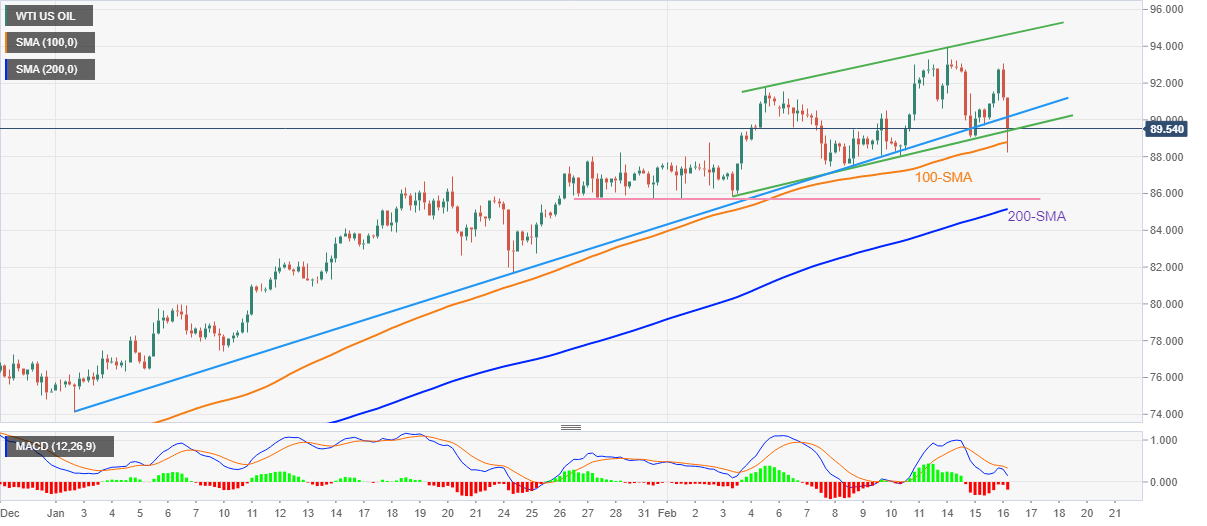
Trend: Further weakness expected
- The dollar index (DXY) was pressured on Wednesday.
- FOMC minutes disappoint vs. the uber hawkish rhetoric of late from Fed officials.
The index slid to a low of 95.67 when the Federal Open market Committee minutes disappointed investors who had been in anticipation of more hawkish language in the discussions at the January meeting between board members.
While the Federal Reserve still thinks inflation will come down and that there was no discussion of a 50bp hike, it was unlikely that the minutes would have pointed to the 50bps solution. The minutes were from a meeting held before the release of strong payrolls and the hot Consumer Price Index. Nevertheless, the policymakers are still not set on a particular pace of interest rate hikes and decisions thereof would depend on a meeting-by-meeting analysis of data.
In contrast, voting member and known hawk, St. Louis Fed President James Bullard, reiterated calls for a faster pace of Fed rate hikes. At the Fed's Jan. 25-26 meeting, the board agreed that it would "soon be appropriate" to raise the Fed's benchmark overnight interest rate from its near-zero level, so March remains to be a live meeting.
As for the geopolitical risks, the United States and NATO are warning that Russia was still building up troops at the border of Ukraine, contradicting Moscow's insistence it was pulling back:
-
US State Department: Russian military moving concerningly into fighting positions
A US Senior Administration Official has in recent trade announced that Russia has increased troops near Ukraine by up to 7,000. The stream of disappointing headlines is continuing to sink USD/JPY which now trades at 115.33.
US inflation expectations, as measured by the 10-year breakeven inflation rate per the St. Louis Federal Reserve (FRED) data, add to the market’s anxiety by recently easing from the highest levels since January 12.
In doing so, the inflation precursor fade the previous rebound from the three-month low, marked in late January, with the latest pullback from 2.48% to 2.46%.
It’s worth noting that the recent easing in inflation expectations joins the mixed comments from the latest Federal Open Market Committee (FOMC) Minutes as the policymakers backed rate hikes but showed no confirmations over the pace of it. “Federal Reserve officials agreed last month that it was time to tighten monetary policy, but also that decisions would depend on a meeting-by-meeting analysis of data, according to minutes of the most recent policy meeting,” reported Reuters.
Given the unclear FOMC Minutes and recently downbeat US inflation expectations, markets are likely to witness further grinding. The same could restrict the moves of the US Treasury yields, equities and the US dollar while benefiting the traditional safe-havens like gold.
Read: Gold Price Forecast: XAU/USD rebound aims $1,880 amid geopolitics, Fed-linked anxiety
- Gold prices edge higher after refreshing eight-month top, recent recovery eyes important resistance.
- Risk appetite remains fragile amid indecision over Russia-Ukraine, Fed.
- Yields curve steepens, equities closed mixed and DXY weakened.
- Gold Price Forecast: Resuming the advance ahead of FOMC Minutes
Gold (XAU/USD) prices keep the previous day’s rebound from a weekly low to around $1,870 during the initial Asian session on Thursday.
In doing so, the yellow metal benefits from the market’s uncertainty over the de-escalation of Russia-Ukraine tension and the pace of the Fed’s March rate hike.
Softer comments from Moscow seem to ease the tension surrounding the invasion of Ukraine. However, the West and some of the Ukrainian sources reject the Russian troops’ retreat. On the other hand, the latest update from an Estonian diplomat suggests that Russia moves more military battalions towards the area near Ukraine and has also built a road and working on a bridge to soften the transport.
On other hand, the Federal Open Market Committee (FOMC) Minutes showed the hawkish concerns among the board members even if marking no strong support for a 0.50% rate hike in March. “Federal Reserve officials agreed last month that it was time to tighten monetary policy, but also that decisions would depend on a meeting-by-meeting analysis of data, according to minutes of the most recent policy meeting,” reported Reuters.
Talking about the data, US Retail Sales and Industrial Production rose notably beyond the market forecasts and previous readouts with the latest MoM figures of 3.8% and 1.4% respectively in January.
Amid mixed concerns, Wall Street failed to keep the previous day’s gains, closing mixed by the day’s end, whereas the US 10-year Treasury yields grind higher around multi-day tops, down 0.5 basis points (bps) to 2.04% at the latest. Further, the US Dollar Index (DXY) dropped for the last two days to refresh the weekly low.
Moving on, the second-tier US economics, mainly the housing market numbers, jobless claims and Philadelphia Fed Manufacturing Survey, may entertain gold traders. However, major attention will be given to the key risk catalysts, namely the Russia-Ukraine update and Fed-linked chatters.
Read: Fat or flat: Gold price in 2022
Technical analysis
Gold prices eased earlier in the week on RSI divergence and failure to offer a decisive close beyond November 2021 high.
However, the metal’s inability to conquer the January month high of $1,853 during the declines joins firmer MACD signals to redirect gold buyers towards the $1,880 key hurdle.
Should the quote cross the $1,880 resistance, the $1,900 threshold and late 2021 peak of $1,917 will return to the chart.
Alternatively, an upward sloping trend line from February 03, near $1,840, will act as an extra filter to the south even if the gold sellers manage to break January’s peak surrounding $1,853.
It’s worth noting that the 200-DMA and a two-month-long support line, close to $1,807 and $1,797 in that order, act as additional downside filters to challenge the gold bears.
Overall, gold is likely to grind higher but the buyers have a bumpy road to the north.
Gold: Daily chart
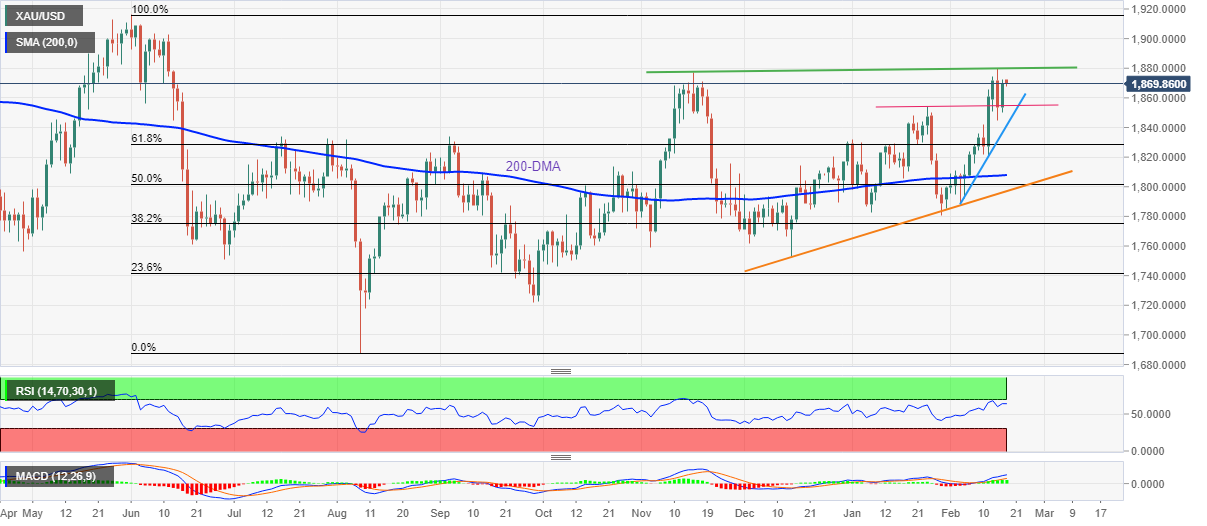
Trend: Further recovery expected
- USD/CAD rebounds from weekly low after three-day downtrend.
- MACD signals don’t favor bulls, 1.2625 becomes the key support.
- Recovery remains elusive below six-week-old resistance line.
USD/CAD licks its wounds around the weekly bottom, recently recovering to 1.2690 during Thursday’s Asian session.
In doing so, the quote portrays a corrective pullback from an upward sloping support line from January 26.
However, the MACD conditions aren’t supporting rebound, which in turn challenge the buyers until the quote crosses a six-week-long resistance line, near 1.2780 by the press time.
During the rise, the 1.2750 level may act as an intermediate halt whereas January’s peak surrounding 1.2815 will act as an extra filter to the north.
On the contrary, a downside break of the stated immediate support line, near 1.2670, isn’t a green card for the USD/CAD sellers as a convergence of the 100-DMA and 50% Fibonacci retracement (Fibo.) of October-December 2021 upside will be a tough nut to crack for the pair bears around 1.2625.
Also acting as strong downside support is the 61.8% Fibo. and the 200-DMA, respectively around 1.2545 and 1.2538 by the press time.
USD/CAD: Daily chart
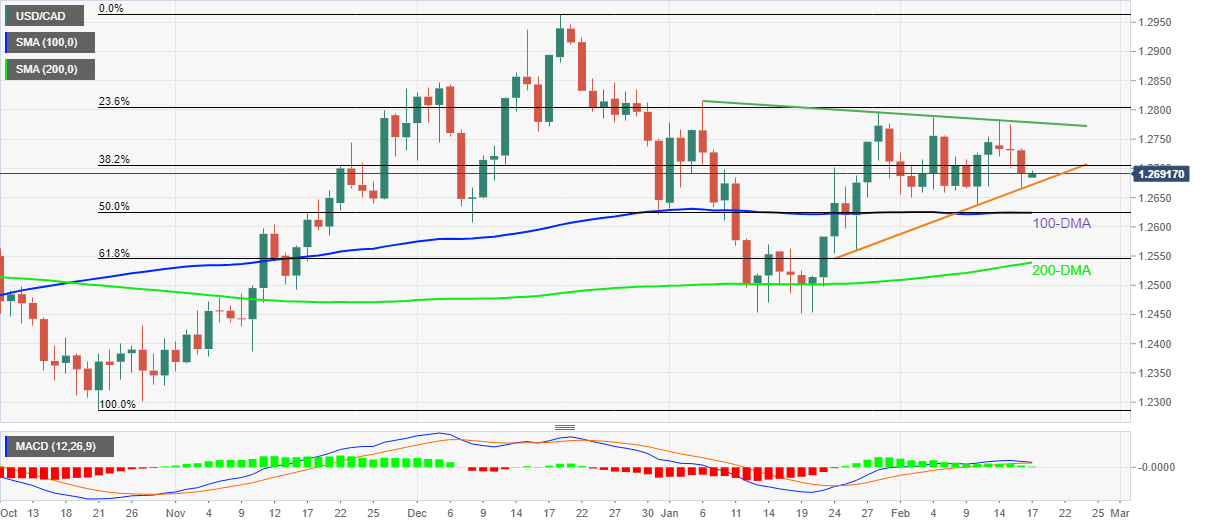
Trend: Sideways
- The common currency has gained 0.30% in the week, vs. the Japanese yen.
- Raising geopolitical tensions could exacerbate a downward move, despite the neutral-upward bias, on the safe-haven status of the JPY.
- EUR/JPY Technical Outlook: Downward bias, confirmed by a “gravestone doji” on the daily chart.
The EUR/JPY advances for the second consecutive day in the week amid a mixed market mood as Russia/Ukraine conflict tension increases. At the time of writing, the EUR/JPY is trading at 131.30
On Wednesday, during the overnight session, the EUR/JPY cross-currency pair rallied towards Pitchfork’s 25% parallel line around the 131.50-60 range, reaching a daily high at 131.89, retreating below the former, end even pushing below the February 15 daily high at 131.58. Therefore, it printed a “gravestone doji,” a candlestick meaning that a EUR/JPY reversal may be on the cards.
EUR/JPY Price Forecast: Technical outlook
Therefore, the EUR/JPY first support level would be the February 16 daily low at 131.10. Breach of the latter will expose a previously broken four-month-old downslope trendline around 130.50-60, followed by the confluence of Pitchfork’s bottom trendline and the 200-day moving average (DMA) at 130.44.
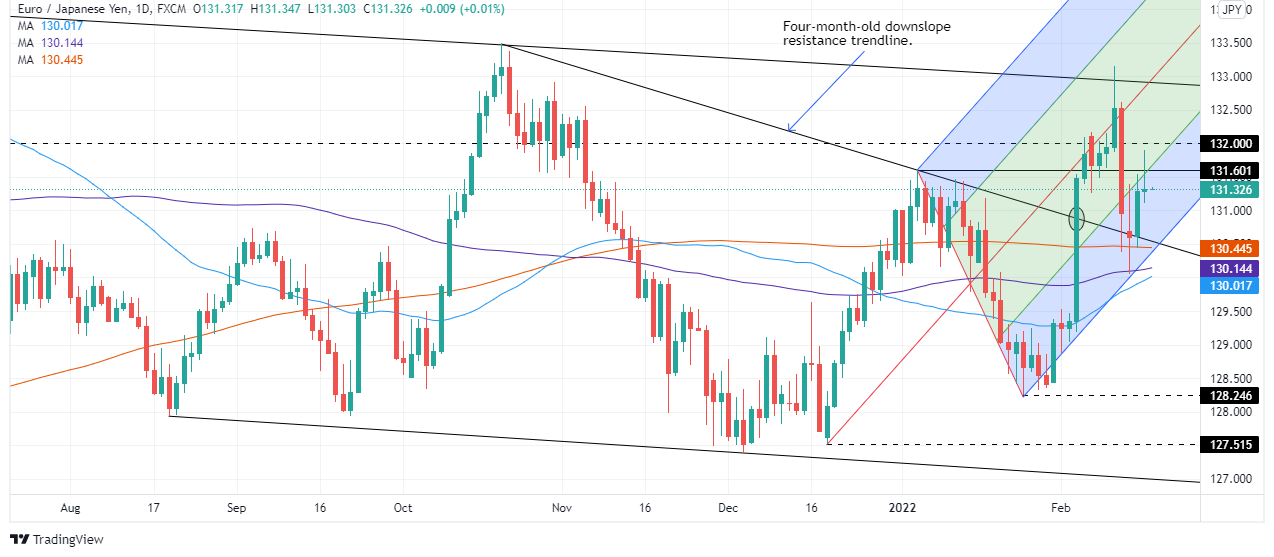
Trend: Downward biased unless the 132.00 level is reclaimed.
- AUD/USD grinds higher at weekly top after two-day uptrend.
- Market sentiment dwindles amid lack of clarity over geopolitics, Fed concerns but softer USD favors riskier assets.
- Equities edge lower, yields seesaw around recent tops but gold stays firmer.
- Softer Aussie employment data for January may trigger consolidation of recent gains on RBA’s hesitance to support rate-hike.
AUD/USD bulls take a breather around a one-week high near 0.7200, after rising for the last two consecutive days to Thursday morning in Asia.
The risk barometer pair’s previous gains could be linked to the US dollar weakness and a pause in the further Russia-Ukraine tension, even if the de-escalation is doubted. Also favoring the quote were upbeat Aussie data and firmer gold prices.
Although recently softer comments from Moscow seem to ease the tension surrounding the invasion of Ukraine, the West and some of the Ukrainian sources reject the Russian troops’ retreat. On the other hand, the latest update suggests that Russia moves more military battalions towards the area near Ukraine and has also built a road and working on a bridge to soften the transport.
On the other hand, US Retail Sales and Industrial Production rose notably beyond the market forecasts and previous readouts with the latest MoM figures of 3.8% and 1.4% respectively in January. Further, the Federal Open Market Committee (FOMC) Minutes also showed the hawkish concerns among the board members even if marking no strong support for a 0.50% rate hike in March. Hence, the US Dollar Index (DXY) dropped for the last two days to refresh the weekly low.
It should be noted that Australia’s January Westpac Leading Index rose 0.13% versus the previous reading of 0% whereas China’s inflation figures eased for the said month.
Amid these plays, Wall Street failed to keep the previous day’s gains, closing mixed by the day’s end, whereas the US 10-year Treasury yields grind higher around multi-day tops, down 0.5 basis points (bps) to 2.04% at the latest.
That said, the AUD/USD traders will pay attention to today’s Australia Employment Change and Unemployment Rate figures for January for clear direction. Forecasts suggest that the Employment Change to print 0K figures versus 64.8K prior whereas the Unemployment Rate may remain unchanged at 4.2K. Given the downbeat market consensus and the Reserve Bank of Australia’s (RBA) repeated resistance to back the rate-hike environment, the pair may witness a pullback in case of softer numbers.
Technical analysis
A daily closing beyond the 50-DMA, near 0.7170 by the press time, joins firmer RSI and MACD signals to direct AUD/USD buyers towards the 0.7235-45 key resistance area comprising the 100-DMA and a descending trend line from early November.
- GBP/USD bulls reaching up to the daily resistance.
- Bulls will be monitoring for a slow down in the hourly bearish correction.
GBP/USD rallied to a fresh hourly high son Wednesday following a sell-off in the greenback on the back of a less hawkish outcome at the Federal Reserve's meeting in January.
The minutes of the meeting did not underscore the possibility of a 50bps hike at the March meeting which knocked some wind out of the US dollar and yields. Meanwhile, the following illustrates the market structure from an hourly, 15-minute and daily perspective:
GBP/USD H1 chart
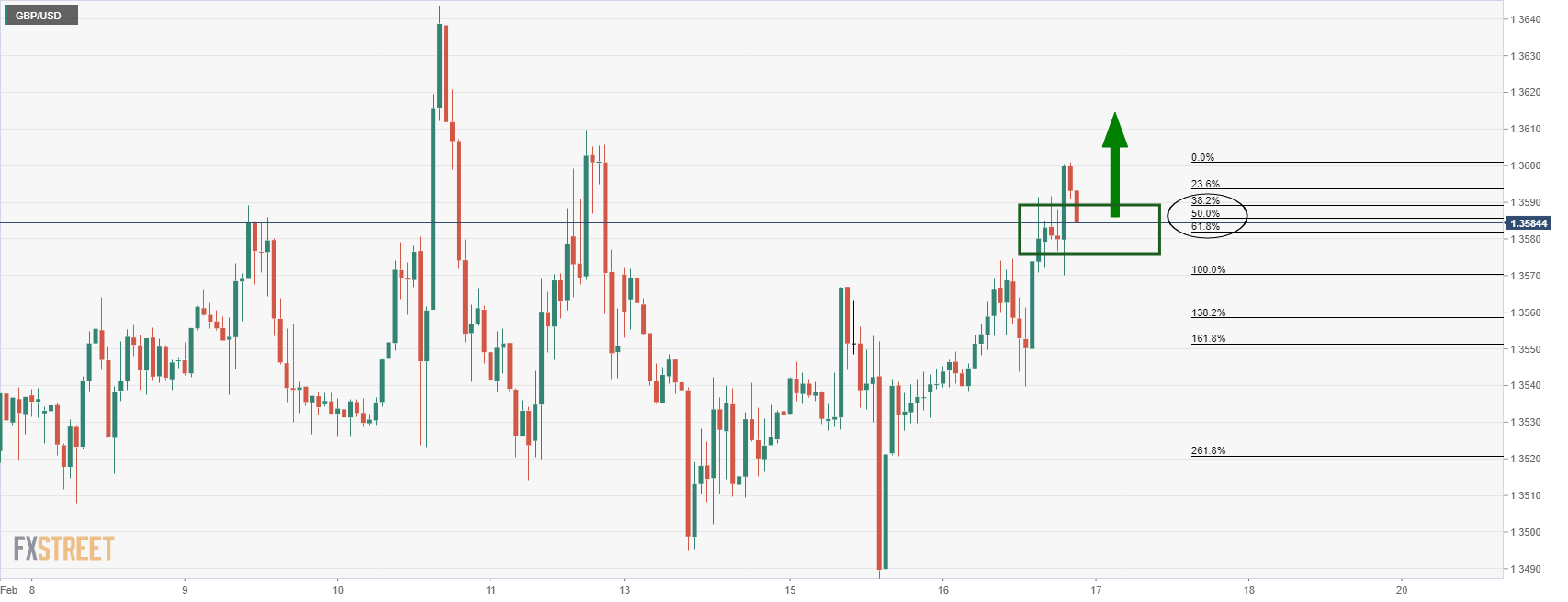
GBP/USD M15 chart
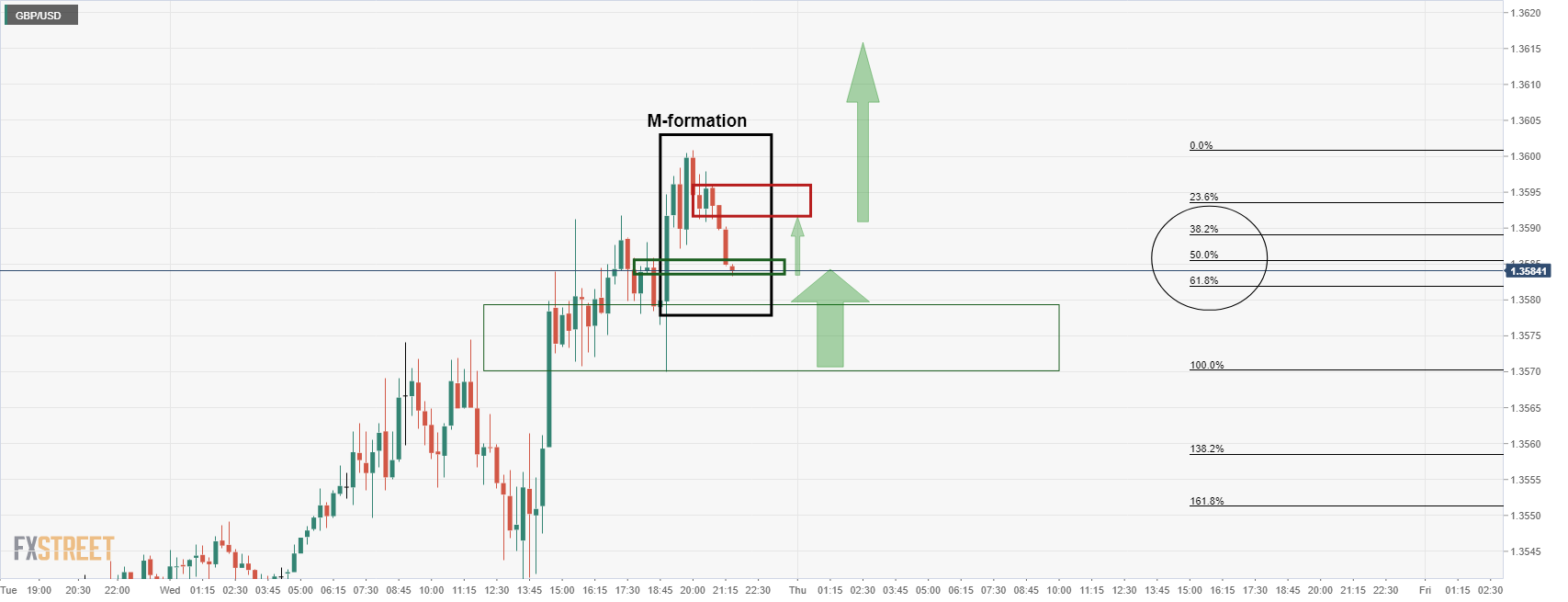
There are some 15-min structures that have taken shape, potentially offering support as illustrated above with the bias to the upside should the levels hold up.
GBP/USD daily chart
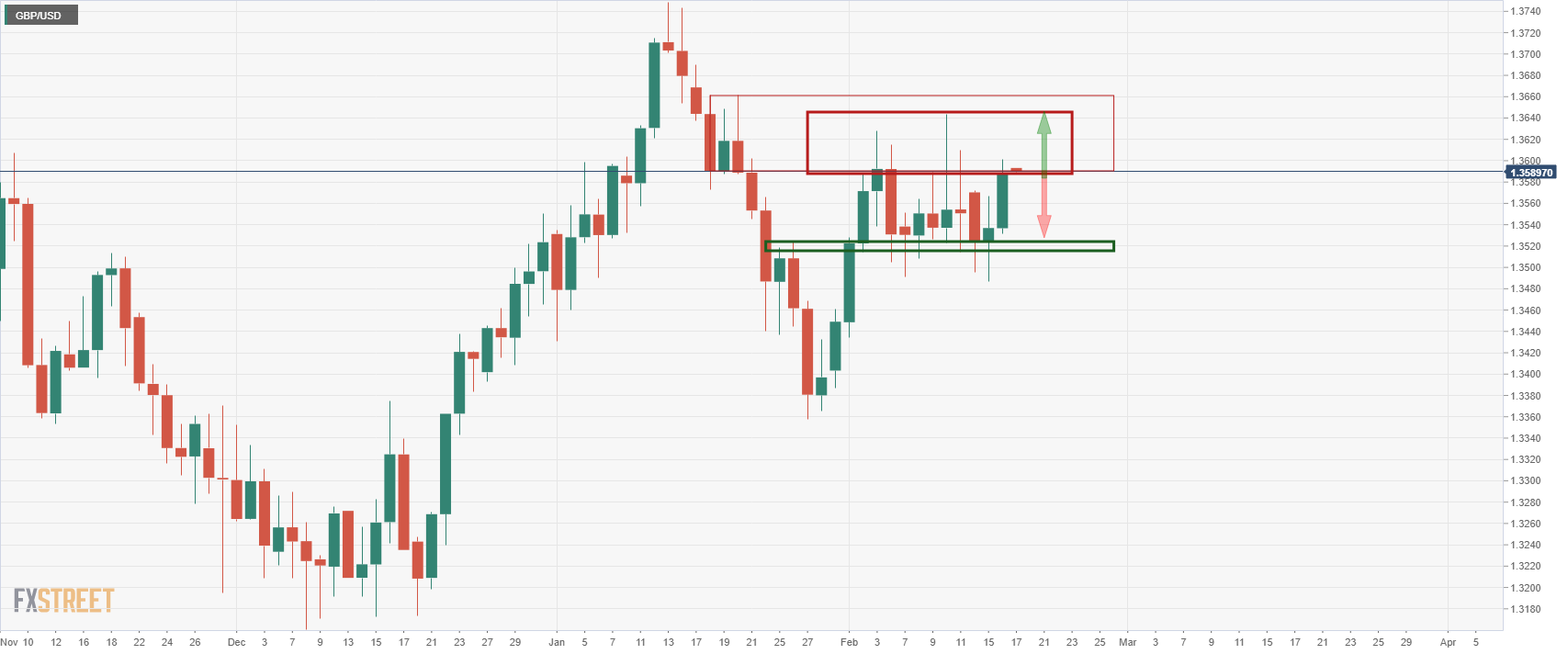
Meanwhile, the daily outlook is somewhat trapped around 1.3520 and 1.3650 from which scapers will be able to lean against as boundaries to trade within for the forth coming sessions.
- The shared currency advances 0.15% in the day.
- Geopolitical jitters appeared to be “ignored” by EUR/USD traders, which boosted the EUR.
- EUR/USD Technical Outlook: Neutral, but subject to up or down breaks, as it remains trapped between the 50 and the 100-DMA.
During the North American session, the shared currency extended its rally, so far up 0.40% in the week, amid uncertainty in the Russia/Ukraine conflict. At the time of writing, the EUR/USD is trading at 1.1379.
Russia/Ukraine conflict headlines dominate the session
The conflict between Russia and Ukraine has kept the market mood continuously swinging since last Friday, putting macroeconomic data aside. On Tuesday, Russian officials reported the withdrawal of troops near the border of Ukraine. However, developments in the last couple of hours suggested that ten new Russian battlegroups approached the border, as reported by Estonian and Ukraine intelligence, according to Reuters.
Fed minutes telegraph a rate hike “soon” but would be data dependant, perceived as dovish
In the meantime, the Federal Reserve released its January meeting minutes. The minutes revealed that the US central bank would end the QE by March, as scheduled on the December meeting. Also, Fed policymakers would like to remove policy accommodation faster than they anticipate and “soon” would like to raise the Federal Funds Rate (FFR).
However, the Committee emphasized that they would remain data-dependent and track the economic and financial developments. It is worth noting that Fed officials noted that “risks to inflation were weighed to the upside,” as reported by Reuters.
Back to the EUR/USD, the pair reacted upwards, to 1.1395, but geopolitical jitters put a lid on the move, retreating afterward to the 1.1380 area.
EUR/USD Price Forecast: Technical outlook
The EUR/USD remains neutral biased, trading within the 50 and the 100-day moving averages (DMAs) lying at 1.1328 and 1.1403, respectively. That said, any up/down break of the DMAs above can provide EUR/USD traders with a clear trend.
That said, if EUR buyers reclaim the 100-DMA, that will open the door for further gains. The EUR/USD first resistance would be February 11 daily high at 1.1430, followed by February 4 high at 1.1483 and the February 10 YTD high at 1.1494.
On the flip side, the break of the 50-DMA would send the EUR/USD towards 1.1300. Breach of the latter would expose December 15, 2021, 1.1221 daily low, followed by 1.1200.
The Chief of UK Defence Intelligence Jim Hockenhull said on Wednesday that, contrary to Russia's claims, it has continued to build up its military capabilities on the Ukrainian border and we have not seen any evidence that Russia has withdrawn troops, according to Reuters. Reuters said that public comment from Hockenhull is "rare".
Market Reaction
The commentary from UK intelligence is in fitting with commentary from the US and various Eastern NATO members, as well as Ukrainian officials, and is keeping investors nervous, though there hasn't been any reaction to the latest headlines.
- WTI has been selling off sharply in recent trade on headlines suggesting that a US/Iran nuclear deal is near.
- A deal that saw US sanctions on Iranian oil exports removed could add well over 1M BPD to global markets.
- WTI has fallen $2.0 in the last hour and is now down $3.50 from earlier session highs near $95.00.
Oil has been selling off sharply in recent trade as headlines pick up regarding a possible deal between the US, Iran and other world powers that would revive the 2015 nuclear pact and end US sanctions on Iranian oil exports. Front-month WTI futures have slipped more than $2.0 in the last hour and are now down more than $3.50 versus earlier session highs near $95.00. On the day, WTI is now just over 50 cents lower. WTI will now be eyeing a test of support in the form of a long-term uptrend that has been in play all year so far, with any break below likely to be followed by a swift drop back under $90.00 and towards support in the $88.00s.
Iran's top nuclear negotiator Ali Bagheri Kani tweeted on Wednesday that, following weeks of intensive talks, the JCPOA participants including the US and Iran are closer than ever to an agreement. Shortly after Kani's tweet, the US State Department said that the US is in the midst of the very final stages of talks with Iran reviving the 2015 nuclear deal. A deal would open the door for well over 1M barrels per day in addition Iranian exports to return to global markets.
While chatter about an imminent return to the 2015 nuclear deal and return of Iranian supply will likely weigh on markets in the short-term, analysts said, Russia/Ukraine tensions remain another wildcard. The latest headlines on this front have not been positive, with government and intelligence officials in the US and various NATO nations warning that there is no evidence yet that Russia is reducing its military presence on Ukraine’s border. Intelligence officials have been warning about the risk that a limited attack in Eastern Ukraine’s Donbas region remains a distinct possibility.
- NZD/USD soars above the hawks of the FOMC and the US dollar is under pressure.
- Ears are to the ground for headlines surrounding Russia and NATO diplomacy.
- Bulls target the 50% mean reversion level through 0.67 the figure and the 61.8% golden ratio is sat near 0.6750.
NZD/USD is reaching fresh corrective highs in the pursuit of the weekly wick as illustrated below. The kiwi is printing a high of 0.6691 following a rally from the lows of 0.6633.
The US dollar is bleeding out some of the 50bps rate hike premium that speculators had drilled into the markets in anticipation of the Federal Reserve's March meeting. This has followed a less than satisfying set of Federal Open Market Committee minutes released on Wednesday mid-afternoon, clipping the wings of the hawks that have been circling over the Fed March meeting.
The FOMC minutes from the January meeting noted that inflation was high and policy tightening was warranted soon, adding:” Most participants noted that, if inflation does not move down as they expect, it would be appropriate for the Committee to remove policy accommodation at a faster pace than they currently anticipate”.
On Fed's holdings of bonds: ”The Committee expects that reducing the size of the Federal Reserve's balance sheet will commence after the process of increasing the target range for the federal funds rate has begun”. However, there was no confirmation that a 50 basis point hike was being considered and that was disappointing enough to derail the US dollar further.
The greenback has already been suffering from a steadier risk tone in financial markets despite the contracting sentiment surrounding Russian troops at the border of Ukraine. Instead, markets are clinging t hopes of diplomacy and the newswires that are creating hopes that the Ukraine situation will be de-escalated. Meanwhile, there is no local data for New Zealand today, so it will be all ears to the ground for further news related to the Russian/NATO standoff.
NZD/USD technical analysis
As per the prior analysis, NZD/USD bulls eye the 0.6650's and 6690's on Russia's withdrawal of troops, the price has reached the 0.6690's target in Wall Street's trade on Wednesday:
It was noted that ''the price had been creeping in on the old support turned to resistance but the prospects of a downside continuation were thwarted in New York's trade when the price broke to fresh corrective highs:

This leaves the bulls in play and there are prospects of a surge into the imbalance left between 0.6690's and the 0.6650's for the days ahead.''
NZD/USD live market
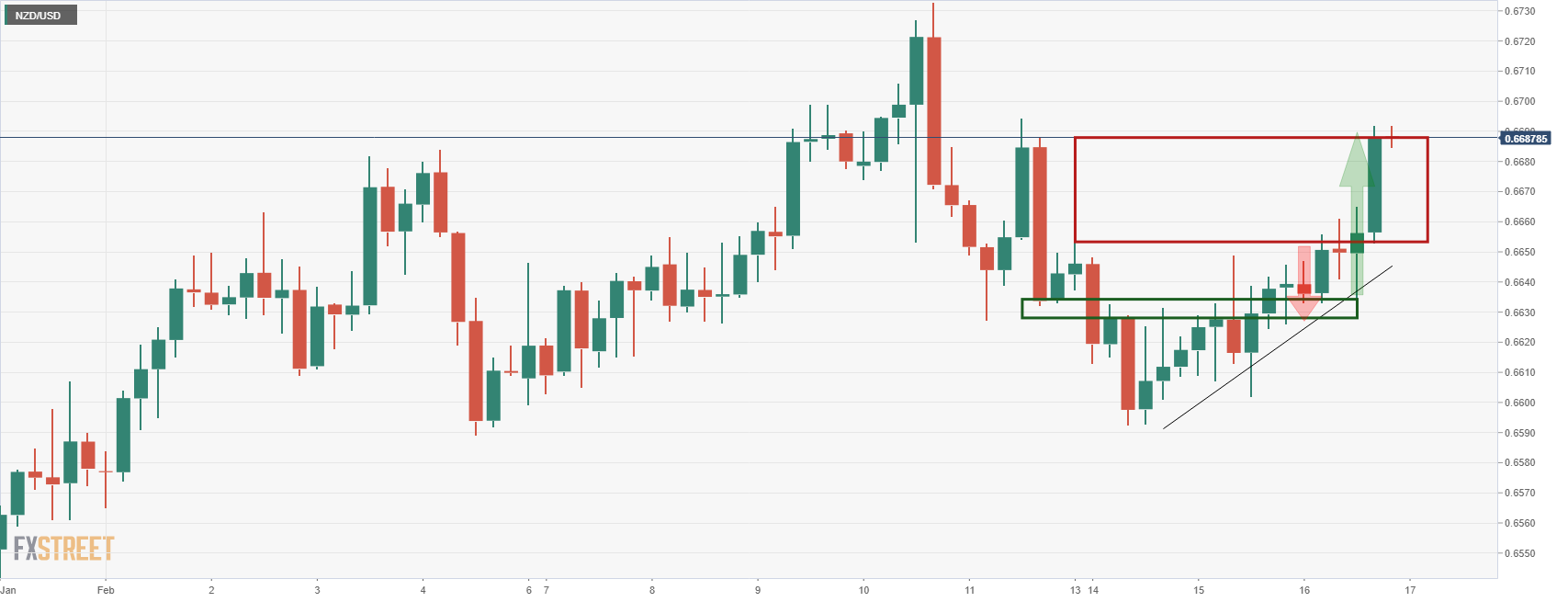
As illustrated, the price has continued in the forecasted trajectory. However, noting the weekly wick, there are prospects for higher still, as follows:
NZD/USD weekly chart
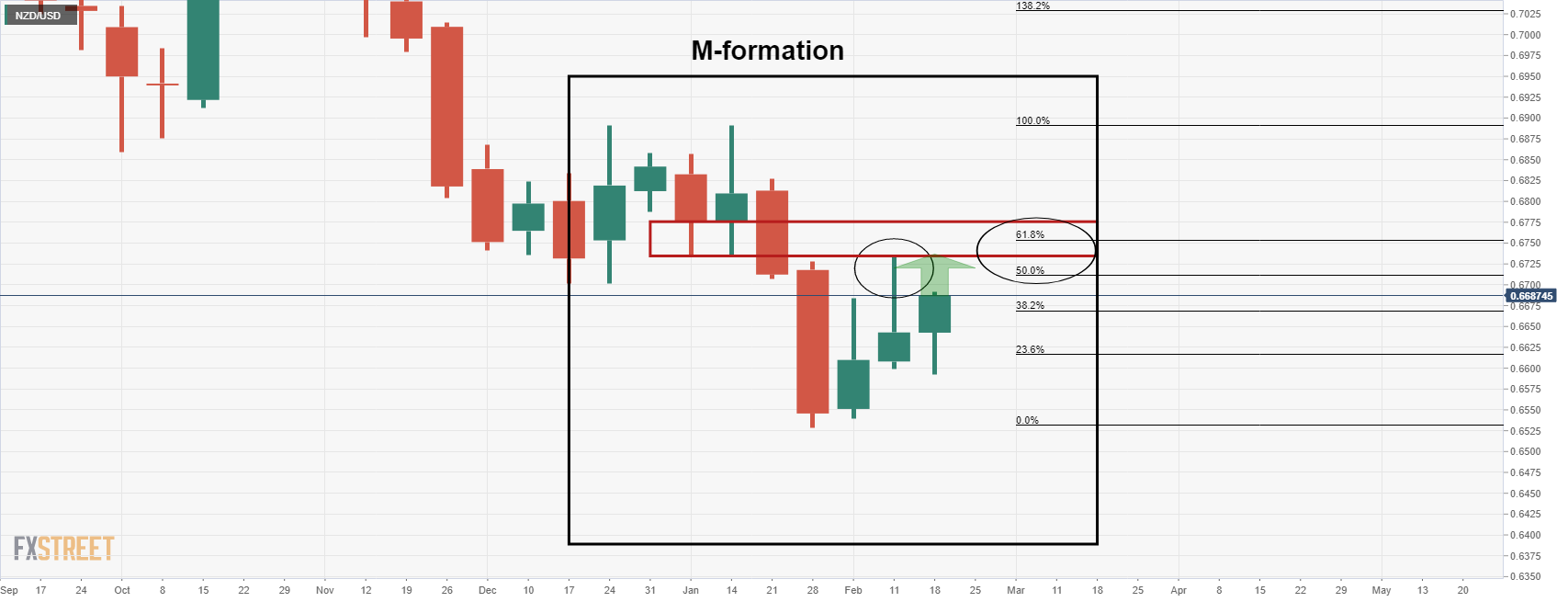
The price could now be destined to fill in the prior week's wick, mitigating the price imbalances on lower time frames and in turn completing a correction to the M-formation's neckline. Moreover, the price would be expected to retrace to a 50% mean reversion level through 0.67 the figure if not embark on a full retracement to the 61.8% golden ratio near 0.6750.
What you need to know on Thursday, February 17:
The American dollar edged lower on Wednesday, despite the release of upbeat US data and uncertainty related to Russian and Ukrainian border tensions. Also, the US Federal Reserve released the Minutes of the latest FOMC meeting, which indicated that policymakers are willing to hike rates but did not mention a 50 bps move in March.
US Retail Sales were up 3.8% in January, much better than anticipated, while Industrial Production in the same month surged by 1.4% vs the 0.4% expected.
Regarding geopolitical tensions, the latest on the matter was the Estonian Foreign Intelligence Service chief reporting that Russia was moving some 10 battle groups towards the area near Ukraine, where more groups are already awaiting.
European indexes closed in the red with modest losses. Wall Street spent most of the day in the red but managed to recover post-FOMC Minutes now mixed around their opening levels.
Government bond yields remained up the upper end of their weekly range, with the yield on the US 10-year Treasury note hovering around 2.05%.
EUR/USD trades around 1.1390, while GBP/USD flirts with 1.3600 amid the broad dollar's weakness. The AUD/USD pair is also up, trading around 0.7200, while USD/CAD lags, hovering around 1.2670. Weaker oil prices limit the CAD as the black gold retreated sharply from its daily high and trades around $92.50 a barrel.
Iran's top nuclear negotiator Ali Bagheri Kani tweeted that, following weeks of intensive talks, the JCPOA participants, including the US and Iran are closer than ever to an agreement. However, he added that "nothing is agreed until everything is agreed."
Safe-haven currencies managed to advance against the greenback, with USD/CHF down to 0.9210.
Gold edged higher and trades at around $1870 a troy ounce.
Cardano Price Prediction: ADA readies for another run to $1.30
Like this article? Help us with some feedback by answering this survey:
Iran's top nuclear negotiator Ali Bagheri Kani tweeted on Wednesday that, following weeks of intensive talks, the JCPOA participants including the US and Iran are closer than ever to an agreement. However, he added that "nothing is agreed until everything is agreed". His tweet comes after French officials had said earlier in the day that a decision on salvaging the 2015 nuclear pact between Iran and major world powers was just days away and it was up to Iran.
Shortly after Kani's tweet, the US State Department said that the US is in the midst of the very final stages of talks with Iran reviving the 2015 nuclear deal. The State Department added, however, that they were not expecting a direct meeting between US Secretary of State Anthony Blinken and Iran's foreign minister.
Market Reaction
Oil prices have been falling sharply in recent trade on the prospect that a deal would eliminate US restrictions on Iranian crude oil exports, thus allowing well over 1M barrels per day in addition supply onto global markets. Front-month WTI futures have tumbled all the way below $92.50 from previously trading in the upper-$93.00 area just a few minutes ago.
- The British pound vs. the Japanese yen is up in the week 0.29%.
- US officials and Estonian intelligence confirm the movement of Russian troops to Ukraine’s border, per Reuters.
- GBP/JPY Technical Outlook: If GBP bulls achieve a daily close above 156.81, a move towards 157.00 is on the cards.
The British pound edges higher for the second straight day, amid a risk-off market mood courtesy of Russian/Ukraine headlines crossing the wires. At the time of writing, the GBP/JPY is trading at 156.90.
The financial market mood remains sour on increased geopolitical tensions. US equity indices trade in the red, while in the FX space, risk-sensitive currencies appear to be unaware of the recent developments in the last hour.
Following the Federal Reserve monetary policy minutes release, around 19:15 GMT, Estonian intelligence reported that Russia is moving ten new battle groups to Ukraine’s border, per Reuters. A couple of minutes afterward, the US State Department confirmed that more Russian forces, not fewer, are on the Ukraine border and moving into fighting positions.
Putting the geopolitical jitters aside, the GBP/JPY seesaws in the 156.40-157.00 range for the last couple of days. Even though the GBP posted gains, the average daily range (ADR) of the last two days shrank from 112 to 50 pips.
GBP/JPY Price Forecast: Technical outlook
The GBP/JPY is upward biased, as shown by the daily chart. On Wednesday, the GBP/JPY reclaimed so far, the February 15 daily high at 156.81, and if it prints a daily close above of it, it could pave the way for further gains.
Upside, the GBP/JPY first resistance would be 157.00. Breach of the latter would expose a five-month-old downslope trendline around the 157.30-45 area that, once cleared, would exacerbate a move towards 158.00.
On the flip side, the GBP/JPY first support would be February 4 daily high previous resistance-turned-support at 156.47, followed by 156.00 and the February 14 daily low at 155.29.
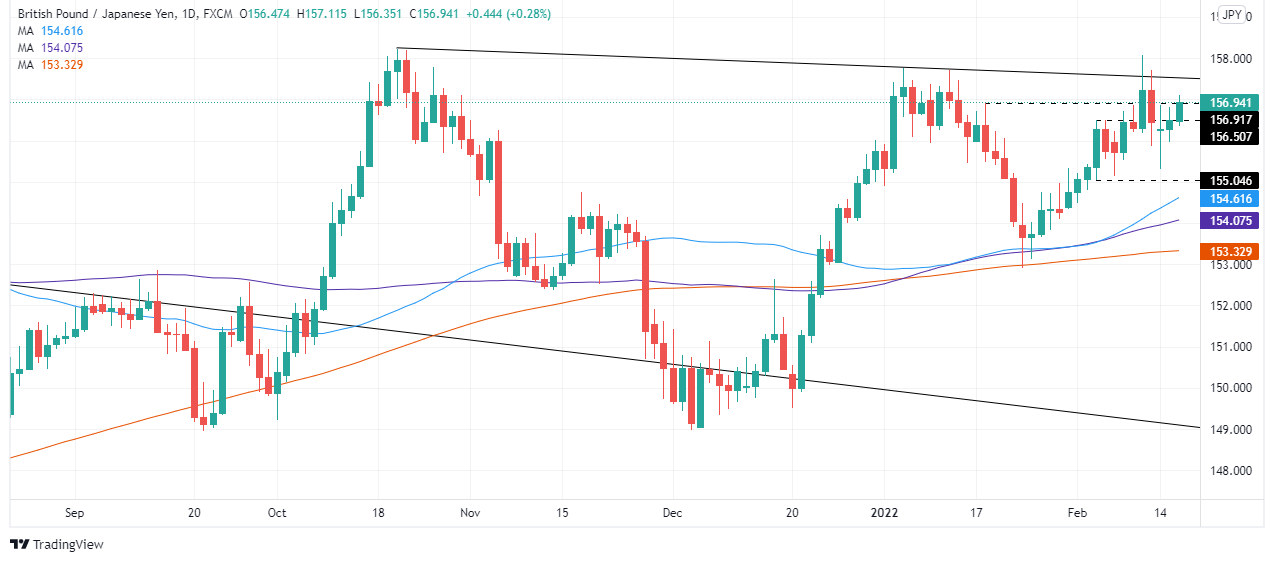
- The S&P 500 is flat, having rebounded to around 4470 in wake of “dovish” Fed minutes despite negative geopolitical headlines.
- The index had been trading lower prior to the minutes release after hot US Retail Sales bolstered Fed tightening bets.
The release of the Fed minutes of the January 25-26 meeting followed shortly thereafter by a flurry of headlines relating to US/NATO concerns about continued Russian military build-up on Ukraine’s border has made for choppy US equity market trading conditions. Markets seem to have interpreted the minutes as dovish, helping spur a rebound from earlier session lows. The S&P 500 now trading in the 4470 area and close to session highs at 4480 where it trades flat on the day, having previously been as low as the 4430 mark, where it at the time was trading down by about 0.8%. A stronger than expected US January Retail Sales report on Wednesday released prior to the US open was said to have been weighing on stocks earlier in the session as it boosts the likelihood of a more aggressive Fed.
The minutes of the last Fed meeting did not seemingly indicate any desire to lift rates at a faster than usual pace of 25bps per minute, which may explain the dovish market reaction. Indeed, US money markets have revised lower the implied odds of a 50bps move at next month’s meeting to about 44% versus nearly 60% on Tuesday. However, analysts have noted that the latest upside Consumer and Producer Price Inflation surprises have likely rendered the opinions seen in the latest minutes release as out of date. Recall that in wake of the release of the January CPI report, Fed policymakers (and 2022 voter) James Bullard said he had become much more hawkish.
That is to say, perhaps stock markets shouldn’t read too much into the latest minutes release, and should pay more attention to what Fed members are saying right now, with their comments reflective of the most recent economic developments. On which note, there is plenty of Fed speak on Thursday and Friday. While the Fed minutes release has distracted attention momentarily from further negative geopolitical headlines, investors may soon start fretting about Russia/Ukraine war risk.
Shortly after the Fed minutes were released, US officials were again on the wires warning that despite Russia pledged to partially withdraw troops from the Ukraine border, it is actually seeing a build-up. Ukrainian and Estonian intelligence reports on Wednesday have concurred with this analysis, with the intelligence chief of the latter recently saying that 10 new Russian battlegroups were moving to the Ukraine border to join the 100 already there. The intelligence chief echoed US warnings that an escalation to the fighting in the Eastern Ukraine breakaway provinces located in the Donbas is considered highly likely.
Looking back at US equities, the Nasdaq 100 index has swung within a 14.4-14.6K range and currently trades in the mid-14.5K area, down about 0.5% on the day. The Dow, meanwhile, has swung between the 34.7-35.0K levels and currently trades in the 34.8K area, down about 0.3% on the day. The S&P 500 CBOE Volatility Index (or VIX) is about one point lower and has dipped back under 25.0 again. Attention remains very much on the geopolitical situation.
The US State Department said that more Russian forces, not fewer, are on the Ukraine border and they're moving concerningly into fighting positions. However, they say there is still room for diplomacy unless they make the decision to go in.
More to come...
Estonia's Chief of Foreign Intelligence Mikk Marran said on Wednesday that Russia is moving a further 10 battle groups towards an area near Ukraine where 100 battle groups have already been deployed. The Foreign Intelligence Chief added that Russia is "likely" to launch a "limited" assault against Ukraine, occupying chunks of territory, with an escalation of fighting in the Eastern breakaway provinces "highly likely". The Intelligence Chief warned that Russian success in Ukraine would encourage it to pressure the Baltic states.
Market Reaction
With markets primarily focused on the recent Fed minutes release at the moment, the latest negative geopolitical headlines haven't dampened sentiment yet, with the S&P 500 having jumped about 30 points over the last 30 or so minutes to now trade flat again on the day. While it might be risk on right now given the dovish minutes, warnings of continued Russian escalation could soon recapture the focus and weigh on sentiment once more.
- GBP/USD pops to session highs on less hawkish than expected minutes.
- US dollar lowest level since Friday, but Russian headlines coming through could support.
GBP/USD is reaching highs of 1.3594 on Wednesday following the release of the Federal Open Market Committee minutes that failed to portray a message of 50bps worth of hiking as soon as the March meeting.
This was a number touted by the most hawkish of Fed officials and was being priced in by the markets. Consequently, the US dollar is being sold off. DXY, an index that measures the greenback vs a basket of major rivals, has printed a fresh low for the day of 95.692. This is the lowest level since Friday, Feb.11.
Meanwhile, sterling was higher across the board on Wednesday after data showed inflation in Britain at a nearly 30-year high. Markets are pricing in the convergence between the Fed and Bank of England as they suspect that the BoE will hike interest rates again. The BoE has hiked twice since December. Rates have risen to 0.5% from 0.1%. Another hike to 0.75% or 1% on March 17 after the BoE's next meeting is expected.
The data showed that the Consumer Price Index on an annual basis climbed to 5.5% in January. This was the highest since March 1992, and above expectations from economists for it to hold at December's 5.4%.
Reuters explained that ''soaring inflation across many global economies has sparked a debate about how fast central banks should rein in stimulus deployed earlier in the COVID-19 pandemic to prop up businesses and consumers.''
Meanwhile, there are plenty of risk-off Russian headlines coming through that could lead to a safe-haven bid in the greenback and curb the FOMC minutes decline. The US State Department said that more Russian forces, not fewer, are on Ukraine border and they're moving concerningly into fighting positions.
Bank of Canada Deputy Governor Timothy Lane said on Wednesday that it was quite likely that the central bank will be "saying something" about quantitative tightening at its next policy meeting in March. Lane added that while the BoC does not have to move in step with the Fed on rate hikes, what the Fed does certainly has a big impact on the economic conditions in which the BoC makes its own decisions. If the trucker's blockade is to persist, it might have an impact on the broader Canadian economy, Lane said, saying that he hopes the blockade won't last long.
Market Reaction
There has not been any reaction to the latest comments from Lane, with FX markets instead focused on the Fed minutes.
The minutes of the 25-26 January FOMC meeting, released on Wednesday, said that most participants suggested that a faster pace of increases in the target rate for the Federal Funds rate than in the post-2015 period would likely be warranted.
Additional Takeaways
As summarised by Reuters...
- Participants continued to stress that maintaining flexibility to implement appropriate policy adjustments on the basis of risk-management considerations should be a guiding principle.
- Participants continued to judge that the committee's net asset purchases should be concluded soon.
- Many participants noted the influence on financial conditions of the committee's recent communications and viewed these communications as helpful in shifting private-sector expectations regarding the policy outlook.
- Most participants preferred to continue to reduce the committee's net asset purchases according to the schedule announced in December, thus bringing them to an end in early March.
- Participants emphasized that the appropriate path of policy would depend on economic and financial developments and their implications for the outlook and the risks around the outlook.
- Most participants noted that, if inflation does not move down as they expect, it would be appropriate for the committee to remove policy accommodation at a faster pace than they currently anticipate.
- Some participants commented on the risk that financial conditions might tighten unduly in response to a rapid removal of policy accommodation.
- Removal of policy accommodation in the current circumstances depended on the timing and pace of both increases in the target range of the Federal Funds rate and the reduction in the size of the Federal Reserve's balance sheet.
- A couple of participants stated that they favored ending the committee's net asset purchases sooner to send an even stronger signal that the committee was committed to bringing down inflation.
- A number of participants commented that conditions would likely warrant beginning to reduce the size of the balance sheet sometime later this year.
- Some participants commented on the risk that financial conditions might tighten unduly in response to a rapid removal of policy accommodation.
- A few participants remarked that this risk could be mitigated through clear and effective communication of the committee's assessments of the economic outlook, the risks around the outlook, and the appropriate path for monetary policy.
- Participants anticipated that it would soon be appropriate to raise the target range for the Federal Funds rate.
- Many participants commented that sales of agency MBS or reinvesting some portion of principal payments received from agency MBS into treasury securities may be appropriate at some point in the future.
- Participants agreed that uncertainty regarding the path of inflation was elevated and that risks to inflation were weighted to the upside.
- A few participants noted that asset valuations were elevated across a range of markets, raising concern that major realignment could contribute to a future downturn.
- A few participants pointed to the possibility that structural factors that had contributed to low inflation in the previous decade may reemerge after pandemic abates.
- Uncertainty about real activity was also seen as elevated.
- Various participants noted downside risks to the outlook, including a possible worsening of the pandemic, the potential for escalating geopolitical tensions, or a substantial tightening in financial conditions.
- A couple of policymakers judged prolonged accommodative financial conditions could be contributing to financial imbalances. A couple of others thought elevated asset valuations might prove to be less of a financial stability threat.
- Many participants commented that they viewed labor market conditions as already at or very close to those consistent with maximum employment.
- A couple of participants commented that, in their view, the economy likely had not yet reached maximum employment.
- Various participants cited developments that had the potential to place additional upward pressure on inflation, including real wage growth in excess of productivity growth and increases in prices for housing services.
- Some policymakers saw emerging risks to financial stability from the rapid growth of crypto assets and decentralized finance platforms.
- Participants generally expected inflation to moderate over the course of the year as supply and demand imbalances ease and monetary policy accommodation is removed.
- Some participants remarked that longer-term measures of inflation expectations appeared to remain well anchored.
- Policymakers saw widespread evidence that the labor market was very tight.
Market Reaction
The immediate market response to the latest minutes release has been a dovish one, with the US Dollar Index falling to lows of the day around the 95.70 level from above 95.80 prior to the release.
- USD/CHF slides some 0.26% during the North American session.
- The pair remains range-bound at the 0.9220-60 region.
- USD/CHF Technical Outlook: Consolidated amid the lack of a catalyst to break the range.
The USD/CHF retreats from 0.9260 top of the range-bound 0.9220-60, approaching the bottom of the range, courtesy of risk-off market mood. At the time of writing, the USD/CHF is trading at 0.9221.
On Wednesday's overnight session for North American traders, the USD/CHF consolidated around the 0.9240-60 area, followed by a break of the 0.9240 intraday support, which accelerated the downward move towards the bottom of the range mentioned above.
USD/CHF Price Analysis: Technical outlook
The USD/CHF is neutral biased, despite the location of the daily moving averages (DMAs) that lies below the exchange rate. As witnessed by the candlesticks, intense selling pressure lies around the 0.9250-0.9300 area, as portrayed by the last eight candles in the daily chart, which show long wicks above the real bodies.
Therefore, the USD/CHF is neutral-downwards. The first support would be the 100-DMA at 0.9211. Breach of the latter would expose the 50-DMA at 0.9200, followed by the 200-DMA at 0.9171.
Upwards, the first resistance would be 0.9250-65 area. A decisive break would expose December 16, 2021, a daily high at 0.9294, followed by January 31 daily high at 0.9343.
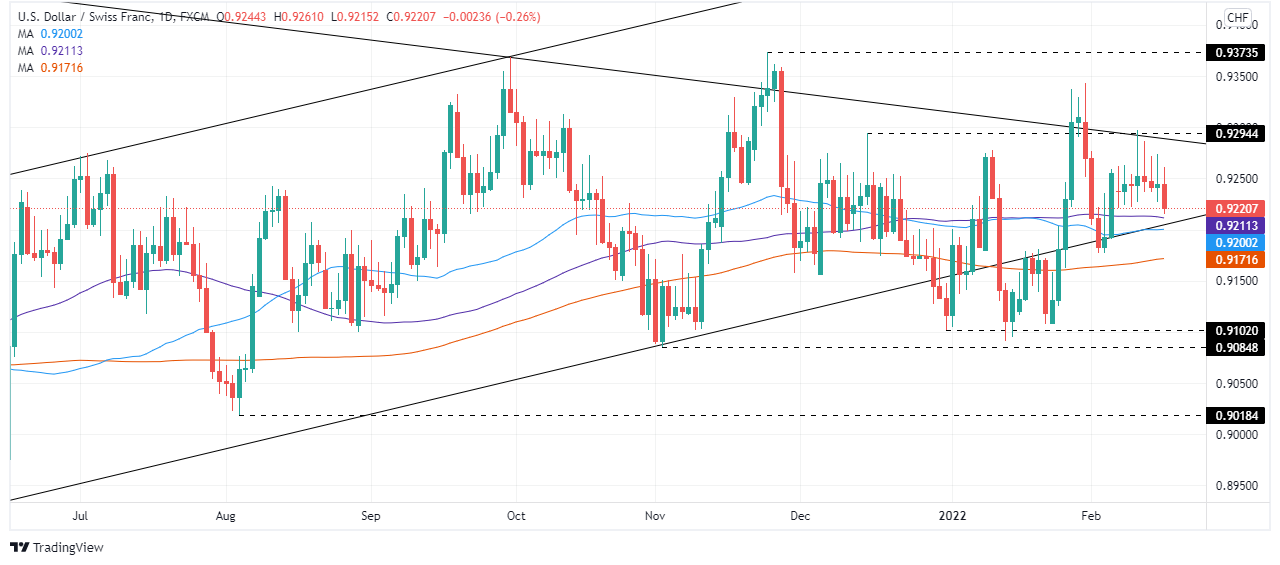
- EUR/GBP failed to hold above 0.8400 for a second successive session despite more hawkish recent ECB speak.
- The pair has pulled lower to the 0.8370s as another UK inflation surprise spurs bolsters BoE tightening bets.
- Traders are also watching Russia/Ukraine tensions, as a further increase could send EUR/GBP back under 0.8350.
EUR/GBP failed to reclaim the 0.8400 level again on Wednesday for the second time in two successive sessions, with the pair now trading down about 0.1% on the day in the 0.8370s and down about 0.3% versus earlier session highs. Another upside UK inflation surprise according to the latest ONS data released early during Wednesday’s European session has likely helped keep EUR/GBP a sell on rallies towards the 0.8400 level. The data keeps the pressure on the BoE to continue lifting interest rates in the near term.
However, concerns about longer-term UK growth as the country faces a much-publicised squeeze on incomes from April via higher taxes and energy bills, which is reflected in a UK yield curve getting ever closer to inversion, is dampening GBP’s appeal. That, combined with the increasingly hawkish lean to ECB speak from the likes of Isabel Schnabel and Francois Villeroy de Galhau in recent days is helping to prevent EUR/GBP from sliding back to test weekly lows in the 0.8350 area. Indeed, a drop to the 0.8360s attracted solid demand.
Ahead, the main driver of FX market sentiment, in general, is likely to remain geopolitics amid confusion about whether Russia is actually following through with its pledged partial withdrawal of troops from Ukraine’s border. Western/Ukrainian officials have been warning they do not see signs of de-escalation on the ground as of yet and further amping up of tensions could weigh on the euro again, sending it to fresh weekly lows under 0.8350.
Bank of Canada Deputy Governor Timothy Lane said on Wednesday that the central bank will be nimble and, if necessary, forceful in using its monetary policy tools to tackle inflation, according to Reuters. We are alert to the risk that inflation may again prove more persistent, he continued, adding that we must anticipate the possibility of more surprises before the pandemic ends. Currently, with inflation well above our target, Lane added, we are increasingly focused on countering the upside risks and, at different stages of the pandemic, we have changed our outlook and policy stance to respond to the uncertain and fast-changing situation. Lane reiterated that the BoC expects supply disruptions to ease and inflation to come down quickly in the second half of the year, adding that rates will need to be on a rising path.
Market Reaction
USD/CAD has not reacted to the latest hawkish leaning comments from BoC's Lane, which will do little to dampen speculation that the BoC could be tempted to lift interest rates by 50bps at its meeting next month.
- The AUD/USD extends its gains in the week, so far up 0.78%.
- Increasing tensions in the Russia/Ukraine conflict could not stop the rise of the risk-sensitive AUD.
- Fed’s Kashkari and Harker favor 25 bps “gradual” increases on fear of causing a recession.
- AUD/USD in the short-term is upward biased, but it would face strong resistance in the 0.7210-43 area.
During the North American session, the AUD/USD edges higher though barely short of weekly tops amid a risk-off market mood. At the time of writing, the AUD/USD is trading at 0.7186.
Failure of de-escalation in the Russia/Ukraine conflict dampened the market mood. Earlier in the European session, European bourses were trading in the green following Tuesday’s news that Russian troops were moving back, as reported by Russian authorities. However, the lack of confirmation by Western officials, led by US Secretary of State Blinken, who on Wednesday said that they continue to see critical Russian units moving towards the border and not away, shifted market participants’ sentiment.
Ukraine President Zelenskiy confirmed the headline above around 17:25 GMT, saying he doesn’t see Russian troops pull back.
Fed’s Kashkary and Harker favor “gradual” interest rates hikes
Around 16:00 GMT, Minnesota Fed’s President Neil Kaskari said that the US central bank could soften demand by hiking rates, but that won’t address the supply-side issues. He favors gradual rate hikes, and he sees inflation at 3% by the end of the year, in line with most forecasts. Kashkari sees a risk of recession if the Fed hikes too aggressive.
Later on the day, Philadelphia Fed President Patrick Harker said he supported a 25 bps increase to the Federal Funds Rate (FFR) in the March meeting. He said that “we need to do what we need to do to curb inflation but not overreact and possibly dampen an economy that is, in some ways, doing very well.”
Before Wall Street opened, the US economic docket featured Retail Sales for January. The headline came at 3.8% m/m higher than the 2% estimations, while the so-called core sales, which exclude gasoline and cars, rose by 3.3% m/m, crushing the 0.8% foreseen. Furthermore, US Industrial Production rose 1.4% m/m, better than the 0.4%, and Capacity Utilization jumped 77.6% from 76.60%, the highest jump in December 2021.
At 19:00 GMT, AUD/USD traders turn their attention to the FOMC monetary policy minutes, followed at 23:30 GMT, by the release of the Australian Employment report, which could shed some clues about what the RBA is going to do next.
AUD/USD Price Forecast: Technical outlook
On Wednesday, the AUD/USD has risen steadily since the beginning of the Asian session. Geopolitical headlines caused a minor dip, though at press time is trading at new daily highs, near the 0.7200 figure.
The AUD/USD is neutral biased but upwards in the short-term. The AUD/USD first resistance would be 0.7200. Breach of the latter would expose a three-month-old downslope trendline around 0.7210, followed by the 100-day moving average (DMA) at 0.7243.
We are still in a window where an attack by Russia against Ukraine could come at any time, the White House warned on Wednesday. An attack could be preceded by a false flag operation or misinformation as a pretext. The White House said it had no new information on attribution for the Ukraine cyber-attack and that the door continues to be open for diplomacy with Russia. The US has a range of options at its disposal if Luhansk is recognised as an independent republic, the White House added.
Market Reaction
There was no notable reaction to the latest comments from the White House as markets await the release of Fed minutes at 1900GMT.
- EUR/USD bulls taking on bearish commitments as euro defies gravity.
- The 61.8% ratio is within earshot, but bears are lurking.
As per a series of analyses this week, EUR/USD Price Analysis: Bulls eye 61.8% golden ratio, but bears are in the slipstream, and EUR/USD bulls tread around with caution in a field of land mines and disruptive Russian headlines, the price stays on course as follows:
EUR/USD prior analysis
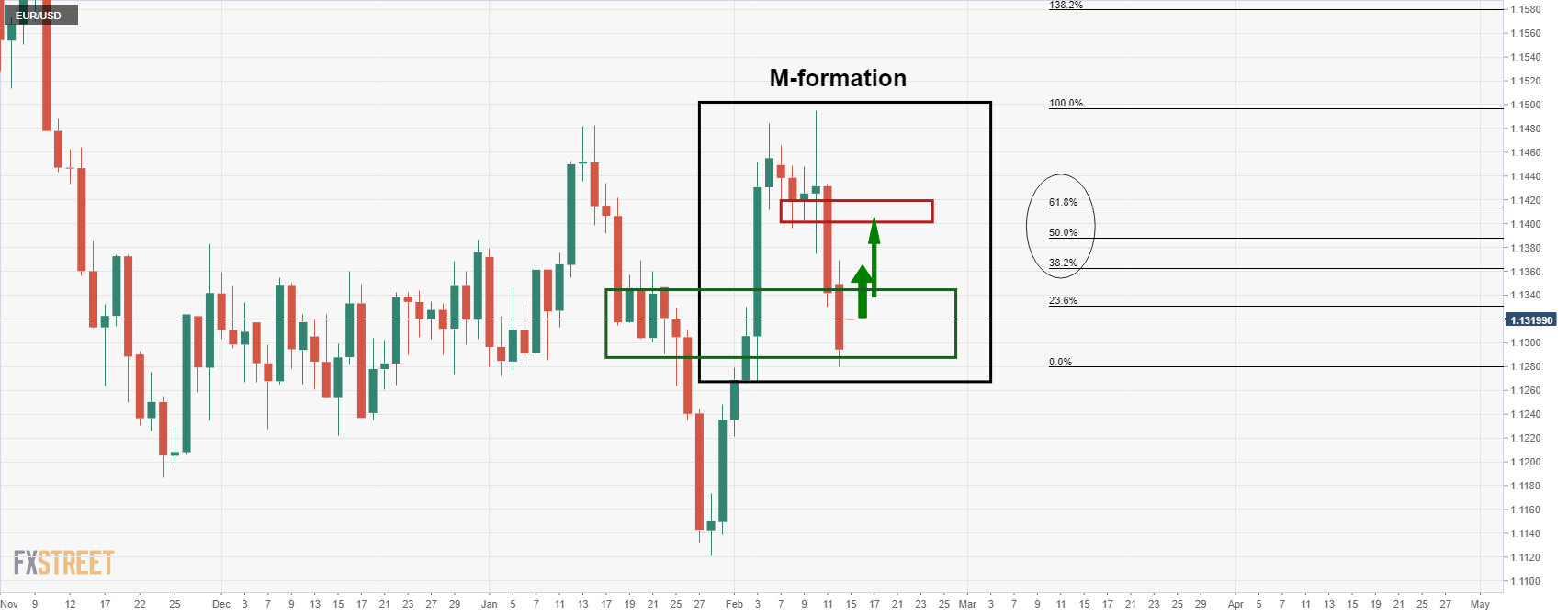
The M-formation was regarded as a reversion pattern with the price expected to correct towards the neckline of the 'M'...
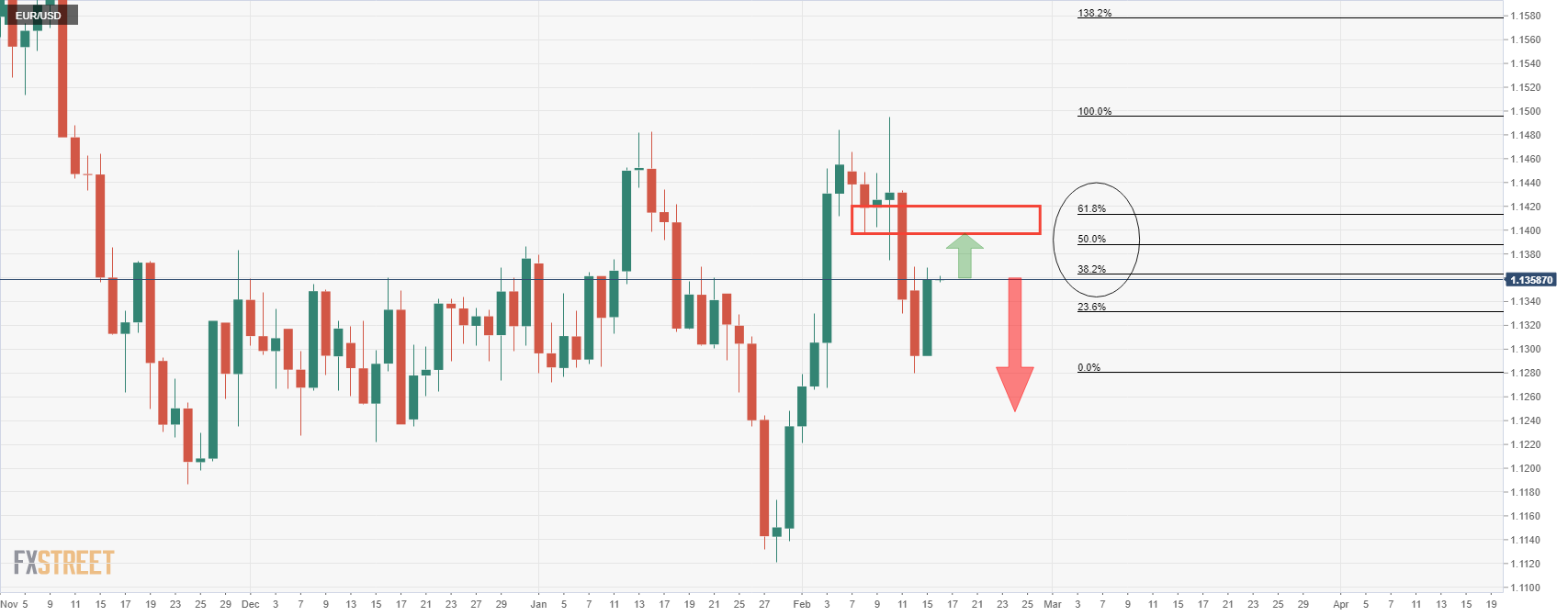
While technical, the above prior analysis had also taken into account the improved, yet tentative, risk sentiment reverberating around global markets following prospects of the de-escalation of an imminent Russian invasion of Ukraine ...
EUR/USD live market
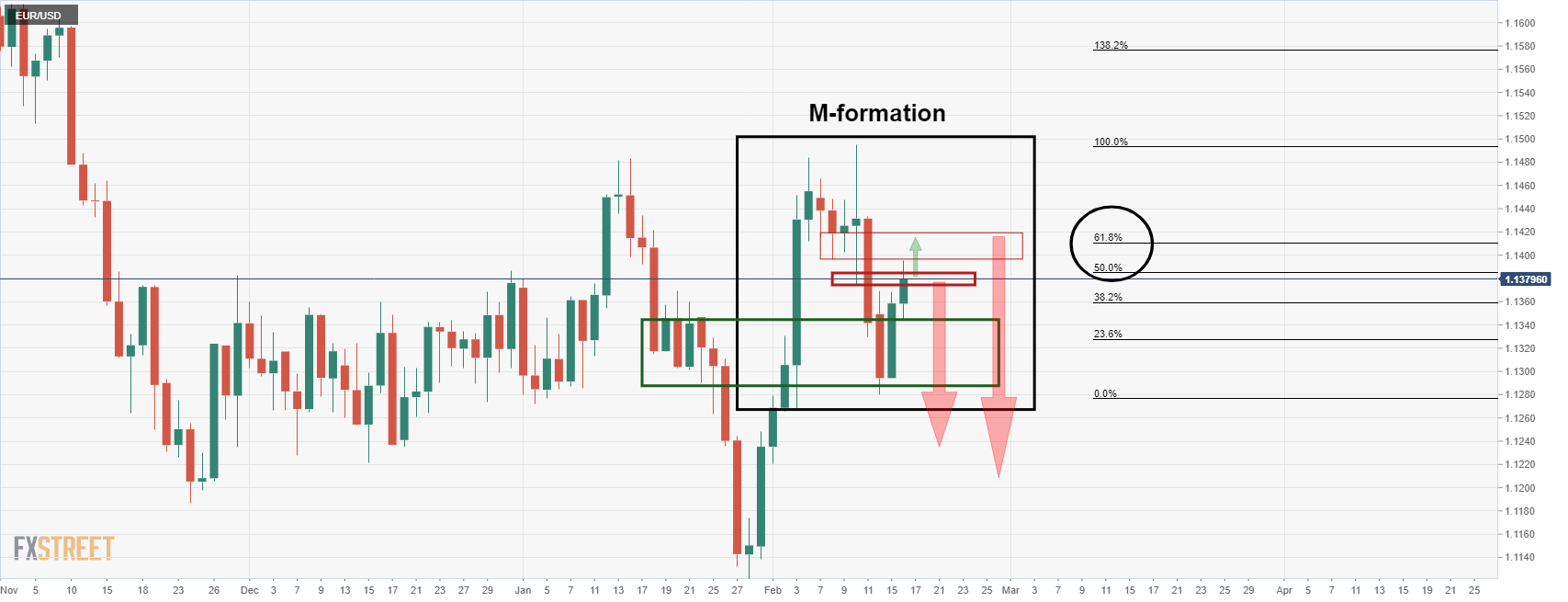
The price has reached a 50% mean reversion in recent trade and the tip of the M-formation's neckline wick, a prior daily low at 1.1396. The 61.8% ratio is near 1.1413 but the Russian headlines are a major distraction from the technicals. The bias, considering global inflationary pressures, a hawkish Federal Reserve, bets on front-loaded tightening could keep losses to a minimum. Therefore, the path of least resistance at this juncture is weighed to the downside, as illustrated in the above analysis.
EUR/USD H4 chart
Bears will be monitoring for signs of exhaustion in the correction from lower time frames. A break below 1.1345 on the H4 chart could be the signal:

However, so long as the 10 EMA threatens a bullish cross-up above the 21-EMA, there are prospects of an upside continuation as overall momentum is in the hands of the bulls still. This would eventuate in a test through 1.14 the figure, moving in on the 61.8% ratio as illustrated above. Nevertheless, unless there is a diplomatic breakthrough between leaders of NATO and Russia, (unlikely that this can be resolved so soon), then the euro will remain vulnerable.
The latest Ukrainian intelligence report on Wednesday showed no evidence of any withdrawal of Russian troops from near Ukraine's border, Ukrainian Defence Minister Oleksii Reznikov told Reuters. Russian and separatist forces amassed at Ukraine's borders continue to amount to about 140,000, he added. This week's massive cyber-attack did not damage Ukraine's Defence Command Control system, Reznikov added.
Market Reaction
There has not been any notable market reaction to the latest comments, but they do add to the broad skepticism shared by Western leaders, government officials and intelligence officials of Russia's alleged withdrawal. Recall that on Tuesday, Russian officials said that the country would partially pull back troops from Ukraine's borders following the completion of military exercises.
Minneapolis Federal Reserve President and FOMC member Neel Kashkari said on Wednesday that it is appropriate to normalise policy and "take the foot off of the gas" in order to address the risk that high inflation gets embedded. However, Kashkari said that his caution to his colleagues was to not overdo it, given that if the Fed raises rates too aggressively, there is a risk the economy could be sent into recession. In the longer run, Kashkari said, there is more of a risk that the Fed ends up back in a low inflation environment.
The Fed will be watching the data over the next six months to make sure inflation is coming back down, Kashkari proclaimed. Most forecasters see inflation falling to about 3.0% YoY by the end of 2022, he noted, saying that his guess was that, by the end of the year, the Fed won't be back at its 2.0% inflation target, but will be well on its way there.
Market Reaction
The more cautious tone of Fed's Kashkari, who wants the Fed not to overdo it with monetary tightening or else risk sending the US economy into a recession, may have weighed somewhat on the US dollar in recent trade. The DXY has recently slipped back to test session lows in the 95.80 area.
Data released on Wednesday showed Industria Procuidn in January increased 1.4% above the 0.4% of market consensus. Analysts at Wells Fargo explained that “a 9.9% surge in utility output amid the big chill in January explains the beat.” They argue “manufacturing output recorded a 0.2% increase after a scant decline in December as manufacturers contend with the ongoing supply chain crisis.”
Key Quotes:
“The recent manufacturing data makes it clear that things continue to slowly make their way back to normal, but with resilient demand production could be even better if supply wasn't a problem. The ISM manufacturing survey for January signaled that while delivery times remain historically long, wait times for inputs have improved somewhat. Difficulty finding qualified labor, however, remains a top concern for manufactures and continues to limit the overall pace of production.”
“Even with a comparatively modest gain in manufacturing, the 1.4% overall increase in January, the level of industrial production today is 2.1% above its pre-pandemic level in February 2020. Capacity is coming back online sharply as well and at 77.6%, it is 1.3 percentage points above its February 2020 rate.”
“It is a long way back to normal, but with some incremental improvement in supply chains means American manufacturing is able to put its factories to work in way that they have been struggling to do for almost two years. Since the demand environment is so much stronger today, the frustration is that production output could be much higher still if factories, mines and utilities had all the material and people they needed to really get back to work.”
- Failure of USD/JPY buyers to print a daily close above 115.60 exacerbated a downward move towards 115.40s.
- USD/JPY Technical Outlook: Neutral-upward biased, but in the short-term downward as geopolitical headlines dominated market mood.
On Wednesday, the USD/JPY edges lower as the North American session progresses, as market sentiment fluctuates between risk-on/off. At the time of writing, the USD/JPY is trading at 115.48.
USD/JPY Price Forecast: Technical outlook
During the overnight session, for North American traders, the USD/JPY reached a daily high of 115.80. However, as risk-aversion increased, courtesy by US Secretary of State Blinken remarks saying that they continue to see critical Russian units moving towards the border and not away, tilted market players’ mood.
The USD/JPY is upward biased, as depicted by the daily moving averages (DMAs) located well below the spot price. Tuesday’s failure to achieve a daily close above the January 28 daily high at 115.68 exacerbated a downward move, as shown by Wednesday’s price action, which tilted the USD/JPY as downward biased in the near term.
That said, the USD/JPY first support would be February 14 daily low at 115.00. A sustained break would expose the 50-DMA at 114.70, followed by the February 2 low at 114.14 and then the 100-DMA at 114.11.
Upwards, the USD/JPY first resistance would be 116.00. Breach of the latter would expose the YTD high at 116.35, followed by a challenge of a 24-month-old downslope trendline around 117.00. A clear break of that ceiling level would pave the way towards January 2017 swing high at 118.61.
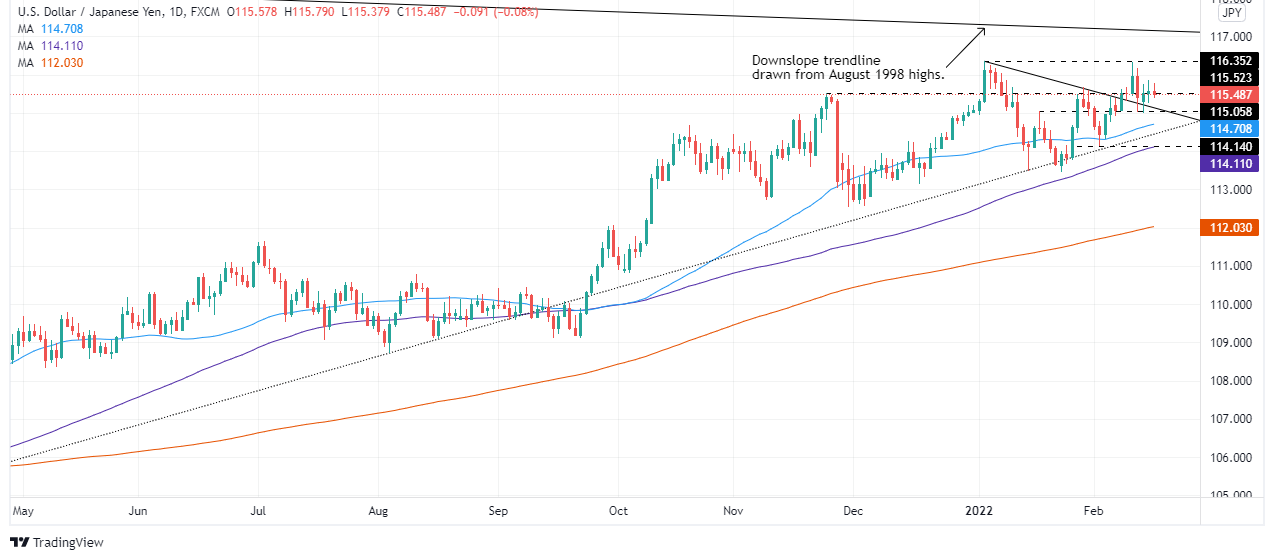
The Canadian Consumer Price Index (CPI) rose in January 0.9% above the 0.6% of market consensus, showed data released on Wednesday. Analysts at the National Bank of Canada point out that annual inflation continues to rise with widespread price increases despite the slowdown in economic activity in January.
Key Quotes:
“The January 2022 release of inflation in Canada proves that economic weaknesses do not always coincide with disinflation, as despite the economy stumbling due to sanitary measures in January, prices rose sharply during the month.”
“Geopolitical tensions pushed up oil prices and consequently gasoline prices (+4.8%), while food prices were up 1.4%, a pace not seen since 2016. This pushed annual inflation to its highest level since the early 1990s.”
“The CPI excluding food and energy also rose noticeably during the month (+0.4%), recording its largest increase in four months. On an annual basis, all eight major categories exceeded the central bank's target range of 1% to 3%, the second occurrence since seasonally adjusted data began being compiled (1992).”
“This generalized nature of inflationary pressures is what has led us to say for some time that the economy no longer needs a policy rate at the effective lower bound, especially given the lag in the transmission of monetary policy. We expect inflation to moderate somewhat over the next 12 months, but to remain around 3% (the central bank's upper range) given the current supply chain disruptions and labor shortages.”
Retail Sales in the US rose 3.8% in January, the biggest gain since March 2021. Analysts at Wells Fargo, point out the increase handily exceeded consensus expectations and was only partly a function of higher prices. They suspect that part of the increase “may have to do with certain merchandise finally becoming available.”
Key Quotes:
“Consumer spending may have lost some momentum in the final months of 2021, but today's retail sales report for January says that consumers have swaggered into 2022 undaunted by soaring inflation and soaring COVID cases that month. Our consumer dashboard below is consistent with some improvement in January, but this report shows spending that was suspiciously strong.”
“Gains were broadly based, but concentrated in a few key categories and control group sales, which factor into GDP and exclude food services, auto dealers, building materials stores and gasoline stations jumped 4.8%, that too was the largest monthly increase since stimulus payment went out last March.”
“We still believe the factors that propelled strong growth in consumer spending last year are shifting and, in some cases, have reversed altogether. The biggest factor of all, in our view, is inflation. Most consumers have never seen anything like it, and it is weighing on sentiment and could force some difficult spending decisions for consumers this year. The Fed is well aware of the inflation struggles, and as the Fed removes policy support in a deliberate effort to keep a lid on prices, it will weigh on growth in consumer demand by design.”
Minneapolis Federal Reserve President and FOMC member Neel Kashkari said on Wednesday that the Fed is going to do what is needed to bring "thing" (the economy) back into balance. Some of the inflation should fade on its own as stimulus fades and people switch to buying services, he added.
Kashkari said that the Fed can soften demand by raising rates and tightening financial conditions, but that won't address supply-side issues. He also noted that his own recent experience with Covid had suggested to him that it will be a while until we can be comfortable living with the virus, before supply chains come back and before workers on the side-line can come back to work.
Market Reaction
There has not been any reaction to Kashkari's latest remarks, which haven't added anything new. Market attention is currently focused on the upcoming Fed minutes release and geopolitical developments regarding Russia/Ukraine.
- Spot silver is subdued in the mid-$23.50s as traders await the upcoming minutes release of the January Fed meeting.
- Traders will gauge the support for a larger 50bps move, though following recent inflation surprises, the minutes are somewhat stale.
- Geopolitics remains the main near-term driver for XAG/USD, amid ongoing confusion over Russia’s alleged partial troop withdrawal from Ukraine’s border.
Having largely shrugged off the latest mixed US Retail Sales report, spot silver (XAG/USD) prices are consolidating in the $23.50 region as focus turns to the upcoming release of the minutes of the January Fed meeting at 1900GMT. At current levels just under the $23.50 mark, the precious metal is trading with on-the-day gains of about 0.5%.
Traders will be looking for clues as to the level of support on the FOMC for a larger 50bps rate hike in March, something which Fed Chair Jerome Powell refused to rule out in the post-meeting press conference. The minutes are somewhat stale, however, as opinion on the committee might have shifted in a hawkish direction following recent Consumer and Producer Price Inflation data surprises.
That implies that markets might not be too fussed if the minutes come across a little more dovish compared to recent more hawkish Fed commentary, most notably from St Louis Fed President and 2022 voting FOMC member James Bullard. He has been calling for 100bps of rate hikes by the end of Q2, as well as the start of passive balance sheet run-off. The risk of volatility in wake of the minutes to silver and other precious metals is thus perhaps somewhat lessened versus prior Fed meeting minute releases.
Geopolitics will likely remain the main driver of precious metal market sentiment. XAG/USD was weighed on heavily by Russian proclamations that it would be partially withdrawing troops from its border with Ukraine, pulling back sharply from February highs near $24.00 per troy ounce. But Western leaders, as well as government and intelligence officials have been warning that they have not yet seen any actual evidence of de-escalation and troop withdrawal, making for heightened confusion.
A further build-up of tensions could easily send spot silver prices back towards a test of weekly highs, and to a potential breakout towards long-term downtrend resistance in the mid-$24.00s.
Thursday’s release of Australia’s January labour report can be expected to inject fresh life into the debate regarding the likelihood of a Reserve Bank of Australia (RBA) rate hike during the course of 2022. Strong data could lift the aussie to the 0.72 level, according to economists at Rabobank.
Scope for AUD/USD to inch higher towards 0.74 on a 12-month view
“The market median for the Australian January unemployment rate stands at 4.2%. Any strength in the labour market report over and above market expectations is likely to increase the pressure on the RBA to widen the scope for a rate hike this year. Strong data are likely to put AUD/USD 0.72 back in view assuming no surge in safe-haven demand for the USD near-term.”
“Given the strength of commodity prices and a healthy economic outlook in Australia, we see scope for AUD/USD to edge moderately higher to the 0.74 region on a 12-month view.”
- Cable rises to the 1.3580 area as the pound strengthens.
- Dollar weaker despite steady yields and lower equity prices.
- Critical event ahead: FOMC minutes at 19:00 GMT.
The GBP/USD gained momentum and climbed to 1.3583, reaching the highest level since Friday. It is hovering above 1.3565, with a positive tone ahead of the release of the FOMC minutes.
The pound also strengthened versus the euro during the American session. EUR/GBP tested earlier on Wednesday levels above 0.8400 and recently printed fresh daily highs under 0.8370.
Earlier on Wednesday, data showed inflation hit the highest level in more than thirty years in the United Kingdom in January. The consumer price index (CPI) increased from 5.4% to 5.5%, slightly above expectations. The pound held relatively steady after the report.
In the US, retail sales jumped 3.8% in January, the best month since April 2021. The dollar initially appreciated but then pulled back. A different report showed Industrial production in January rose 1.4%, above the 0.4% of market consensus.
The key event on Wednesday will be the release of the FOMC minutes of the last meeting at 19:00 GMT. “A March hike is pretty much a done deal but markets will be looking for clues at the likely pace of tightening as well as when balance sheet runoff might be seen and what might trigger outright asset sales vs. simple runoff from maturing securities”, explained analysts at Brown Brother Harriman.
Testing levels above 1.3570
The GBP/USD is trading around 1.3575. The momentum will favor the pound while above 1.3570, with a test of 1.3600 on the cards. The next resistance stands at 1.3620. On the flip side, a slide back under 1.3545 should point to further weakness in cable exposing the next support at 1.3525.
Technical levels
- WTI rebounded around $2.0 on Wednesday to back above $94.00 amid confusion over whether Russia is actually withdrawing troops.
- Geopolitics aside, many commodity strategists remain bullish and predict $100 per barrel as market conditions remain tight.
Crude oil prices have seen substantial upside in recent trade as market participants fret amid confusion over whether Russia is actually withdrawing some troops from its border with Ukraine as is said it would on Tuesday. Western leaders, government and intelligence officials have been loudly warning, including remarks most recently from US Secretary of State Anthony Blinken in an interview with MSNBC, that there is not yet any evidence of Russian withdrawal. On the contrary, they said, Russia continues to add to its attack capabilities, they said.
Associated fears as investors continue to weigh the prospect of a Russia/Ukraine military conflict and associated disruptions to global oil supply have propelled front-month WTI futures roughly $2.0 higher on Wednesday from session lows under $92.00 to above $94.00. That means prices are now back to within $2.0 of last Friday’s seven-year highs near the $96.00 level and have now rebounded roughly $3.50 from Monday’s mid-$90.00 lows. Weekly Private US crude oil inventory figures out on Tuesday showed that crude oil, gasoline and distillate stocks all drew last week, with the upcoming official US inventory report at 1530GMT expected to show the same and lending to the idea that oil markets remain tight.
OPEC’s secretary general Mohammed Barkindo on Wednesday said that current levels of oil supply are not enough, but warned that this was due to underinvestment from oil companies and cautioned that there would be no immediate cure for high prices. Many commodity strategists continue to believe that oil markets are headed back towards $100 per barrel or more, regardless of geopolitical developments in Eastern Europe, as smaller OPEC+ members continue to struggle to lift output in line with quota increases.
- US Retail Sales came higher than expected, but Canadian inflation elevated above the 5% threshold.
- The market sentiment shifted to risk-off on US Secretary of State Blinken’s remarks that Russia moves troops to the Ukraine border.
- USD/CAD is neutral-upward biased, but USD/CAD buyers need to reclaim 1.2700.
In the North American session, the USD/CAD extend its weekly losses, following positive economic data from the US and Canada. At the time of writing, the USD/CAD is trading at 1.2690.
The financial markets are on a rollercoaster, as market mood swings between risk-on/off. Before US macroeconomic data crossed the wires, US equity futures pointed to a higher open. However, around 13:50 GMT, US Secretary of State Blinken said they continue to see critical Russian units moving towards the border and not away, causing a shift in market players’ mood.
It is worth noting that geopolitical headlines are the market movers since last Friday’s putting aside macroeconomic data.
US Retail Sales better than expected while Canada inflation breaks the 5% threshold
Before Wall Street opened, the US Retail Sales in January rose 3.8% m/m, higher than the 2% estimated by analysts, recovering from December’s reading which showed a 2.5% (revised lower) m/m contraction. Excluding autos and gas, sales jumped 3.8% m/m, north of the -3,2% (revised) December’s figure.
At the same time, the Canadian economic docket released inflation figures, with the Consumer Price Index (CPI) for January jumping 5.1% y/y, hotter than the 4.8% estimated, as reported by Statistics Canada. The so-called Core CPI rose 4.3% y/y, higher than the 4% in December.
Later on the day, at 18:30 GMT, the Bank of Canada (BoC) Governor Lane would cress the wires, followed 30 minutes after by the release of Federal Open Market Committee (FOMC) January meeting minutes, which could give clues regarding the Fed’s path towards tightening monetary conditions.
USD/ CAD Price Forecast: Technical outlook
Since the beginning of the week, the USD/CAD failed to break above the 1.2800 thresholds, accelerating the downward move. On its way south, CAD buyers reclaimed the 50-day moving average (DMA) that lies at 1.2704, but the pair is neutral-upward biased despite the aforementioned.
That said, the USD/CAD first resistance would be the confluence of the 1.2700 figure and the 50-DMA. Breach of the latter would expose February 11 1.2754 daily high, followed by 1.2800.
- The upside in DXY stays capped by the 96.00 region.
- US Retail Sales surprised to the upside last month.
- FOMC Minutes takes centre stage later in the session.
The US Dollar Index (DXY), which gauges the greenback vs. a bundle of its main competitors, meets some decent support near 95.70 midweek.
US Dollar Index offered pre-FOMC Minutes
The index trades on the defensive for the second straight session, although it managed to bounce off earlier 3-day lows in the 95.80/75 band.
Persistent risk-on sentiment continues to put the buck under pressure in a context dominated by declining yields in the global markets, while market participants continue to assess the developments coming from the Russia-Ukraine front.
In the US docket, better-than-expected Retail Sales lent some initial support to the dollar, although the optimism faded away later with another set of mixed results after the NAHB Index ticked lower to 82 in February, Business Inventories matched estimates after expanding 2.1% MoM in December, Capacity Utilization improved to 77.6% in January and Industrial Production expanded at a monthly 1.4% also during last month.
US Dollar Index relevant levels
Now, the index is losing 0.08% at 95.90 and a break above 96.43 (weekly high Feb.14) would open the door to 97.44 (2022 high Jan.28) and finally 97.80 (high Jun.30 2020). On the flip side, the next down barrier emerges at 95.76 (weekly low Feb.16) seconded by 95.17 (weekly low Feb.10) and then 95.13 (weekly low Feb.4).
- Spot gold found good support in the $1850 area and has advanced on Wednesday in the run-up to Fed minutes.
- Geopolitical angst regarding Russia/Ukraine remains elevated, underpinning gold, which is also being supported by technical factors.
As US/NATO officials continue to question the veracity of Russian claims that the country is now withdrawing troops from its border with Ukraine, markets remain nervous about the prospect of a flare-up in military tensions in the region. This is helping to keep spot gold (XAU/USD) prices supported above key support at the $1850 level. At current levels in the mid-$1860s, XAU/USD is trading with on-the-day gains of about 0.5%, unfazed by the latest US Retail Sales figures, which were much stronger than expected for January, though also saw hefty negative revisions to the December numbers.
As gold traders keep one eye on geopolitical developments in Eastern Europe, focus is increasingly shifting towards Wednesday’s release of the minutes from the January Fed policy meeting. Fed Chair Jerome Powell refused to rule out the possibility of a larger 25bps rate hike in March. In wake of recent Consumer and Producer Price Inflation data surprises as well as hawkish comments from some Fed policymakers (like James Bullard), US money markets have been increasingly leaning towards a 50bps move next month. The minutes will thus be scrutinised for any indications as to FOMC support for a larger 50bps rate hike.
The fact XAU/USD found solid support at the $1850 level on Wednesday is positive from a technical perspective. The precious metal recently broke to the north of a long-term pennant structure and in finding support at $1850, XAU/USD found support at the retest of the pennant. Technicians might thus now view a move back to multi-month highs in the $1880 area as highly likely and perhaps even a push on towards mid-2021 highs in the $1920 area. Should the geopolitical situation in Eastern Europe further soar, that would lend fundamental impetus to such a move.
-637806206434059826.png)
EUR/JPY has found a floor as expected above its rising 55-day moving average and 61.8% retracement of the January/February rally at 129.81/130.13. Analysts at Credit Suisse look for a retest of the top of the eight-month downtrend channel from June last year at 132.94.
Support at 129.81 to hold for an eventual retest of the top of the down channel at 132.94
“We look for a fresh move higher with resistance seen at 131.84/88 initially, with a break above 132.24/36 needed to clear the way for a move back to the top of the eight-month channel at 132.94.”
“A sustained move above the eight-month channel at 132.9 and then the 133.49 high of October last year should confirm a more important turn higher is underway, with resistance then seen next at the 2021 high at 134.14.”
“Support is seen at 130.88 initially, then 130.44/43, with 130.13/129.81 expected to remain a solid floor.”
GBP/USD’s broad price action remains range-bound. 1.35 and 1.36 are the levels to watch, according to analysts at Scotiabank.
Cable remains limited by 1.3600/10
“Rangebound trading looks set to remain unless the GBP makes a firm move under 1.35 – but it has quickly been bid under the figure on three separate occasions this month.”
“Intermediate support is the mid-figure area and ~1.3520.”
“On the upside, the pound remains limited by 1.3600/10, initially, followed by the mid-figure area; the 200-day MA, above which it hasn’t closed since last Sep, comes next at 1.3694.”
See: GBP/USD to post bullish technical signal on a move above 1.3710/1.3750 – SocGen
- EUR/USD fades the earlier advance to the 1.1400 area.
- US Retail Sales came above estimates in January.
- Markets’ attention now shifts to the FOMC Minutes.
Following an early climb to the proximity of 1.1400, EUR/USD now erodes part of that move and returns to the 1.1360 region so far on Wednesday.
EUR/USD capped by 1.1400, looks to FOMC
EUR/USD failed to extend the weekly rebound further north of the 1.1400 mark midweek, as better-than-expected results from the US docket sponsored a noticeable bounce in the buck.
Indeed, US Retail Sales crushed initial estimates after expanding at a monthly 3.8% in January. Core sales followed suit and rose 3.3% MoM. Earlier data showed Mortgage Applications shrinking 5.4% in the week to February 11 according to MBA.
In the meantime, the relief rally keeps sustaining the better mood in the risk complex despite there seems to be no further progress on the (apparent) de-escalation of tensions in the Russia-Ukraine front.
Later in the session, US Industrial Production, Capacity Utilization, Business Inventories and the NAHB Index are all due ahead of the release of the FOMC Minutes of the January event.
What to look for around EUR
EUR/USD now seems to have met decent resistance around the 1.1400 zone amidst some loss of momentum in the relief rally in combination with above-estimated results from the US docket. Looking at the broader scenario, the improvement in the pair’s outlook appears underpinned by fresh speculation of a potential interest rate hike by the ECB at some point by year end, higher German yields, persevering elevated inflation and a decent pace of the economic activity and other key fundamentals in the region.
Key events in the euro area this week: EMU Industrial Production (Wednesday) – Flash EMU Consumer Confidence (Friday).
Eminent issues on the back boiler: Asymmetric economic recovery post-pandemic in the euro area. Speculation of ECB tightening/tapering later in the year. Presidential elections in France in April. Geopolitical concerns from the Russia-Ukraine conflict.
EUR/USD levels to watch
So far, spot is advancing 0.02% at 1.1360 and faces the next up barrier at 1.1395 (weekly high Feb.16) followed by 1.1491 (200-week SMA) and finally 1.1494 (2022 high Feb.10). On the other hand, a drop below 1.1326 (55-day SMA) would target 1.1279 (weekly low Feb.14) en route to 1.1186 (monthly low Nov.24 2021).
NZD/USD is undergoing another minor recovery following its decline from last week, which analysts at Credit Suisse anticipate will prove temporary. They still view the market as in a broader downtrend and would fade rallies like this one.
0.6701/10 to hold any further bounce
“With major resistance at the December 2021 lows at 0.6701/10 ideally serving as a ceiling for this upmove, we still look for NZD/USD to shift back lower again, with a closing break below 0.6601/6589 needed to reassert the downtrend and decrease the risk of further recoveries.”
“Below 0.6601/6589 would see scope for the YTD low at 0.6529 to be retested again, with break below here opening the door to our long-held objective at 0.6511/6488 – the August and September lows of 2020.
“Immediate resistance is seen at 0.6662, then at 0.6681/92 and eventually at the aforementioned December 2021 lows at 0.6701/10.”
“A sustained closing break above 0.6701/10 and then the 55-day moving average at 0.6734/40 would instead suggest that a broader sideways phase would arise.”
EUR/USD rebounds to the upper 1.13s but upside potential remains limited, according to economists at Scotiabank.
Break above 1.14 would mark a key bullish signal for the euro
“A break above 1.14 (where its 100-day MA of 1.1404 stands) would mark a key bullish signal for the EUR with resistance following at ~1.1450 and the figure area.”
“Support after the 1.1350 zone is ~1.1320 and 1.1300/80.”
“EUR/USD may rebound marginally on an easing of military tensions, but we think it remains challenged over the next few quarters by ultra-dovish monetary policy settings, which should weigh on it toward 1.10.”
US Secretary of State Anthony Blinken said on Wednesday in an interview on MSNBC that the US has not seen any pullback of Russian forces from the Ukrainian border.
- AUD/SUD gained traction for the second successive day amid modest USD weakness.
- Hawkish Fed expectations, upbeat US Retail Sales helped limit any further USD losses.
- Investors might prefer to wait on the sidelines ahead of the FOMC meeting minutes.
The AUD/USD pair retreated a few pips from the weekly high touched earlier this Wednesday and traded with modest intraday gains, around the 0.7165 region post-US macro releases.
Following a brief consolidation phase through the early part of the trading on Wednesday, the AUD/USD pair gained some positive traction and built on the overnight rebound from the 0.7100 mark. Easing fears about the risk of Russia invading Ukraine continued undermining the safe-haven US dollar, which, in turn, was seen as a key factor that benefitted the perceived riskier aussie.
That said, rising bets for a 50 bps Fed rate hike in March acted as a tailwind for the buck, which further drew support from mostly upbeat US economic data. In fact, the US Census Bureau reported that monthly Retail Sales recorded strong-than-expected growth of 3.8% in January. Excluding autos, core retail sales also surpassed estimates and climbed by 3.3% during the reported month.
A sharp improvement in consumer spending reinforced market expectations that the Fed would adopt a more aggressive policy response to contain stubbornly high inflation. This was evident from elevated US Treasury bond yields, which helped limit the intraday USD losses. Traders, however, refrained from placing aggressive bets ahead of the FOMC meeting minutes, due later during the USD session.
Investors will look for fresh clues about the likely pace of the Fed's policy tightening cycle, which will play a key role in influencing the near-term USD price dynamics. Apart from this, the broader market risk sentiment would provide some impetus to the AUD/USD pair and allow traders to grab short-term opportunities.
Technical levels to watch
- Headline Canadian CPI surprised at 5.1% YoY versus the expected 4.8% reading for January.
- Core and various other BoC measures were all also stronger versus December and market expectations.
- The loonie saw some initial strength, with the latest data strengthening the argument for swift removal of BoC monetary accommodation this year.
The headline Canadian Consumer Price Index (CPI) rose at an annual pace of 5.1% in January, above median economist forecasts for a pace of 4.8% and above December's 4.8% YoY rate of price growth, according to data released by Statistics Canada on Wednesday. MoM, headline price growth came in at 0.9%, well above the expected 0.6% reading and a sharp acceleration from December's -0.1%.
Meanwhile, the BoC's Core Canadian CPI came in at an annual pace of 4.3%, well above consensus forecasts for 3.5%, powered by a 0.8% MoM rise, which was well above the expected 0.0%. The BoC's Trimmed CPI came in at 4.0% YoY, up from 3.7% in December, the Median CPI rose to 3.3% YoY from 3.0% and the Common CPI rose from 2.1% to 2.3% YoY in January, slightly bigger than the expected leap to 2.2%. That meant the average of BoC measures rose to 3.2% in January from 2.93% the month prior.
Market Reaction
USD/CAD saw an initial blip lower to fresh session and weekly lows in the 1.2660s, though these losses have now been mostly pared, with the currency cross now roughly back to pre-data levels in the 1.2670s. Traders are likely to assess the latest inflation figures as strengthening the argument for swift BoC policy tightening this year, starting with a rate hike (probably 25bps but perhaps of 50bps) in March. The main driver of CAD for the rest of the session is, however, likely to remain geopolitical developments and how this impacts risk appetite and crude oil prices.
- US Retail Sales saw larger than expected gains in January across headline and core measures, though December data saw large negative revisions.
- The US dollar has been choppy in response the latest data and not shown a clear reaction.
Headline US Retail Sales rose by 3.8% MoM in January, well above median economist forecasts for a 2.0% MoM rise, marking a sharp acceleration from December's 2.5% MoM decline, which had been revised negatively from a 1.9% decline, data released by the US Census Bureau on Wednesday showed.
Core Retail Sales also saw a much larger than expected MoM growth rate of 3.3% versus median forecasts for a 0.8% gain, though the December reading also saw a negative revision to -2.8% from previously -2.3%. The Retail Control group, which correlated more closely to the retail sales component in US GDP calculations, gained 4.8% MoM, well above the 1.0% expected, though December's reading was also revised negatively to -4.0% from previously -3.1%.
Import and Export Price Index data for January was also released at the same time as the latest Retail Sales report, showing the former rising 2.0% MoM in January and the latter rising 2.9%. That is well above the 1.3% MoM expected rise for both.
Market Reaction
The US dollar didn't see much of a reaction to the latest US Retail Sales figures, with any strength associated with large heading beats seemingly negated by the negative revisions to the December numbers.
- EUR/USD has been choppy on Wednesday in the run-up to US Retail Sales and Fed minutes.
- EUR/USD trades a little higher in the 1.1370s, with geopolitics set to remain the key market driver in the near-term.
EUR/USD has been choppy since the start of the European session, rising quite sharply from around the 1.1350 area as European participants arrived to nearly test the 1.1400 level shortly after the European market open. Since then, however, the pair has ebbed back to the 1.1360s, where it only very slightly in the green by about 0.1%. Indecisiveness in the run-up to the release of US January Retail Sales data at 1330GMT followed by the minutes of the January FOMC meeting at 1900GMT is not overly surprising. Traders mull the prospect for a 50bps rate hike next month following recent upside Consumer and Producer Price Inflation data surprises.
However, the more important near-term driver of the pair, for now, remains geopolitics as Russia attempts to signal to the West that it is de-escalating tensions with more conciliatory political rhetoric and releases videos showing troop withdrawals. However, NATO/Western leaders and intelligence officials have warned that there is scant proof yet of any de-escalation and Ukraine on Tuesday suffered a series of massive cyber-attacks, with Russia-backed agents the suspected culprits. Ongoing simmering tensions probably in part explain why EUR/USD on Wednesday failed to break back to the north of the 1.1400 level.
One potential flashpoint in the Ukraine/Russia situation is the latter’s likely imminent recognition of the breakaway Donetsk and Luhansk People’s Republics in Eastern Ukraine as formerly independent nations, which would contravene international law and a key peace agreement. Traders will monitor for any further signs of escalation, which could again result in underperformance of the euro and further EUR/USD downside on fears of Eurozone economic vulnerability to Russian gas import disruptions. Should tensions continue to ease, the euro might be freed up to start benefitting from the recent more hawkish tone from ECB officials in recent days (Schnabel, Villeroy and Kazaks), all of whom suggested they would back a faster QE taper and rate hikes soon thereafter.
AUD/USD is turning back higher. Nonetheless, analysts at Credit Suisse look for key resistance at 0.7209/13 to cap again.
Sustained break above 0.7209/13 to signal a longer consolidation
“We stay core bearish with the downtrend from late October at 0.7209/13 ideally capping any additional recovery. With this in mind, we look for an eventual turn back lower, with immediate support seen at 0.7112, then at 0.7099/84 and eventually back at 0.7063/49, with a close below this later level needed to reinject fresh momentum into the downward trend – putting AUD/USD on the path to a renewed test of the YTD lows at 0.6972/62.”
“A sustained break above the late October downtrend at 0.7209/13 would lead us to reconsider our tactical position and see scope for a lengthier consolidation to emerge.”
- Fading safe-haven demand weighed on the CHF and assisted USD/CHF to regain positive traction.
- Modest USD weakness held back bulls from placing aggressive bets and capped any further gains.
- Investors look forward to the US Retail Sales data for some impetus ahead of the FOMC minutes.
The USD/CHF pair traded with a mild positive bias heading into the North American session and was last seen hovering just a few pips below the daily high, around the 0.9250-0.9255 region.
The USD/CHF pair attracted fresh buying on Wednesday and inched back closer to the overnight swing high amid receding Russian-Ukraine tensions, which undermined the Swiss franc's safe-haven status. In fact, Russia announced on Tuesday that some of its troops positioned near the Ukraine border were returning to bases after the completion of exercises. This helped ease market concerns about a further escalation of the conflict between Russia and the West, which, in turn, boosted investors' confidence.
On the other hand, a softer tone around the US Treasury bond yields kept the US dollar on the defensive and failed to impress bullish traders or provide any additional boost to the USD/CHF pair. That said, growing acceptance that the Fed would tighten its monetary policy at a faster pace than anticipated might continue to act as a tailwind for the buck. This, in turn, supports prospects for the emergence of some USD dip-buying and a further near-term appreciating move for the USD/CHF pair.
Traders, however, might refrain from placing aggressive bets and prefer to wait for a fresh catalyst from the FOMC meeting minutes, due for release later during the US session. In the meantime, the US monthly Retail Sales figures, along with the US bond yields will play a key role in influencing the USD price dynamics. Apart from this, the broader market risk sentiment might provide some impetus to the USD/CHF pair and allow traders to grab some short-term opportunities.
Technical levels to watch
Gold continues to improve, but still has more work to do to mark an important break higher, in the opinion of strategists at Credit Suisse.
Break below $1,821 to alleviate upside pressure
“Gold has strengthened sharply and is above rising short, medium- and long-term averages and the spotlight is firmly on the $1,877 high of November. Only a weekly close above here though would suggest we are seeing a more sustainable move higher, for a test of $1,917 next. Above this latter level though would be seen to add momentum to a rally, raising the prospect of a move back to the $2075 high.”
“Below $1,821 is needed to ease the immediate upward bias but with a move below $1,780 needed to clear the way for a retest of key price and retracement support from the lower end of the range at $1,691/76.”
See – Gold Price Forecast: XAU/USD to climb as high as $1,923/1,930 – SocGen
Canada CPI Overview
Statistics Canada will release the latest consumer inflation figures for January later during the early North American session on Wednesday, at 13:30 GMT. After contracting by 0.1% in December, the headline CPI is expected to rise 0.6% during the reported month. The yearly rate, however, is anticipated to keep a steady pace at the three-decade high of 4.8% YoY in January. More importantly, the Bank of Canada's Core CPI, which excludes volatile food and energy prices, is estimated to rise 0.4% MoM in January and 4.6% YoY.
According to analysts at CIBC: “Food prices are the main upward threat to our forecast, but given the timing of the latest transportation issues and an increase in dairy prices, February should see the largest gain in that area. Overall, we forecast a 0.5% unadjusted monthly increase in prices, with the annual rate holding steady at 4.8%.”
How Could it Affect USD/CAD?
The report will be accompanied by the simultaneous release of the US Retail Sales figures and should infuse some volatility around the USD/CAD pair. A surprisingly stronger CPI print, similar to what the US and the Eurozone have experienced, would lift bets for more rate increases by the Bank of Canada and boost the domestic currency. Conversely, a softer reading should lend some support to the USD/CAD pair ahead of the FOMC meeting minutes, due later during the US session.
Ahead of the key data, the USD/CAD pair dropped a fresh weekly low and was pressured by a combination of factors. An uptick in crude oil prices underpinned the commodity-linked loonie and dragged the pair lower amid modest US dollar weakness. From current levels, any subsequent decline below the 1.2670-1.2665 region might stall near the monthly low, around the 1.2635 region. Some follow-through selling will be seen as a fresh trigger for bearish traders and set the stage for a further near-term depreciating move.
On the flip side, recovery back above the 1.2600 mark now seems to confront stiff resistance near the 1.2735 horizontal zone. Sustained strength beyond has the potential to lift the USD/CAD pair back towards the top end of a near three-week-old trading range, around the 1.2775-1.2785 region. This is closely followed by the 1.2800 mark, above which the pair could accelerate the momentum towards the 1.2835 region en-route the 1.2870-75 intermediate hurdle and the 1.2900 round-figure mark.
Key Notes
• Canadian CPI Preview: Forecasts from five major banks, not out of the woods yet
• USD/CAD Forecast: Canadian CPI/US Retail Sales/FOMC minutes eyed for fresh directional impetus
• USD/CAD: BoC tightening cycle should offer support to the loonie – ING
About Canadian CPI
The Consumer Price Index (CPI) released by Statistics Canada is a measure of price movements by the comparison between the retail prices of a representative shopping basket of goods and services. The purchase power of CAD is dragged down by inflation. The Bank of Canada aims at an inflation range (1%-3%). Generally speaking, a high reading is seen as anticipatory of a rate hike and is positive (or bullish) for the CAD.
According to Reuters citing a Senior Western Intelligence official, there is no credible sign of Russian de-escalation. Russian military exercises are currently at their peak stage, the official warned, and the risk of a Russian attack on Ukraine will remain elevated for at least the rest of the month. The intelligence official said that the greatest risk of conflict or an unintended military accident was right now and that "I expect things to be really confusing and ambiguous for the next couple of weeks". The official warned the next stage of Russian military drills would be ballistic missile launches and that Russia could attack Ukraine with "essentially no, or little-to-no, warning".
Market Reaction
USD/RUB, the best proxy to watch to gauge how markets are feeling about Russia/Ukraine war risk, doesn't seem to have reacted to the latest reports from Reuters.
European Central Bank Governing Council member and Latvian Central Bank Governor Martins Kazaks said on Wednesday that a interest rate hike this year is "quite likely".
The OPEC President on Wednesday said that oil supply is not now enough and blamed oil companies for not investing enough. There is a quick rise in demand and we need to respond, the President noted, adding that we have to invest as quick as possible so supply can meet demand. Oil production has increased over the last few months, he said, but there is still a gap between targets and output. The main question, the President said, is how long it will take to produce more crude oil, before reiterating OPEC's mission to bring oil market stability and balance. We need a commitment from all oil market players, including non-OPEC+ member nations, to increase oil supply.
Market Reaction
Oil prices have seem some negative ticks in recent trade, with front-month WTI futures dipping back to the $93.00 area from earlier session highs in the $93.40s in recent trade. Traders will likely bet increasingly on the idea that OPEC+ might agree to a larger output hike at its next meeting, or that the likes of the Saudis and UAE will increase output by a larger margin to make up for shortfalls in output from other OPEC+ nations.
US Monthly Retail Sales Overview
Wednesday's US economic docket highlights the release of monthly retail sales figures for January, scheduled later during the early North American session at 13:30 GMT. The headline sales are estimated to have risen by a seasonally adjusted 2% during the reported month, reversing the 1.9% fall recorded in December. Excluding autos, core retail sales probably climbed by 0.8% in January as against the previous month's dismal reading of -2.3%.
Analysts at TD Securities (TDS) offered a brief preview and explained: “Spending was likely aided by a surge in auto purchases and an improvement in restaurant sales, with the latter likely recovering from the Omicron impact. We also expect control group sales to gain some ground again following two consecutive declines in Nov-Dec.”
How Could it Affect EUR/USD?
Ahead of the key release, signs of receding Russian-Ukraine tensions undermined the safe-haven US dollar and pushed the EUR/USD pair higher for the second successive day. That said, the prospects for a faster policy tightening by the Fed should help limit the USD losses. A stronger than expected US Retail Sales data might further boost market bets for a 50 bps Fed rate hike move in March and further act as a tailwind for the greenback. Conversely, a softer print is unlikely to derail the Fed's policy normalization path or prompt any meaningful selling around the buck. That said, the immediate market reaction is likely to be short-lived as the focus remains on the FOMC meeting minutes, due for release later during the US session.
Meanwhile, Eren Sengezer, Editor at FXStreet, outlined important technical levels to trade the EUR/USD pair: “1.1400 (psychological level, Fibonacci 23.6% retracement of the latest uptrend, 50-period SMA) aligns as the next bullish target ahead of 1.1450 (static level) and 1.1480 (static level).”
“On the downside, the Fibonacci 38.2% retracement and the 200-period SMA seem to have formed key support in the 1.1340/1.1350 area ahead of 1.1320 (100-period SMA) and 1.1300 (psychological level, Fibonacci 50% retracement),” Eren added further.
Key Notes
• US January Retail Sales Preview: Geopolitics, FOMC Minutes to impact dollar’s valuation
• US Retail Sales Preview: Forecasts from five major banks, consumer activity regaining steam
• EUR/USD Forecast: Euro faces two-way risk, markets await clarity on Russia-Ukraine conflict
About US Retail Sales
The Retail Sales released by the US Census Bureau measures the total receipts of retail stores. Monthly per cent changes reflect the rate of changes in such sales. Changes in Retail Sales are widely followed as an indicator of consumer spending. Generally speaking, a high reading is seen as positive (or bullish) for the USD, while a low reading is seen as negative (or bearish).
- EUR/USD’s weekly bounce falters just ahead of the 1.1400 barrier.
- Further gains remain in the pipeline above the 1.1380 region.
EUR/USD pushes higher and trades at shouting distance from the 1.1400 neighbourhood midweek.
Further upside in the pair is expected to revisit the five-month line near 1.1380. Surpassing this level should alleviate downside pressure and motivate the pair to edge higher with the immediate target at, initially, the 200-week SMA at 1.1491 closely followed by the 2022 peak at 1.1494 (February 10).
In the longer run, EUR/USD is expected to keep the negative outlook as long as it trades below the key 200-day SMA – today at 1.1649.
"There will be no escalation over Ukraine, not next week, not the week after, not in the next month," Russia's envoy to the European Union said on Wednesday according to the Interfax news agency, as reported by Reuters.
Market reaction
This headline doesn't seem to be having a noticeable impact on risk sentiment. As of writing, Euro Stoxx 50 Index was up 0.13% on the day, Germany's DAX 30 was virtually unchanged and the UK's FTSE 100 Index was losing 0.2%.
Meanwhile, the greenback continues to have a difficult time finding demand ahead of the American session with the US Dollar Index losing 0.2% on the day at 95.80.
- DXY accelerates losses to the sub-96.00 region on Wednesday.
- A deeper pullback could see the low-95.00s retested.
DXY drops to new 2-day lows in the sub-96.00 zone amidst persistent selling pressure in the dollar.
The current leg lower is seen as corrective only, although it could extend to the 95.15/10 band, where the monthly lows are located so far. In the meantime, as long as the 5-month line near 95.30 holds the downside, further upside should remain on the cards for the index.
In the longer run, the outlook for the dollar is seen as positive above the 200-day SMA at 93.68.
- GBP/JPY refreshed weekly high on Wednesday and was supported by a combination of factors.
- Receding Russia-Ukraine tensions undermined the safe-haven JPY and extended some support.
- Rising bets for additional BoE rate hikes benefitted the GBP and provided an additional boost.
The GBP/JPY cross maintained its strong bid tone through the mid-European session, with bulls now looking to build on the momentum further beyond the 157.00 round-figure mark.
A combination of supporting factors assisted the GBP/JPY cross to gain positive traction for the second successive day on Wednesday and build on this week's goodish rebound from the 155.30 area. Receding fears about an imminent Russian invasion of Ukraine undermined the Japanese yen's safe-haven status. On the other hand, the British pound benefitted from hotter-than-expected UK consumer inflation figures.
In fact, the headline UK CPI edged higher from 5.4% to 5.5% YoY in January, marking the fastest annual pace in nearly 30 years. Against the backdrop of Tuesday's stronger UK wage growth data, this further strengthened the case for additional interest rate hikes this year by the Bank of England. This, in turn, provided an additional boost to the GBP/JPY cross and contributed to the intraday positive move.
That said, tensions over the Northern Ireland Protocol of the Brexit agreement held back traders from placing aggressive bullish bets around sterling and capped gains for the GBP/JPY cross. Hence, it will be prudent to wait for some follow-through buying before traders start positioning for a further near-term appreciating move back towards testing 2022 high, around the 158.00 mark touched last week.
Technical levels to watch
Ukrainian President Volodymyr Zelenskyy told BBC on Wednesday that they have not yet seen any withdrawal of the Russian military, as reported by Reuters.
Earlier in the day, a Kremlin spokesperson refuted reports claiming that there was no evidence of a pullout by Russian forces.
Market reaction
Markets remain cautious following these comments. S&P Futures, which gained as much as 0.4% earlier in the day, were last seen rising 0.1%. Meanwhile, the US Dollar Index stays in the negative territory below 96.00 ahead of US Retail Sales data.
- EUR/JPY adds to the ongoing rebound and approaches 132.00.
- Next on the upside comes the 2022 high above 133.00.
EUR/JPY extends the recent breakout of the 200-day SMA and opens the door to further gains in the near term.
The continuation of the rebound is now expected to revisit the 2022 peak at 133.15 (February 10). If the buying impulse gathers extra pace, then the focus of attention should gyrate to the October 2021 high at 133.48 (October 20).
While above the 2-month support line, today near 128.70, further upside in the cross should remain on the table. On the longer term, the outlook for the cross is seen as constructive as long as it trades above the 200-day SMA at 130.45.
EUR/JPY daily chart
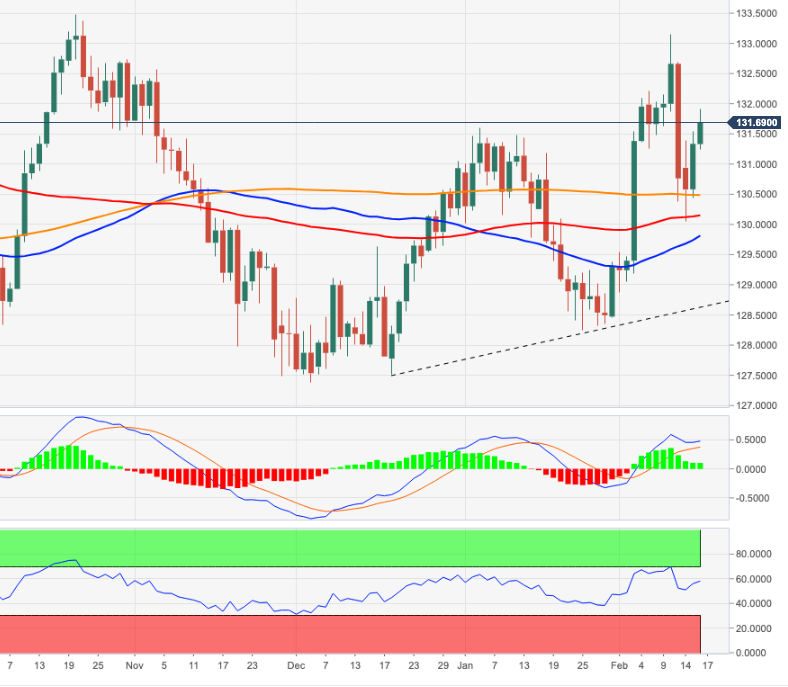
- A combination of supporting factors pushed GBP/USD higher for the second straight day.
- Receding Russia-Ukraine tensions undermined the safe-haven USD and extended support.
- Stronger UK CPI boosted BoE rate hike bets and provided an additional boost to the major.
- Brexit uncertainties capped gains ahead of US macro data and the FOMC meeting minutes.
The GBP/USD pair extended its steady intrada ascent through the mid-European session and climbed to a fresh weekly high, around the 1.3575 region in the last hour.
The pair built on the overnight bounce from the two-week low, around 1.3485 region, and gained traction for the second successive day on Wednesday. Receding Russia-Ukraine tensions continued undermining the safe-haven US dollar, which, in turn, was seen as a key factor that acted as a tailwind for the GBP/USD pair.
The British pound was further supported by hotter than expected UK consumer inflation, which rose at the fastest annual pace in nearly 30 years in January. In fact, the headline CPI edged higher to 5.5% YoY rate from 5.4% previous and strengthened the case for additional rate hikes this year by the Bank of England.
That said, tensions over the Northern Ireland Protocol held back traders from placing aggressive bullish bets around sterling and capped gains for the GBP/USD pair. Investors also seemed reluctant and preferred to wait on the sidelines ahead of the release of the FOMC meeting minutes, later during the US session.
It is worth mentioning that the markets have been expecting a more aggressive policy response by the Fed amid the persistent rise in inflationary pressures and pricing in a 50 bps rate hike in March. Hence, the minutes will be looked upon for clues about the likely pace of the Fed's policy tightening cycle.
This will play a key role in influencing the near-term USD price dynamics and provide some meaningful impetus to the GBP/USD pair. In the meantime, the US economic docket, highlighting the release of monthly Retail Sales, will be looked upon for short-term opportunities later during the early North American session.
Technical levels to watch
Russian Foreign Minister Sergei Lavrov said on Wednesday that Russia will retaliate should Britain decide to impose new sanctions against Moscow over the conflict with Ukraine, as reported by Reuters.
Last Thursday, Britain published new legislation to allow the government to impose tougher sanctions.
"The UK can now sanction not just those linked directly to the destabilisation of Ukraine, but also Government of Russia affiliated entities and businesses of economic and strategic significance to the Russian government, as well as their owners, directors and trustees," a foreign office statement said.
Market reaction
The GBP/USD pair edged lower on this headline and was last seen posting small daily gains at 1.3556.
EUR/CHF has rebounded sharply from the low of 1.0300. The pair is expected to test the 200-day moving average (DMA) located at 1.0700, economists Société Générale report.
Downside limited while above 1.0420
“Holding above the daily Ichimoku cloud at 1.0420, the bounce could persist.”
“Next potential resistance is located at the 200-DMA near 1.0700.”
See: EUR/CHF to enjoy substantial gains on a diplomatic solution in Ukraine – MUFG
- Industrial Production in the euro area rose at a stronger pace than expected in December.
- EUR/USD clings to daily gains, stays below 1.1400.
Industrial Production in the euro area increased by 1.2% on a monthly basis in December, Eurostat reported on Wednesday. This reading followed November's expansion of 2.4% but surpassed the market expectation of 0.3%. In the EU, Industrial Production was up 0.7%.
On a yearly basis, Industrial Production in the euro area and the EU grew by 1.6% and 2.5%, respectively.
Market reaction
These figures were largely ignored by market participants and the EUR/USD pair was last seen rising 0.2% on the day at 1.1380.
GBP/USD has managed to edge higher early Wednesday. As FXStreet’s Eren Sengezer reports, the pound needs sentiment boost to extend the rebound.
Cable could find it difficult to gather bullish momentum unless market sentiment continues to improve
“The risk perception is likely to remain the primary market driver. GBP/USD could lose its traction if market participants start to seek refuge.”
“On the upside, 1.3600 (psychological level) aligns as the next target before 1.3620 (static level).”
“Supports are located at 1.3550/1.3560 (200-period SMA, Fibonacci 23.6% retracement), 1.3520 (Fibonacci 38.2% retracement, 100-period SMA) and 1.3500 (psychological level).”
See: GBP/USD to post bullish technical signal on a move above 1.3710/1.3750 – SocGen
- Gold regained positive traction on Wednesday and reversed a part of the overnight steep fall.
- Modest USD weakness was seen as a key factor that benefitted the dollar-denominated metal.
- Easing geopolitical tensions, hawkish Fed expectations capped gains ahead of FOMC minutes.
Gold attracted some dip-buying near the $1,850 region on Wednesday and moved away from the weekly low touched the previous day. It is worth recalling that the XAU/USD witnessed a dramatic turnaround from the eight-month high on Tuesday after Russia announced a partial pullback of troops from the Ukraine border. This helped ease fears about a significant military action/confrontation with the West and triggered a fresh wave of the global risk-on trade, which, in turn, weighed heavily on the safe-haven metal.
The said, a broad-based US dollar weakness helped limit any further losses and assisted the dollar-denominated gold to regain some positive traction. The commodity maintained its bid tone through the first half of the European session and was last seen trading around the $1,857 region. The uptick, however, lacked bullish conviction amid expectations that the Fed would adopt a more aggressive policy to combat high inflation. This held back traders from placing fresh bullish bets around the non-yielding yellow metal.
The prospects for a faster policy tightening by the Fed, along with rising bets for a 50 bps rate hike in March were reinforced by elevated US Treasury bond yields. In fact, the yield on the benchmark 10-year US government bond held above the 2.0% threshold, closer to last week's swing high touched in reaction to the hottest inflation reading in four decades. Moreover, the 2-year, which are highly sensitive to rate hike expectations, stood tall near the highest level since May 2019 and acted as a headwind for gold.
Hence, the focus will remain glued to the release of the FOMC meeting minutes, due later during the US session. Investors will look for fresh clues about the likely pace of the Fed's policy tightening cycle, which, in turn, would determine the next leg of a directional move for gold prices. In the meantime, the US monthly Retail Sales data might provide some impetus to the XAU/USD. This, along with the US bond yields, the USD price dynamics and the broader market risk sentiment, would allow traders to grab some opportunities.
Technical outlook
From a technical perspective, the previous day's sharp pullback failed to validate a near-term bullish breakout through a downward sloping trend-line extending from June 2021 swing high. That said, the emergence of fresh buying on Wednesday still favours bullish traders and supports prospects for additional gains. Hence, a move back towards the $1,871 intermediate resistance, en-route the multi-month high near the $1,879-$1,880 region, remains a distinct possibility. Gold could eventually climb to reclaim the $1,900 mark for the first time since June 2021.
On the flip side, the $1,850 area, closely followed by the overnight swing low, around the $1,844 region, now seems to protect the immediate downside. A convincing break below might shift the near-term bias in favour of bearish traders and accelerate the corrective pullback towards the next relevant support near the $1,832-$1,830 region.
Gold daily chart
-637806029796535014.png)
Key levels to watch
USD/KRW has broken out from the consolidation since October denoting persistence in uptrend. Economists at Société Générale expect the pair to enjoy further gains towards 1217/1227.
Daily Ichimoku cloud support seen at 1189/1185
“USD/KRW is expected to inch higher towards projections of 1217/1227.”
“Daily Ichimoku cloud at 1189/1185 is short-term support.”
Crude prices rose for the eighth consecutive week last week amid continuing tensions over Ukraine. Oil is one of the most preferred assets in the global strategy of analysts at UBS who expect Brent Oil to reach the $100 level by year-end.
Oil to turn lower in the near-term on de-escalation of the crisis
“A further escalation could push up crude prices, particularly in the event of any supply disruption.”
“Any progress toward a peaceful resolution could lead to a near-term setback in prices toward the bottom of our expected range at $90/bbl.”
“Regardless of the situation in Ukraine, we think the outlook for oil remains positive, with prices likely to be supported by a fundamental imbalance in the global energy market.”
“We maintain our view that oil prices will continue to rise in the coming year and into 2023. We recently raised our Brent crude price forecasts to $95/bbl by June and $100/bbl by December.”
GBP/USD has staged a pullback after struggling to reclaim the 200-day moving average (DMA) near 1.3710/1.3750. A break above here would see cable completing an inverse head and shoulders pattern, economists at Société Générale report.
First potential support is at 1.3485/1.3455
“GBP/USD appears to be evolving within the right shoulder of a possible Inverse Head and Shoulders. The pattern would complete if the pair establishes itself above the neckline at 1.3710/1.3750.”
“First potential support is at 1.3485/1.3455 representing the trend line drawn since December. If this gets violated, a revisit of recent low at 1.3358 is not ruled out.”
“1.3630 caps immediate upside.”
A Kremlin spokesperson said on Wednesday that Russian President Putin is stressing his desire to negotiate, as reported by Reuters.
Additional takeaways
"It's positive that US President shows willingness to talk."
"It's welcome that Biden is thinking about the Russian people."
"It would be even better if Biden urged Ukrainian people to stop shooting each other."
"We are sick of threats being repeated against us like a mantra."
"Recognising the breakaway east Ukraine regions would not be in line with Minsk Peace Agreements."
"NATO is wrong to say there is no evidence of pullout by Russian forces."
Market reaction
Investors remain cautiously optimistic following these comments. As of writing, S&P futures were up 0.2% on a daily basis.
Strategists at UOB Group’s Global Economics & Markets Research review the latest decision by the PBoC.
Key Takeaways
“The People’s Bank of China (PBOC) left the 1Y Medium-Term Lending Facility Rate (MLF) rate unchanged at 2.85% on Tue, in line with the consensus forecast. The pause after the 10 bps cut to the 1Y MLF rate in Jan may have considered the stronger US Fed hike expectation as well as the strong rebound in Jan new aggregate financing. Nevertheless, the net CNY100 bn injection into the banking system with the 1Y MLF in Feb signals that the PBOC has stayed the path of monetary policy easing to shore up growth.”
“We expect the PBOC to guide the loan prime rate (LPR) lower in the coming MLF settings and maintain our call for the benchmark 1Y LPR to fall by another 15 bps to 3.55% by the end of 2Q22.”
- EUR/USD moves higher and trades closer to the 1.1400 mark.
- The relief-rally keeps propping up the rebound in the pair.
- EMU Industrial Production, US Retail Sales next on tap.
The optimism around the European currency remains well and sound and now lifts EUR/USD to the vicinity of the 1.1400 barrier.
EUR/USD up on risk trends, focuses on data, FOMC
EUR/USD advances for the second session in a row on Wednesday underpinned by the continuation of the relief rally in response to alleviating geopolitical concerns.
However, and despite the de-escalation of tensions in past hours, the situation in the Russia-Ukraine front remains delicate and is expected to keep driving the sentiment in the global markets for the time being.
Closer to home, the selloff in the German bond market lifts yields of the key 10y Bund to new tops above 0.33%, an area last visited back in December 2018. The uptick in German yields comes in contrast with the mild downside pressure in their US peers, resulting in a narrow yield spread and morphing into extra support for the pair.
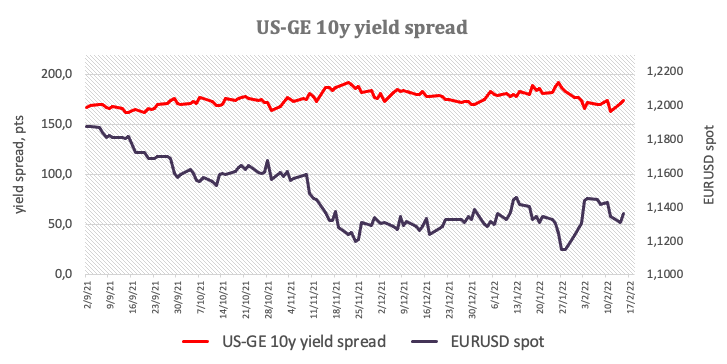
In the domestic calendar, Industrial Production in the euro bloc comes next ahead of Retail Sales and the FOMC Minutes due later in the NA session.
What to look for around EUR
EUR/USD continues to reclaim ground lost in past sessions on the back of the geopolitics-led relief rally. Looking at the broader scenario, the improvement in the pair’s outlook appears underpinned by fresh speculation of a potential interest rate hike by the ECB at some point by year end, higher German yields, persevering elevated inflation and a decent pace of the economic activity and other key fundamentals in the region
Key events in the euro area this week: EMU Industrial Production (Wednesday) – Flash EMU Consumer Confidence (Friday).
Eminent issues on the back boiler: Asymmetric economic recovery post-pandemic in the euro area. Speculation of ECB tightening/tapering later in the year. Presidential elections in France in April. Geopolitical concerns from the Russia-Ukraine conflict.
EUR/USD levels to watch
So far, spot is advancing 0.18% at 1.1378 and faces the next up barrier at 1.1395 (weekly high Feb.16) followed by 1.1491 (200-week SMA) and finally 1.1494 (2022 high Feb.10). On the other hand, a drop below 1.1326 (55-day SMA) would target 1.1279 (weekly low Feb.14) en route to 1.1186 (monthly low Nov.24 2021).
"So far we have not seen any de-escalation on the ground, not seen any signs of reduced Russian military presence on the borders of Ukraine," NATO Secretary General Jens Stoltenberg said on Wednesday, per Reuters.
"We will continue to convey the message we are prepared to talk," Stoltenberg added and said that they hope Russia chooses to engage in diplomacy.
"Messages on diplomacy from Moscow provide some ground for cautious optimism," he further noted but reminded that it remains to be seen whether there is Russian withdrawal.
Market reaction
These comments don't seem to be having a noticeable impact on risk sentiment. As of writing, Germany's DAX 30 Index was up 0.4% on the day and US stocks futures indexes were rising between 0.3% and 0.4%.
- A combination of factors dragged USD/CAD to a fresh weekly low on Wednesday.
- An uptick in oil prices underpinned the loonie and exerted downward pressure.
- The risk-on mood weighed on the safe-haven USD and added to the selling bias.
- Traders eye Canadian CPI, US Retail Sales and FOMC minutes for a fresh impetus.
The USD/USD pair witnessed some selling during the early European session and dropped to a fresh weekly low, around the 1.2685 region in the last hour.
Following a brief consolidation through the first half of the trading on Wednesday, the USD/USD pair met with a fresh supply and was pressured by a combination of factors. An uptick in crude oil prices underpinned the commodity-linked loonie. On the other hand, a generally positive risk tone continued weighing on the safe-haven US dollar, which, in turn, dragged the pair lower for the third successive day.
Russia said on Tuesday that some of its troops were returning to bases following exercises near the Ukraine border and eased fears about a full-blown conflict with the West. This triggered a fresh wave of the global risk-on trade, which was evident from the bullish moves across the equity markets and drove flows away from traditional safe-haven assets. That said, elevated US Treasury bonds should limit deeper USD losses.
The markets seem convinced that the Fed would tighten its policy at a faster pace than anticipated to combat stubbornly high inflation and have been pricing in the possibility of a 50 bps rate hike in March. This, in turn, pushed the yield on the benchmark 10-year US government bond back above the 2.0% mark, closer to last week's swing high touched in reaction to the hottest inflation reading in four decades.
Hence, the market focus will remain on the FOMC meeting minutes, due for release later during the US session. Investors will look for fresh clues about the likely pace of the Fed's policy tightening cycle, which will influence the near-term trajector for the USD and the USD/CAD pair. In the meantime, the Canadian CPI report and the US monthly Retail Sales data might produce some short-term trading opportunities.
Technical levels to watch
The consolidative phase in USD/CNH seems over and the cross could now grind lower to the 6.3230 level in the next weeks, commented FX Strategists at UOB Group.
Key Quotes
24-hour view: “After trading sideways for several days, the sudden lurch lower in USD came as a surprise. While the sharp and swift drop appears to be running ahead of itself, the weakness in USD has not stabilized. From here, barring a move above 6.3490 (minor resistance is at 6.3460), USD could weaken further even though Jan’s low near 6.3230 is unlikely to come under threat for now (there is another support at 6.3300).”
Next 1-3 weeks: “We have held the same view since last Monday (07 Feb, spot at 6.3600) where USD is in a consolidation phase and is expected to trade between 6.3400 and 6.3805. After more than a week, USD staged a sudden and sharp drop as it plummeted to a low of 6.3329 during NY session. The consolidation phase has ended and USD is likely to head lower and the level to monitor is at the Jan’s low near 6.3230. Only a break of the ‘strong resistance’ level, currently at 6.3585 would indicate that that our view for a lower USD is wrong. On a shorter-term note, 6.3490 is already quite a strong resistance level.”
- DXY stays on the defensive in the sub-96.00 zone.
- US yields correct a tad lower from recent peaks.
- The release of the FOMC Minutes will be in the limelight.
The greenback, in terms of the US Dollar Index (DXY), extends Tuesday’s pullback to the area below the 96.00 yardstick so far on Wednesday.
US Dollar Index focuses on FOMC, risk trends
The index retreats for the second session in a row and keeps challenging the 96.00 zone on the back of persistent appetite for the risk complex as well as the knee-jerk in US yields, all ahead of the opening bell in Euroland midweek.
Indeed, US yields come under some mild downside pressure, although they maintain the upper end of the range close to recent tops across the curve.
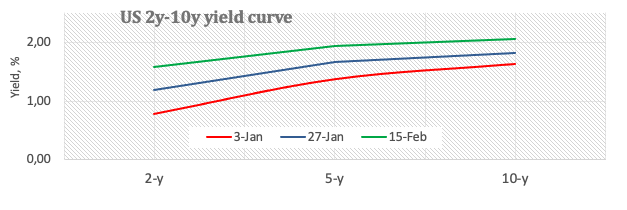
The dollar, in the meantime, continues to suffer positive news from the Russia-Ukraine front, although not without rising cautiousness, which has been sustaining the pick-up in the risk-on trade in past hours.
In the US calendar, the publication of the FOMC Minutes will take centre stage later in the NA session, although Retail Sales will also grab attention along with the weekly MBA Mortgage Applications.
What to look for around USD
The resumption of the appetite for riskier assets weighed on the greenback and forced DXY to recede from recent tops. However, the ongoing corrective downside is seen as temporary only, as the positive stance in the buck remains underpinned by the current elevated inflation narrative as well as the probability (bigger now) of a 50 bps rate hike by the Fed (instead of the more conventional 25 bps move) at the March gathering. Looking at the longer run, and while the constructive outlook for the greenback appears well in place for the time being, recent hawkish messages from the BoE and the ECB carry the potential to undermine the expected move higher in the dollar in the next months.
Key events in the US this week: MBA Mortgage Applications, Retail Sales, Industrial Production, NAHB Index, FOMC Minutes (Wednesday) – Building Permits, Housing Starts, Initial Claims, Philly Fed Manufacturing Index (Thursday) – CB Leading Index, Existing Home Sales (Friday).
Eminent issues on the back boiler: Escalating geopolitical effervescence vs. Russia and China. Fed’s rate path this year. US-China trade conflict under the Biden administration. Debt ceiling issue.
US Dollar Index relevant levels
Now, the index is losing 0.15% at 95.84 and a break above 96.43 (weekly high Feb.14) would open the door to 97.44 (2022 high Jan.28) and finally 97.80 (high Jun.30 2020). On the flip side, the next down barrier emerges at 95.17 (weekly low Feb.10) followed by 95.13 (weekly low Feb.4) and then 94.62 (2022 low Jan.14).
Bank of Japan (BOJ) Governor Haruhiko Kuroda said on Wednesday that Japan is not in a state to exit from the easy monetary policy, as reported by Reuters.
Additional takeaways
"BOJ's funding scheme to assist efforts on climate change not aimed at aiding bank profits, mitigating side-effect of monetary easing."
"JGB buying is necessary to achieve 2% inflation target."
"How much JGBs BOJ will buy to defend its yield target depends on market conditions at the time."
"BOJ's fixed-rate bond-buying offer was made in light of such unusual market situation."
"If market conditions become unusual again, BOJ will of course use tools such as fixed-rate market operation."
"Our basic approach is to buy a sufficient amount of bonds to allow 10-year JGB to move 25 basis points up and down each around our 0% target."
Market reaction
USD/JPY edged higher with the initial reaction to these comments and was last seen posting small daily gains at 115.75.
- AUD/USD gained traction for the second successive day on Wednesday and refreshed weekly high.
- A positive risk tone undermined the safe-haven USD and benefitted the perceived riskier aussie.
- Hawkish Fed expectations, elevated US bond yields should limit the USD losses and cap the pair.
- Investors look forward to the US Retail Sales data for some impetus ahead of the FOMC minutes.
The AUD/USD pair edged higher through the early European session and climbed to a fresh weekly high, around the 0.7175-0.7180 region in the last hour.
As investors looked past softer than expected Chinese inflation figures, the AUD/USD pair attracted fresh buying on Wednesday and built on the overnight goodish rebound from the 0.7100 mark. A generally positive risk tone continued undermining the safe-haven US dollar, which, in turn, was seen as a key factor that benefitted the perceived riskier aussie.
The global risk sentiment remained well supported by receding fears about a full-blown conflict between Russia and the West over Ukraine. Russia said that some of its troops were returning back to bases following exercises near the Ukraine border and eased concerns over a significant military action and triggered a fresh wave of the risk-on trade.
That said, the prospects for a faster policy tightening by the Fed should act as a tailwind for the greenback and cap the upside for the AUD/USD pair. In fact, the markets have been pricing in the possibility of a 50 bps Fed rate hike move in March. This was reinforced by elevated US Treasury bond yields, which should lend support to the buck.
Hence, the market focus remains on the FOMC meeting minutes, due for release later this Thursday, which will be looked upon for fresh clues about the likely pace of the Fed's policy tightening cycle. In the meantime, traders might prefer to wait on the sidelines, warranting some caution for aggressive bullish traders and positioning for any further gains.
On the economic data front, the US economic docket features the release of monthly Retail Sales figures later during the early North American session. This, along with the US bond yields, will influence the USD demand. Apart from this, the broader market risk sentiment could produce some trading opportunities around the AUD/USD pair.
Technical levels to watch
Economists at MUFG Bank still believe there is scope for EUR/CHF to keep moving higher in the near-term as they remain optimistic that a diplomatic solution will be found for a de-escalation of the Russia-Ukraine conflict.
Higher eurozone yields to help reverse downward pressure on EUR/CHF
“If we are about to revert to a period of focusing more on macro then rising yields in the eurozone and elsewhere should see EUR/CHF continue to grind higher.”
“If we got to a scenario of actual progress in dialogue with Russia then a more pronounced EUR/CHF move higher would be likely.”
The inflation data for January, due for publication today, is likely to once again underpin the necessity of a rate step by the Bank of Canada (BoC). This should underpin the Canadian dollar in the long-term, in the view of economists at ING.
USD/CAD to hover around 1.2700 this week
“The January CPI report in Canada today should see headline inflation stabilise marginally below 5.0%, while core measures may see a mild acceleration. All this should continue to underpin the need for the BoC to tighten policy quite aggressively in 2022.”
“We expect USD/CAD to hover around 1.2700 this week, but we continue to see downside risks prevailing in the longer run as the BoC tightening cycle should offer support to the loonie.”
See – Canadian CPI Preview: Forecasts from five major banks, not out of the woods yet
EUR/USD has gone into consolidation following Tuesday's rebound. Markets await clarity on the Russia-Ukraine conflict, which could propel the pair towards the 1.14 level, according to FXStreet’s Eren Sengezer.
Key support aligns in the 1.1340/1.1350 area
“A negative tilt in risk sentiment could make it difficult for the euro to continue to gather strength against the dollar and vice versa.”
“1.1400 (psychological level, Fibonacci 23.6% retracement of the latest uptrend, 50-period SMA) aligns as the next bullish target ahead of 1.1450 (static level) and 1.1480 (static level).”
“On the downside, the Fibonacci 38.2% retracement and the 200-period SMA seem to have formed key support in the 1.1340/1.1350 area ahead of 1.1320 (100-period SMA) and 1.1300 (psychological level, Fibonacci 50% retracement).”
See: EUR/USD to hit 1.14 on further de-escalation in Russia-Ukraine tensions – ING
Statistics Canada will release January Consumer Price Index (CPI) data on Wednesday, February 16 at 13:30 and as we get closer to the release time, here are the forecasts by the economists and researchers of five major banks regarding the upcoming Canadian inflation data.
The January CPI report in Canada is expected to see headline inflation stabilise marginally below 5.0%, while core measures are set to see a mild acceleration.
TDS
“We look for inflation to hold at 4.8% as prices rise 0.6% (0.5% SA) on broad-based strength, with upside risks to core CPI.”
NBF
“While we expect strong print for CPI ex-food and energy given labour shortages and supply chain issues, January headline could also have been upwardly impacted by surging gasoline prices (+5.1%). Otherwise, food inflation should have remained strong, driven by the upward rise in commodity prices. All in all, we expect a 0.6% increase before adjustments for seasonality (0.4% after seasonal adjustments), a print that would leave the annual inflation rate unchanged at 4.8%. We see the annual rate of the common CPI rising from 2.1% to 2.2%.”
CIBC
“Food prices are the main upward threat to our forecast, but given the timing of the latest transportation issues and an increase in dairy prices, February should see the largest gain in that area. Overall, we forecast a 0.5% unadjusted monthly increase in prices, with the annual rate holding steady at 4.8%.”
RBC Economics
“The Canadian CPI YoY growth rate is expected to have ticked down to 4.7% in January, little changed from December.”
Citibank
“Canada CPI NSA MoM (Jan) – Citi: 0.6%, median: 0.6%, prior: -0.1%; CPI YoY – Citi: 4.8%, median: 4.8%, prior: 4.8%. Generally, inflationary pressures remain elevated in H1’22r given persistent global supply issues impacting goods in particular, which has been one of the key drivers of inflation in Canada in recent months.”
Analysts at Credit Suisse expect continued upward momentum in USD/KRW as US yields rise, and think that the pair will trade higher in a 1,190-1,230 range.
Scope for further BoK tightening in 2022
“It is difficult to predict when uncertainty about Ukraine is finally resolved, but once the market re-focuses on Fed tightening, we think there will be continued upward momentum in USD/KRW as US yields rise, and that the pair will trade higher in a 1,190-1,230 range.”
“For the upcoming 24 February Bank of Kora (BoK) meeting our base case is no change to its policy rate, though there is some risk of another 25 bps hike. There is certainly scope for further tightening in 2022. “
“We think the next BoK tightening move will occur at the 14 April meeting. In the meantime a likely 50 bps Fed hike in March, along with lingering uncertainty about Ukraine, will likely push KRW and other high beta EM currencies weaker against the dollar.”
EUR/USD capitalized on the improving market mood and recovered to the 1.1350 area on Tuesday. Economists at ING believe the pair could target the 1.14 level amid heightened hopes for a de-escalation of the Russia-Ukraine conflict.
Room for a move to 1.1400
“EUR/USD climbed as markets turned more optimistic on a diplomatic resolution in Ukraine yesterday, and may remain bid today should geopolitical sentiment continue to improve.”
“Further de-escalation in Ukraine could aid a continuation of the rebound to 1.1400.”
The US Census Bureau will release the January Retail Sales report on Wednesday, February 16 at 13:30 GMT and as we get closer to the release time, here are the forecasts of economists and researchers of five major banks regarding the upcoming data.
Retail Sales are expected to rise by 1.6% on a monthly basis in January following December’s disappointing decrease of 1.9%.
TDS
“We look for retail sales to rebound strongly in January (TD: +2.0% MoM), following December's sharp 1.9% decline. Spending was likely aided by a surge in auto purchases and an improvement in restaurant sales, with the latter likely recovering from the Omicron impact. We also expect control group sales to gain some ground again following two consecutive declines in Nov-Dec.”
SocGen
“Consumer spending should be regaining some of its steam – at least for goods. In December spending on goods plunged. Yes, these are seasonally adjusted views, as it was a soft month. We expect a bounce in retail sales in January of +2.4% after 1.9% MoM plunge in December. Spending on new motor vehicles has already been reported to be up sharply”
NBF
“Car dealers should have contributed positively to the headline number, as auto sales surged in the month. Gasoline station receipts, for their part, may have decreased slightly judging from a marginal retreat in pump prices. All told, we expect headline sales to have jumped 2.4% on a monthly basis. Spending on items other than vehicles may have risen at a slightly weaker pace, rising 1.6%.”
CIBC
“Retail sales likely rebounded in January, but the expected 2.3% monthly growth will largely reflect higher prices and auto sales. The drop in gasoline prices will have held back receipts at gas stations, while restaurant reservations tapered off as Omicron spread, suggesting a more modest 0.8% gain in ex-auto spending. Sales in the control group (ex. autos, gasoline, restaurants, and building materials) could have risen by 1.0%, but that would entirely reflect price gains, as demand for goods is likely becoming saturated given that real spending on goods was still 4% above its pre-pandemic trendline as of December. We are less optimistic than the consensus on the control group which could be negative for the greenback and cause bond yields to fall.”
Wells Fargo
“We look for retail sales to bounce back and rise 2.1% in January.”
The 115.00 support held out after a test on Monday. Economists at OCBC Bank expect the USD/JPY pair to remain supported as the risk reversals have moved less in favour of USD/JPY downside.
Dips should be shallow
“While there is a chance of further declines on risk-off, our bias is that dips should be shallow, and there are better expressions of global risk-off than being short USD/JPY for now.”
“Look towards the Fed-BoJ divergence and the UST-JGB front-end yield spread to return as drivers should we see further de-escalation from here.”
- A positive risk tone undermined the safe-haven JPY and extended support to USD/JPY.
- Modest USD weakness held bulls on the defensive and capped the upside for the pair.
- Hawkish Fed expectations, elevated US bond yields should act as a tailwind for the USD.
- Investors now eye US Retail Sales for some impetus ahead of the FOMC meeting minutes.
The USD/JPY pair traded with a mild positive bias through the early European session and was last seen hovering near the daily high, around the 115.70 region.
Following the previous day's good two-way price moves, the USD/JPY pair edged higher on Wednesday and seems all set to build on this week's bounce from the key 115.00 psychological mark. Receding fears about a conflict between Russia and the West over Ukraine remained supportive of a generally positive risk tone. This, in turn, undermined the Japanese yen's safe-haven status and extended some support to the USD/JPY pair.
On the other hand, the US dollar witnessed subdued/range-bound price action through the first half of the trading and failed to impress bulls or provide an additional lift to the USD/JPY pair. That said, the prospects for a faster policy tightening by the Fed, reaffirmed by elevated US Treasury bond yields, should act as a tailwind for the greenback. This supports prospects for a further appreciating move for the major.
The markets seem convinced that the Fed would adopt a more aggressive policy response to combat stubbornly high inflation and have been pricing in a 50 bps rate hike in March. Hence, the focus will remain glued to the FOMC meeting minutes, due for release later during the US session. Investors will look for clues about the pace of the Fed's policy tightening cycle, which would influence the near-term USD price dynamics.
In the meantime, the US monthly Retail Sales data, along with the US bond yields will drive the USD demand and provide some impetus to the USD/JPY pair. Apart from this, the broader market risk sentiment should allow traders to grab some short-term opportunities.
Technical levels to watch
Economists at Credit Suisse revise their EUR/SEK target higher from 10.14 to 10.35 following last week’s dovish Riksbank surprise.
Scarce opportunity for monetary policy led gains in SEK in the near-term
“We revise our EUR/SEK target from 10.14 to 10.35, a level that we believe accounts for the still-constructive fundamental story behind the krona, but also reflects the risks that the Riksbank continues to drag its feet behind its more hawkish central bank peers.”
“Our 10.35 EUR/SEK target is admittedly only likely to come into play closer to the 28 April Riksbank meeting.”
See: EUR/SEK to drift lower toward 10.20 as Riksbank announces hawkish pivot in coming months – Rabobank
- GBP/USD gained traction for the second successive day amid modest USD weakness.
- A positive risk tone was seen as a key factor that undermined the safe-haven buck.
- Stronger UK CPI acted as a tailwind for the British pound and remained supportive.
- Traders now await US Retail Sales and FOMC meeting minutes for a fresh impetus.
The GBP/USD pair maintained its bid tone above mid-1.3500s heading into the early North American session and had a rather muted reaction to the UK inflation report.
The pair edged higher for the second successive day on Wednesday and recovered further from the two-week low, around the 1.3485 region touched in the previous session. The global risk sentiment remained well supported by receding fears about a conflict between Russia and the West over Ukraine. This, in turn, continued weighing the safe-haven US dollar and extended some support to the GBP/USD pair.
On the other hand, the British pound was underpinned by Tuesday's stronger UK wage growth figures and hotter than expected UK consumer inflation data released this Wednesday. In fact, the headline UK CPI edged higher to 5.5% YoY rate in January as against the 5.4% anticipated and the previous. Adding to this, the core CPI, which excludes food and energy prices, rose to 4.4% YoY from 4.2% in December.
The incoming macro releases have bolstered the case for additional monetary policy tightening by the Bank of England, which, in turn, continued acting as a tailwind for sterling. That said, tensions over the Northern Ireland Protocol might hold back bulls from placing aggressive bets. Apart from this, the prospects for a 50 bps Fed rate hike in March should limit the USD losses and cap the GBP/USD pair.
Hence, it will be prudent to wait for strong follow-through buying before positioning for any further appreciating move. Market participants now look forward to the US economic docket, highlighting the release of monthly Retail Sales data. The focus, however, will remain on the FOMC meeting minutes, which will influence the USD demand and provide a fresh directional impetus to the GBP/USD pair.
Technical levels to watch
Here is what you need to know on Wednesday, February 16:
The positive shift witnessed in market sentiment on heightened hopes for a de-escalation of the Russia-Ukraine conflict allowed risk flows to dominate the financial markets on Tuesday. Investors, however, remain cautious early Wednesday after US President Joe Biden noted that a Russian attack on Ukraine was still very much a possibility. Later in the day, January Retail Sales and Industrial Production data will be featured in the US economic docket. More importantly, the US Federal Reserve will release the minutes of the January policy meeting at 1900 GMT.
FOMC Minutes Preview: Dollar selling opportunity? Doves set for a comeback after hawkish meeting.
Russian President Vladimir Putin said on Tuesday that Russia does not want to go into war with Europe and announced that the decision on a "partial withdrawal of troops" had been taken. Later in the day, Putin said they were not satisfied with the assurance that Ukraine will not become a NATO member in near future. Nevertheless, Wall Street's main indexes gained more than 1% on Tuesday and the 10-year US Treasury bond yield rose 3%. The US Dollar Index snapped a three-day winning streak before going into a consolidation phase near 96.00 early Wednesday.
Earlier in the day, the data from China revealed that the Consumer Price Index (CPI) declined to 0.9% on a yearly basis in January from 1.5% in December. This print came in lower than the market expectation of 1% but failed to trigger a noticeable market reaction.
EUR/USD capitalized on the improving market mood and recovered to the 1.1350 area on Tuesday. The pair is moving sideways near mid-1.1300s in the early European session. Eurostat will publish December Industrial Production data later in the session.
GBP/USD clings to modest daily gains above 1.3550. The data published by the ONS showed on Wednesday that inflation in the UK, as measured by the CPI, edged higher to 5.5% on a yearly basis in January, surpassing the market expectation of 5.4%.
Gold lost nearly 1% and dropped to the $1,850 area, pressured by surging US Treasury bond yields. The precious metal is staying relatively quiet early Wednesday as investors eye fresh developments surrounding the Ukraine-Russia conflict.
Despite the renewed dollar weakness, USD/JPY managed to close in the positive territory on Tuesday with the safe-haven JPY struggling to find demand. The pair is posting small daily gains above 115.50.
Bitcoin received a boost from risk flows on Tuesday and rose nearly 5% on a daily basis. BTC/USD is down modestly near $44,000 early Wednesday. Ethereum gained 9% and touched $3,200 before retreating toward $3,100.
Gold price is treading waters while consolidating Tuesday’s slump as bears take a breather ahead of the critical January Fed meeting’s minutes amid geopolitical tensions. As FXstreet’s Dhwani Mehta notes, gold bulls remain hopeful while above the 38.2% Fibonacci Retracement level (Fibo) at $1,842.
Bullish potential remains intact
“The FOMC minutes could temper the market’s pricing of an anggressive rate hike this year. Any dovish surprise will trigger a fresh selling wave in the US dollar, reviving the demand for gold. However, the incoming Russia-Ukraine developments will be also closely followed for any unexpected market reaction.”
“Gold found support just above $1,842, the 38.2% Fibo level of the rally from January 28 to the three-month top of $1,880. If the 38.2% Fibo support is breached, then a drop towards the confluence of the bullish 21-Daily Moving Average (DMA) and the 50.0% Fibo level at $1,830 cannot be ruled. The 61.8% Fibo level at $1,819 will be the level to beat for gold bears.”
“Bulls are looking to recapture the 23.6% Fibo level at $1,857. The next upside barrier is seen at the previous week’s high of $1,866, above which doors will reopen for a fresh upswing towards the multi-month peak.”
See – Gold Price Forecast: XAU/USD to climb as high as $1,923/1,930 – SocGen
- UK CPI rises by 5.5% YoY in January vs. +5.4% expected.
- Monthly UK CPI arrives at -0.1% in January vs. -0.4% expected.
- GBP/USD little changed above 1.3550 on upbeat UK CPIs.
The UK Consumer Prices Index (CPI) 12-month rate came in at 5.5% in January when compared to +5.4% registered in December while beating expectations of a +5.4% print, the UK Office for National Statistics (ONS) reported on Wednesday.
Meanwhile, the core inflation gauge (excluding volatile food and energy items) rose by 4.4% YoY last month versus +4.2% booked in December, exceeding the consensus forecast of +4.3%.
The monthly figures showed that the UK consumer prices arrived at -0.1% in January vs. -0.4% expectations and +0.5% prior.
Main points (via ONS):
“The largest upward contributions to the January 2022 CPIH 12-month inflation rate came from housing and household services (1.37 percentage points) and transport (1.24 percentage points, principally from motor fuels and second-hand cars).”
“The largest upward contributions to the change in the CPIH 12-month inflation rate between December 2021 and January 2022 came from clothing and footwear, housing and household services, and furniture and household goods.”
“These were partially offset by large downward contributions to change from restaurants and hotels, and transport.”
FX implications:
In an initial reaction to the upbeat UK CPI numbers, the GBP/USD pair hit daily highs of 1.3556 before reversing slightly to 1.3352, where it now wavers. The spot is up 0.14% on the day. All eyes now remain on the Fed minutes and geopolitical updates over Russia and Ukraine.
Early Wednesday morning in Europe, Bloomberg quotes oil futures data to hint at the tightening in the market.
“A vital corner of the crude market is flashing increasingly bullish signs, even as oil futures whipsawed with investors digesting the latest updates from the developing situation between Russia and Ukraine,” states the news.
Additional quotes
The premium of Brent oil’s front-month contract to the second month -- known as prompt timespread -- expanded further after reaching the widest bullish backwardation structure since 2019 earlier this week.
Spreads are typically a good indicator of underlying supply-demand dynamics, while individual futures contracts can gyrate on jitters including geopolitical risks.
Physical oil markets across the world have tightened as stockpiles dwindle and consumption rebounds.
While American producers are boosting output as futures near $100 a barrel, OPEC+ suppliers are consistently falling behind their output targets.
Demand has improved as more economies reopen, though energy costs and inflation may soon rise to levels that erode use.
Market implications
The news joins comments from Executive Director of the International Energy Agency (IEA) Fatih Birol to help WTI crude oil to stay mildly bid around $90.50. That said, EIA’s Birol mentioned, “Hope additional oil output from the US and Brazil will ease pressure on prices.”
Also supporting oil prices could be comments from Ukraine Defense Minister who said, “Latest threat assessments are consistent with earlier views and do not contain anything unexpected.”
Read: WTI pares biggest daily losses in 10-weeks, focus on China inflation, Russia, Fed Minutes
- Palladium prices consolidate the biggest daily loss since November, retreats from intraday high of late.
- Weekly horizontal support, two-month-long rising trend line challenges bears.
- Key SMAs, monthly resistance line test buyers amid bearish MACD signals.
Palladium (XPD/USD) pares intraday gains around $2,245, up 0.70% on a day heading into Wednesday’s European session.
The bullion dropped the most since late November the previous day before bouncing off $2,210.
The recovery moves, however, remain below important moving averages and descending trend line from January 31 amid bearish MACD signals, which in turn keeps sellers hopeful.
Though, lows marked since February 07, around $2,195, will restrict short-term declines of the metal. Should the quote drops below $2,195, an ascending support line from mid-December 2021, close to $2,155, will be critical to watch.
Meanwhile, 50-SMA and 100-SMA, respectively around $2,270 and $2,305, restrict the short-term upside of the XPD/USD.
Following that, the stated short-term resistance line near $2,350 will challenge palladium buyers ahead of directing them to the January peak close to $2,415.
XPD/USD: Four-hour chart

Trend: Pullback expected
- EUR/USD holds the recent gains near 1.1350 ahead of Fed, US data.
- Ukraine tensions keep markets on the edge, cap the pair’s upside.
- 1.1325 offers strong support while 100-DMA appears a key resistance.
EUR/USD is lacking a clear directional bias so far this Wednesday, as the risk sentiment remains tentative amid the Russia-Ukraine crisis while heading into the US Retail Sales and the Fed minutes release.
Markets remain in a wait-and-see mode, likely awaited response from the Russian President Vladimir Putin to his US counterpart’s skeptical comments on the former’s troops' withdrawal and prospects for a de-escalation.
Meanwhile, the US dollar licks its wounds amid sluggish Treasury yields, as traders refrain to place any fresh directional bets ahead of the key US event risks.
EUR/USD bulls deified the bearish odds-on Tuesday amid a sudden turnaround in the market sentiment. However, bulls appear rather cautious, unable to extend the previous upsurge, as seen on the major’s daily chart.
The price is gathering strength to retest the critical resistance area near 1.1370, above which a rally towards the mildly bearish 100-Daily Moving Average (DMA) at 1.1403 will be on the cards.
If bulls keep insisting, then the 1.1450 psychological barrier will come into the picture.
The 14-day Relative Strength Index (RSI), remains flat but above the midline, supporting the bullish view.
EUR/USD: Daily chart
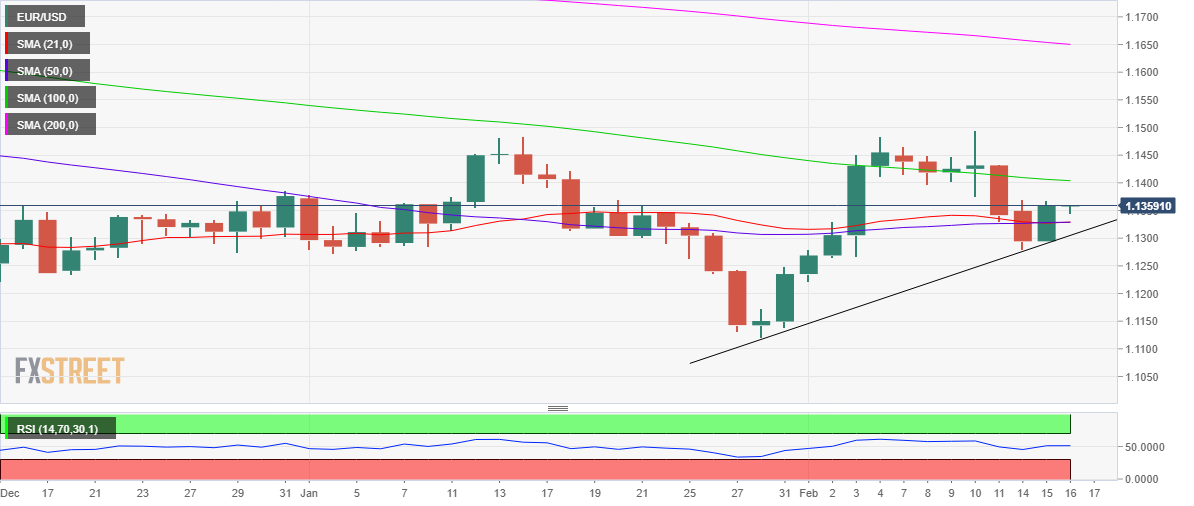
On the other side, bears will fight back control if the 1.1325 key support gives way. That level is the confluence of the 21 and 50-DMAs.
Additional declines will test Monday’s low of 1.1280, below which the February 3 low of 1.1267 will be on the sellers’ radars.
EUR/USD: Additional levels to consider
USD/JPY is still seen trading within the 114.75-116.05 range in the short term, in opinion of FX Strategists at UOB Group.
Key Quotes
24-hour view: “Yesterday, we expected USD to ‘to consolidate and trade between 115.10 and 115.80’. USD subsequently traded within a higher range than expected (115.24/115.87). Upward momentum has improved a tad and the bias is on the upside. That said, any advance is not expected to break the major resistance at 116.05. On the downside, a breach of 115.40 (minor support is at 115.55) would indicate that the current upward pressure has eased.”
Next 1-3 weeks: “There is not much to add to our update from Monday (14 Feb, spot at 115.40). As highlighted, the current movement is viewed as part of a consolidation and USD is likely to trade between 114.75 and 116.05 for now.”
- USD/CAD remains pressured around weekly low, on the back foot for the third consecutive day.
- DXY tracks yields to pare recent gains as market sentiment improves on easing Russia-linked fears.
- Canada CPI, FOMC Minutes and US Retail Sales will decorate the calendar.
USD/CAD stays depressed around 1.2710, down 0.14% intraday heading into Wednesday’s European session.
In doing so, the Loonie pair drops for the third consecutive day as the US dollar pares some of its latest gains. Also favoring the USD/CAD bears is the recently firmer WTI crude oil, the biggest export earner of Canada.
That said, the US Dollar Index (DXY) retreats from daily top to 95.98 by the press time, after declining the most in two weeks the previous day. Further, the WTI crude oil prices print mild gains around $90.35-40 at the latest.
Behind the moves could be diffusing geopolitical tensions surrounding Russia. Hopes of no further escalation in the Russia-Ukraine tussles gained momentum after Moscow rolled back some of its troops from borders, which in turn favored the Wall Street benchmarks and weighed on prices of gold and crude the previous day.
Also acting as a bearish catalyst is the mixed US data and anxiety ahead of today’s key data/events.
It’s worth noting that, the US Producer Price Index (PPI) data showed a hot factory-gate inflation figure supporting the Fed’s rate-hike concerns. That said, the PPI rose past 9.1% YoY expectations to 9.7%, versus upwardly revised 9.8% prior, in January whereas the Producer Price Index ex Food & Energy, also known as Core PPI, rallied to 8.3% versus 7.9% market consensus. Additionally, NY Empire State Manufacturing Index eased below 12.15 forecasts to 3.1, compared to -0.7 previous readouts.
While portraying the mood, the US 10-year Treasury yields remain pressured around 2.0% whereas S&P 500 Future dropped 0.20% intraday at the latest. Additionally, the Asia-Pacific shares edge high by the press time.
Looking forward, January Retail Sales from the US, expected to reverse -1.9% previous contraction with +2.0% growth, will join the BOC Consumer Price Index Core, market consensus +4.6% YoY versus +4.0% prior, for the stated month to direct immediate moves. Following that, Federal Open Market Committee (FOMC) Minutes will be crucial amid 0.50% rate hike concerns. Above all, risk catalysts and oil price moves will be important to watch for clear direction.
Technical analysis
After multiple failures to cross a downward sloping trend line from January 06, USD/CAD broke a one-week-old rising support line the previous day. The bearish bias also gains support from the RSI line. However, a clear downside break of the 50-SMA on the four-hour chart, around 1.2715 by the press time, becomes necessary for the sellers.
Considering advanced prints from CME Group for natural gas futures markets, open interest rose for the second consecutive session on Tuesday, this time by around 7.5K contracts. Volume followed suit and went up by almost 30K contracts, partially reversing the previous daily drop.
Natural Gas now targets $5.00 and above
Prices of the natural gas extended the rebound on Tuesday amidst rising open interest and volume, which remains supportive of the continuation of the uptrend in the very near term at least. Against that, the uptrend should initially target the key $5.00 mark per MMBtu for the time being.
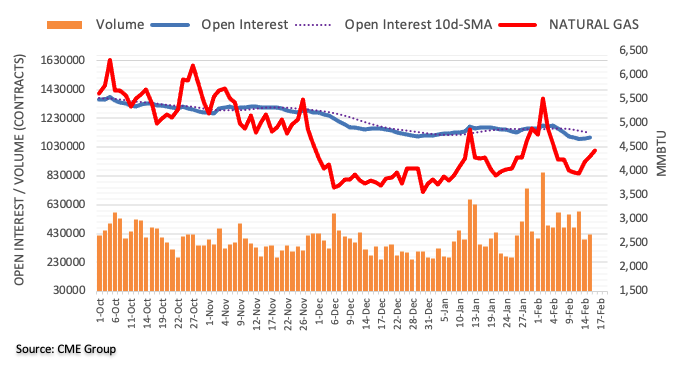
UOB Group’s FX Strategists still see AUD/USD navigating within the 0.7055-0.7210 range in the next weeks.
Key Quotes
24-hour view: “Yesterday, we highlighted that ‘downward pressure has eased’ and AUD ‘is likely to trade sideways within a range of 0.7105/0.7160’. Our view was not wrong as AUD traded between 0.7103 and 0.7156. Further sideway-trading appears likely even though the slightly firmed underlying tone suggests a higher range of 0.7115/0.7175.”
Next 1-3 weeks: “Our latest narrative was from last Friday (11 Feb, spot at 0.7150) where we highlighted that the outlook for AUD appears to be neutral and we expected AUD to trade within a range of 0.7055/0.7240. There is no change in our view even though a 0.7055/0.7210 range is likely enough to contain the price actions for now.”
CME Group’s flash data for crude oil futures markets saw traders scaling back their open interest positions for the third straight session on Tuesday, this time by around 9.4K contracts. Volume, instead, resumed the upside and went up by more than 54K contracts.
WTI: Initial support comes around $88.50
Crude oil prices dropped sharply on Tuesday after hitting fresh 7-year tops during the previous session. The move, however, was in tandem with shrinking open interest, which diminishes the probability of a deeper retracement in the very near term. The increase in volume, in the meantime, could still drag prices of the WTI lower and retest the $88.50 region.
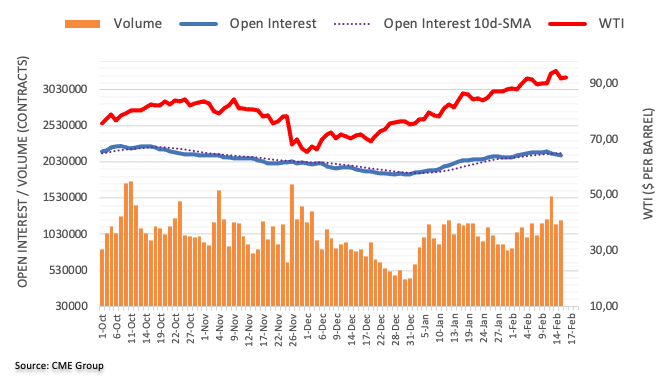
Cable is expected to extend the side-lined mood within the 1.3450-1.3645 range for the next weeks, suggested FX Strategists at UOB Group.
Key Quotes
24-hour view: “Yesterday, we highlighted that ‘despite the decline, downward momentum has barely improved and GBP is unlikely to weaken much further’ and we expected GBP to ‘trade between 1.3490 and 1.3570’. Our view was not wrong as GBP rose to 1.3567, dropped to 1.3488 before rebounding quickly to end the day little changed at 1.3542 (+0.07%). The relatively choppy price actions have resulted in a mixed outlook. Further choppy trading would not be surprising, likely within a range of 1.3500/1.3590.”
Next 1-3 weeks: “Our view from last Friday (11 Feb, spot at 1.3550) still stands. As highlighted, GBP is likely trade between 1.3450 and 1.3645 for now.”
Open interest in gold futures markets shrank by around 1.1K contracts after seven consecutive daily advances on Tuesday according to preliminary readings from CME Group. In the same line, volume dropped for the second session in a row, this time by around 18.3K contracts.
Gold keeps targeting $1,880
Tuesday’s strong correction in prices of gold was on the back of shrinking open interest and volume, hinting at the idea that a deeper pullback seems unlikely in the very near term at least. That said, the resumption of the upside in the yellow metal is expected to re-target the recent peak around $1,880 per ounce troy.
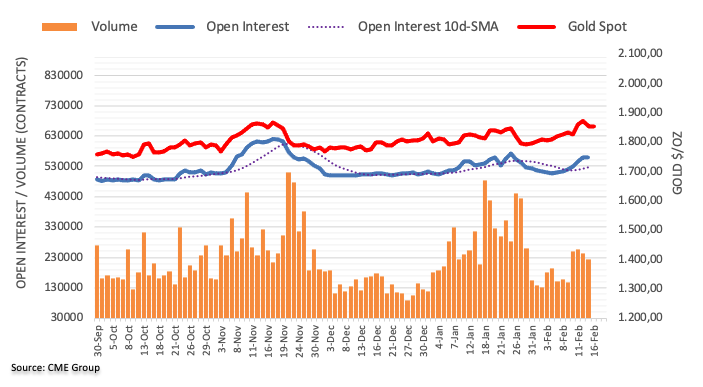
- USD/CHF maintains the weekly trading range between 0.9245-40 and monthly horizontal resistance.
- Momentum retreat hints at further weakness, 200-SMA adds to the downside filters.
USD/CHF struggles for a clear direction around 0.9250 ahead of Wednesday’s European session.
In doing so, the Swiss (CHF) currency pair keeps the weekly trading range of around 40 pips.
That said, the recently easing Momentum line hints at the quote’s pullback towards the 0.9245-40 support zone retest, comprising 100-SMA and an ascending support line from January 21.
Should the quote breaks 0.9240, the 200-SMA level near 0.9205 and the 0.9200 threshold will challenge the USD/CHF bears.
Meanwhile, an upside clearance of a five-week-long horizontal area, near 0.9275-80, will direct the quote towards the 0.9300 round figure.
Following that, the previous month’s high near 0.9345 and top marked during November 2021, around 0.9375, will gain the market’s attention.
USD/CHF: Four-hour chart
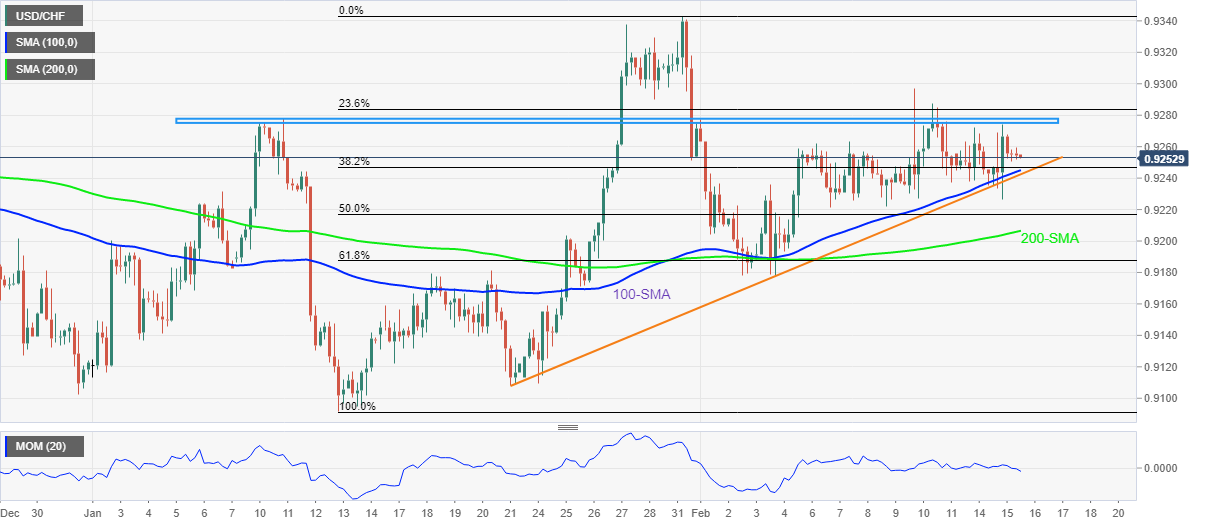
Trend: Further weakness expected
FX Strategists at UOB Group noted EUR/USD risks further downside while below the 1.1400 level.
Key Quotes
24-hour view: “Our view for EUR to ‘weaken further’ amid oversold conditions was wrong as it rebounded sharply to end the day higher by 0.45% (1.1356). While upward momentum has not improved by much, there is room for the rebound to extend. That said, any advance is unlikely to threaten the strong resistance at 1.1400 (1.1380 is already quite a strong level). On the downside, a breach of 1.1315 (minor support is at 1.1335) would indicate that the current mild upward pressure has eased.”
Next 1-3 weeks: “Yesterday (15 Feb, spot at 1.1305), we highlighted that EUR is likely to weaken further and the next level to watch is at 1.1240. We did not anticipate the subsequent sharp rebound. However, our ‘strong resistance’ level at 1.1400 is still intact and there is no change in our view for now. That said, oversold shorter-term conditions suggest that it may take a while before EUR head lower again. Overall, the downside risk is intact unless EUR moves above 1.1400 (no change in ‘strong resistance’ level from yesterday).”
- Asia-Pacific markets remain firmer as fears of Russia invasion ebb.
- Softer China inflation, mixed concerns Fed’s next moves also help equities.
- US T-bond yields snap two-day uptrend, stock futures struggle with mild losses.
- FOMC Minutes will be crucial to watch, geopolitics is important too.
Asian traders track global moves while snapping the previous two-day downtrend during Wednesday. The reason could be linked to hopes of no further escalation in the Russia-Ukraine tussles after Moscow rolled back some of its troops from borders.
While portraying the mood, MSCI’s index of Asia-Pacific shares outside Japan rises 1.0% whereas Japan’s Nikkei 225 rises the most since November 2021, up 2.25% heading into the European session.
Elsewhere, Chinese equities benefit from expectations of further monetary policy easing by the People’s Bank of China (PBOC), following downbeat China inflation, while Aussie shares follow upbeat Westpac Leading Index and China stocks to propel ASX 200 with 1.0% at the latest. Furthermore, New Zealand’s NZX 50 rise 1.50%, rebounding from a two-week low.
Moving on, South Korea’s KOSPI adds nearly 2.0% even as the nation registers an uptick in January Unemployment Rate to 3.6%, versus 3.5% expected and 3.8% prior. Additionally, Indonesia’s IDX Composite follows the trend to print mild gains but India’s BSE Sensex bucks the trend, down 0.25% intraday at the latest, amid market’s anxiety with hopes of Reserve Bank of India’s (RBI) monetary policy tightening.
Elsewhere, the US 10-year Treasury yields and stock futures remain on the back foot by the press time. That said, the price of WTI crude oil remains indecisive near a multi-day high but gold keeps the previous day’s pullback from the eight-month peak.
Moving on, January Retail Sales from the US and Federal Open Market Committee (FOMC) Minutes will be crucial to follow for fresh impulse whereas geopolitical/trade headlines from Russia and China can also entertain traders.
Read: US yet to verify pull back of Russian troops, yet risk-on ahead of European open
The UK CPIs Overview
The cost of living in the UK as represented by the Consumer Price Index (CPI) for January month is due early on Wednesday at 07:00 GMT. Given the recently strong employment data, coupled with the push for the Bank of England (BOE) rate hikes, today’s inflation numbers will be watched closely by the GBP/USD traders.
The headline CPI inflation is expected to remain unchanged with 5.4% YoY figures for January while the Core CPI, which excludes volatile food and energy items, is likely to rise a bit to 4.3% YoY during the stated month, from 4.2% previous readouts. Talking about the monthly figures, the CPI could ease to drop to -0.4% versus +0.5% prior.
It’s worth noting that the recent pressure on wage prices and a light workforce also highlights the Producer Price Index (PPI) as an important catalyst for the immediate GBP/USD direction. That being said, the PPI Core Output YoY may rise from 8.7% to 9.0% on a non-seasonally adjusted basis whereas the monthly prints may improve to 0.7% versus 0.5% prior. Furthermore, the Retail Price Index (RPI) is also on the table for release, expected to remain intact at 7.5% YoY, likely declining to -0.4% MoM in January versus 1.1% previous readings.
In this regard, analysts at TD Securities said,
In any case, the BoE is set to pay close attention to this print, and while an upside surprise could push them to turn more hawkish, the Bank will likely not react too much to a downside surprise as inflation is set to peak above 7% in April when the temporary VAT decrease is removed and the increased Ofgem price cap comes into effect.
How could it affect GBP/USD?
GBP/USD remains sidelined around 1.3540 during Wednesday’s Asian session, after bouncing off a two-week-low the previous day. The pair’s latest lackluster performance could be linked to the market’s anxiety over the Russia-Ukraine issue, as well as cautious sentiment ahead of the key UK data.
It’s worth noting that mixed updates concerning Brexit and UK politics also play their roles to challenge the cable pair’s latest moves.
That said, an escalating pressure on the global central banks to tame inflation signals the GBP/USD pair’s upside should the scheduled data portray upbeat figures. It’s worth noting that the price pressure jumped to a 30-year high during the latest readings and any more advances won’t hesitate to offer another rate hike in March, as widely anticipated.
In this regard, FXStreet’s Dhwani Mehta says
Should UK CPI meet estimates, GBP/USD may witness a temporary advance, which could quickly die down. In case, the reading disappoints with sub-5% print, then it could pour cold water on BOE’s tightening plans and knock down the currency pair towards the recent range lows near 1.3490.
Key notes
GBP/USD keeps bounce off two-week low around 1.3550 ahead of UK inflation
UK Inflation Preview: December’s 30-year top appears at risk; pound has room to rise
About the UK CPIs
The Consumer Price Index released by the Office for National Statistics is a measure of price movements by the comparison between the retail prices of a representative shopping basket of goods and services. The purchasing power of GBP is dragged down by inflation. The CPI is a key indicator to measure inflation and changes in purchasing trends. Generally, a high reading is seen as positive (or bullish) for the GBP, while a low reading is seen as negative (or Bearish).
- Gold price remains at the mercy of the geopolitical woes, Fed’s sentiment.
- The January FOMC minutes could playdown the hawkish prospects.
- US January Retail Sales Preview: Geopolitics, FOMC Minutes to impact dollar’s valuation.
The week so far has been quite overwhelming for gold price, with more action foreseen on the critical event risks from the US. The Fed minutes and the US Retail Sales will grab the market’s attention away from the ongoing theme around the Russia-Ukraine geopolitical tensions. Although, the risks around the Ukrainian border persist and will continue to lead the sentiment alongside the Fed’s hawkish outlook in the upcoming sessions.
Read: FOMC Minutes Preview: Dollar selling opportunity? Doves set for a comeback after hawkish meeting
Gold Price: Key levels to watch
As well predicted, gold price did test the $1,878 resistance zone before plummeting on a sudden turnaround in the market sentiment.
Looking ahead, the Technical Confluences Detector shows that the downside in the gold price has been capped around the $1,852-$1,850 region so far, which is the convergence of the previous month’s high, Fibonacci 23.6% one-day and one-week.
A firm break below the latter will fuel a fresh decline towards the previous day’s low of $1,845.
Further south, the intersection of the pivot point one-month R1 and Fibonacci 38.2% one-week at $1,843 will come to the rescue of gold bulls.
The pivot point one-day S1 at $1,838 will emerge as the last line of defense should the corrective downside extend.
On the flip side, gold price needs to find acceptance above $1,859, where the Fibonacci 38.2% one-day coincides with the Bollinger Band one-hour Upper.
The next bullish target is seen at the SMA10 four-hour of $1,862, above which powerful resistance at $1,866 will get retested.
At the point, the Fibonacci 61.8% one-day and the previous week’s high connect.
Here is how it looks on the tool
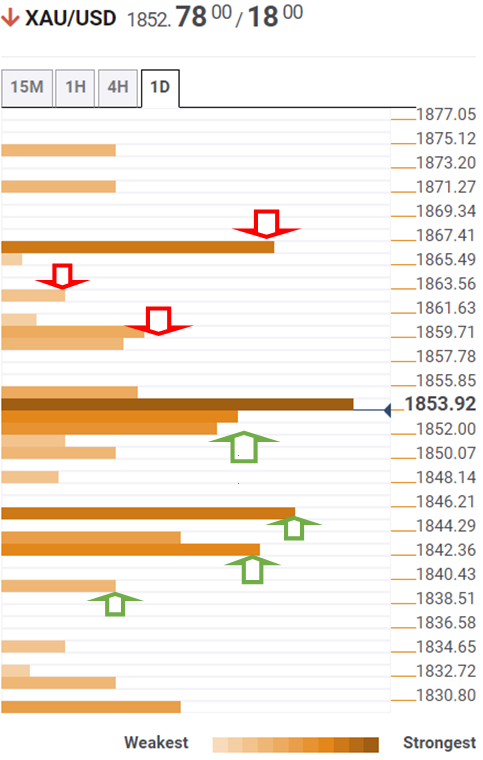
About Technical Confluences Detector
The TCD (Technical Confluences Detector) is a tool to locate and point out those price levels where there is a congestion of indicators, moving averages, Fibonacci levels, Pivot Points, etc. If you are a short-term trader, you will find entry points for counter-trend strategies and hunt a few points at a time. If you are a medium-to-long-term trader, this tool will allow you to know in advance the price levels where a medium-to-long-term trend may stop and rest, where to unwind positions, or where to increase your position size.
- USD/INR struggles to extend the bounce off weekly low, consolidates biggest daily loss in two weeks.
- Bearish MACD signals, multiple hurdles to the north signal challenges for buyers.
- Monthly support line, 200-SMA act as strong support.
USD/INR fades corrective pullback from short-term key support above 75.00 during Wednesday's Asian session. That said, the Indian rupee (INR) pair retreats to 75.25 by the press time.
In addition to the failure to keep rebound from the weekly bottom, also comprising the 50% Fibonacci retracement (Fibo.) of the December-January downturn, bearish MACD signals also hint at the quote’s another attempt to break the stated crucial support near 75.15.
Following that, an upward sloping trend line from January 12, near 74.90, as well as the 200-SMA level of 74.62, will challenge the USD/INR sellers.
In a case where the pair remains bearish past 74.62, December 2021 bottom surrounding 74.10 may entertain the bears ahead of January 2022 low close to 73.70.
Meanwhile, January’s top of 75.35 and the 61.8% Fibo. around 75.50 restrict short-term upside momentum of the USD/INR prices.
Also acting as an upside hurdle is the monthly top near 75.70 and the 76.00 threshold.
To sum up, USD/INR bears can ignore the latest rebound of the pair prices.
USD/INR: Four-hour chart

Trend: Further weakness expected
People's Bank of China Governor Yi Gang says that he expects economic growth to return to potential in 2022 and will keep accommodative monetary policy flexible.
Earlier in the day, China reported its Consumer Price Index, a main gauge of inflation, rose 0.9 percent year on year in January, down from the 1.5-percent increase a month ago, the National Bureau of Statistics said Wednesday. The core CPI, which excludes food and energy prices, gained 1.2 percent year on year, flat with a month ago.
The Asian session has been risk-on, equating to a recovery in stocks and a weak yen, falling vs the dollar at the time of writing to fresh lows in the 115.70's.
-
USD/JPY Price Analysis: Bids building above 115.50's puts 116.00 and then 117.00 on the radar
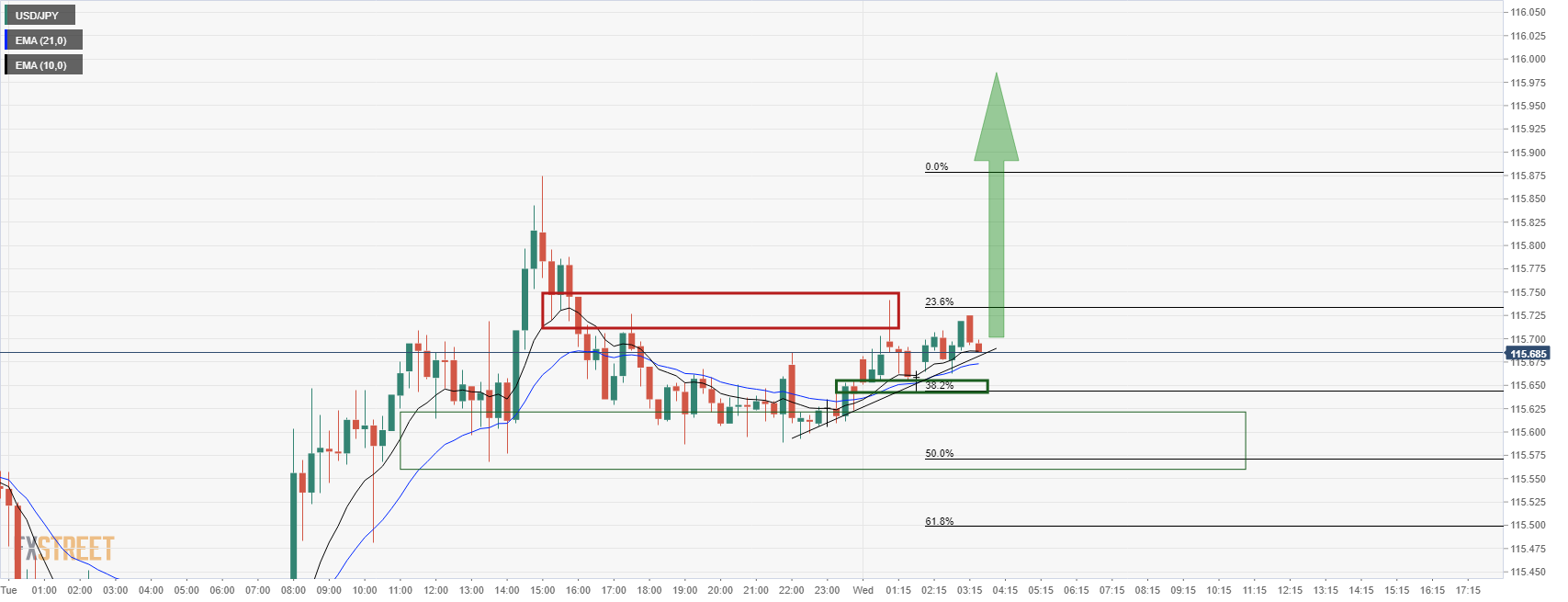
(USD/JPY M15 chart)
The Russian defence ministry on Tuesday published footage to demonstrate it was returning some troops to base after exercises, however, US President Joe Biden said the United States had not verified the move. Russia’s claim that it pulled back troops “would be good, but we have not yet verified that,” Biden said. “Indeed, our analysts indicate that they remain very much in a threatening position.”
Biden also said the United States is "not seeking direct confrontation with Russia" but that if Russia were to attack Americans in Ukraine, "We will respond forcefully." Nevertheless, risk appetite had already improved in New York trade and Biden's hawkish rhetoric did little to sway the consensus in markets that diplomacy can prevail.
Shares around the world rebounded following the reports, MSCI's gauge of global equities ended higher by 1.34%. US stocks snapped a three-day losing streak and the S&P 500 gained 1.6% to 4,471.07, the Nasdaq Composite added 2.5% to 14,139.76 and the Dow Jones Industrial Average leapt 1.2% to 34,988.84. Asian shares rallied also with Japan's benchmark Nikkei share average was up 2.0% midday Wednesday while the broader Topix climbed 1.43% to 1,942.16.
Looking ahead, markets can take comfort that Putin said he does not want war and would rely on negotiations in his efforts to eliminate any chance that Ukraine could one day join NATO. However, at the same time, he has not committed to a full pullback of troops. Putin warns that Russia’s next moves in the standoff will depend on how the situation evolves.
Ukraine has also expressed scepticism about Russia’s statements of a pullback. “We won’t believe when we hear, we’ll believe when we see. When we see troops pulling out, we’ll believe in de-escalation,” Ukrainian Foreign Minister Dmytro Kuleba said.
NATO Secretary-General Jens Stoltenberg said that “so far, we have not seen ... any signs of reduced Russian military presence on the borders of Ukraine,” adding that the alliance wants to see a “significant and enduring withdrawal” of forces, troops and heavy equipment.
US president Biden said, “let there be no doubt: If Russia commits this breach by invading Ukraine, responsible nations around the world will not hesitate to respond.''
European markets will be acting on headlines related intelligence that may or may not show any actual evidence of a reduction of Russian military presence on the borders of Ukraine, the latter a catalyst for yet further risk-off.
- EUR/USD pares the biggest daily gains in two weeks.
- ECB's Schnabel sounds hawkish but not as much as Fedspeak, US data came in mixed.
- Market’s cautious optimism weighs on yields but USD buyers stay hopeful.
- Headlines from Russia, Eurozone Industrial Production also need attention for clear guide.
EUR/USD takes offers to refresh daily low near 1.1345, down 0.11% intraday, as the pair traders consolidate the heaviest daily jump in a fortnight during Wednesday’s Asian session.
The major currency pair sellers seem to respect the market’s cautious optimism while tracking the latest developments surrounding Russia, as well as mixed concerns over the US Federal Reserve’s (Fed) next move.
In doing so, the quote ignores upbeat comments from European Central Bank (ECB) Executive Board Member Isabel Schnabel, published on Financial Times (FT) during the late Tuesday. The policymakers said, per FT, “The risk of acting too late has increased." On the same line were fears of higher inflation raised by the ECB’s Economic Bulletin.
The reason could be linked to the escalating odds of the Fed’s 0.50% rate hike in March, as well as firmer US inflation expectations portrayed by the 10-year breakeven inflation rate per the St. Louis Federal Reserve (FRED) data. That said, the BOE FedWatch Tool signals around 60% probabilities of 50 basis points (bps) of rate lift in March but the Reuters’ poll highlights the indecision. “The US Federal Reserve will kick off its tightening cycle in March with a 25-basis-point interest rate rise, but a growing minority say it will opt for a more aggressive half-point move to tamp down inflation,” said Reuters.
The latest US data, however, came in mixed as the US Producer Price Index (PPI) data showed a hot factory-gate inflation figure supporting the Fed’s rate-hike concerns. That said, the PPI rose past 9.1% YoY expectations to 9.7%, versus upwardly revised 9.8% prior, in January whereas the Producer Price Index ex Food & Energy, also known as Core PPI, rallied to 8.3% versus 7.9% market consensus. Additionally, NY Empire State Manufacturing Index eased below 12.15 forecasts to 3.1, compared to -0.7 previous readouts.
Elsewhere, hopes of no further escalation in the Russia-Ukraine tussles, after Moscow rolled back some of its troops from borders, seem to weigh on the US Treasury yields. However, the US stock futures struggle to follow the Wall Street benchmarks’ gains. It should be noted that the US Dollar Index (DXY) defends the 96.00 threshold despite downbeat yields, mainly due to the market's anxiety.
Looking forward, Eurozone Industrial Production for December, expected 0.3% MoM versus 2.3% prior, will offer immediate clues ahead of the January Retail Sales from the US, expected to reverse -1.9% previous contraction with +2.0% growth. Also important will be the Federal Open Market Committee (FOMC) Minutes as traders jostle over 0.50% rate-hike clues.
Read: FOMC Minutes Preview: Dollar selling opportunity? Doves set for a comeback after hawkish meeting
Technical analysis
Failures to print a clear daily closing beyond the 50-day EMA, around 1.1355 by the press time, favor EUR/USD sellers to aim for multiple support levels around 1.1280.
Japan's Finance Minister Shun'ichi Suzuki has stated that FX moves are partly behind recent rises in Japan prices, but driven mostly by rising global fuel costs.
He added that ''if prices rise before household income, wages increase, that could hurt consumption.
The Finance Minister stated also that the government is taking steps to curb gasoline, fuel prices will take steps as needed to address the impact rising prices could have on the economy.
There has been no reaction in the yen that is otherwise under pressure from an improved risk profile in financial markets pertaining to the prospects of de-escalation surrounding Russia's presence of troops on the Ukraine border.
Japan's chief cabinet secretary Matsuno, whoever, said earlier that they are still watching the Ukraine situation with grave concern despite the announcement of partial withdrawal of Russian armed forces.
USD/JPY update
As per the early Asia analysis below, the bulls are taking control in Asia and eye a run to test 116 the figure for the sessions ahead.
USD/JPY prior analysis M15 chart
-
USD/JPY Price Analysis: Bids building above 115.50's puts 116.00 and then 117.00 on the radar
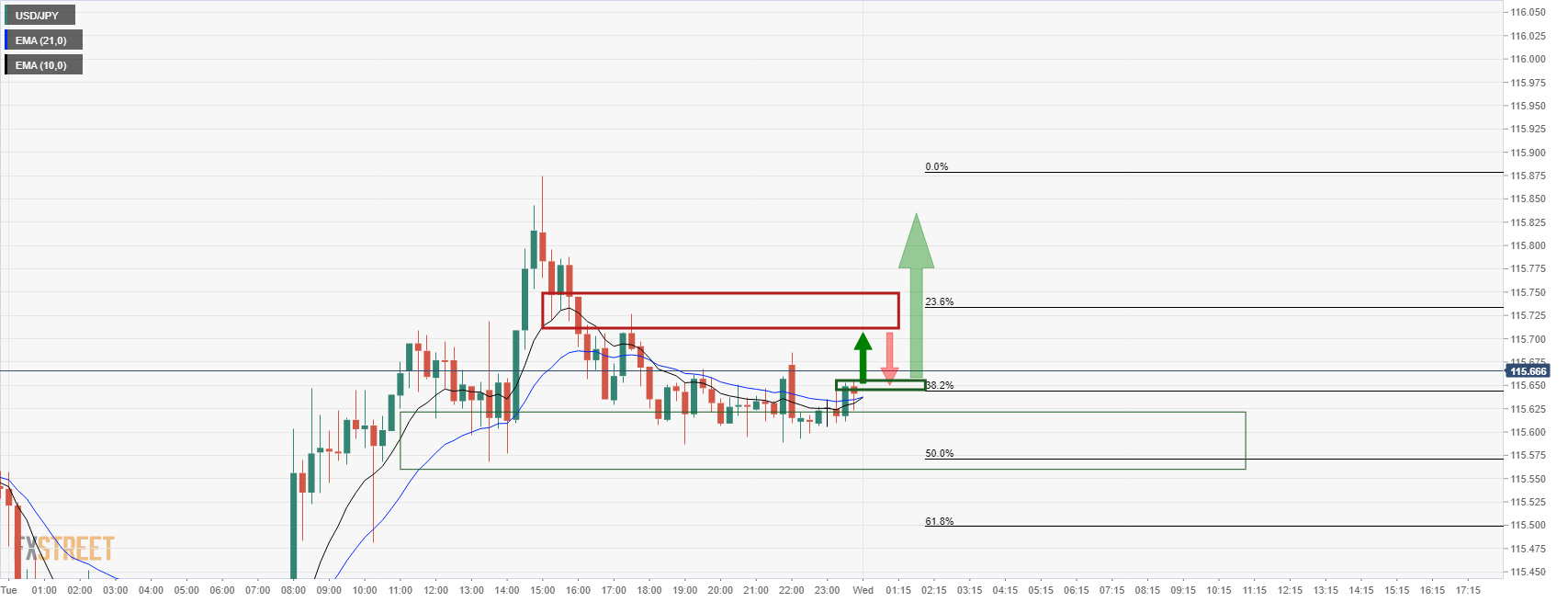
USD/JPY live market, M15 chart
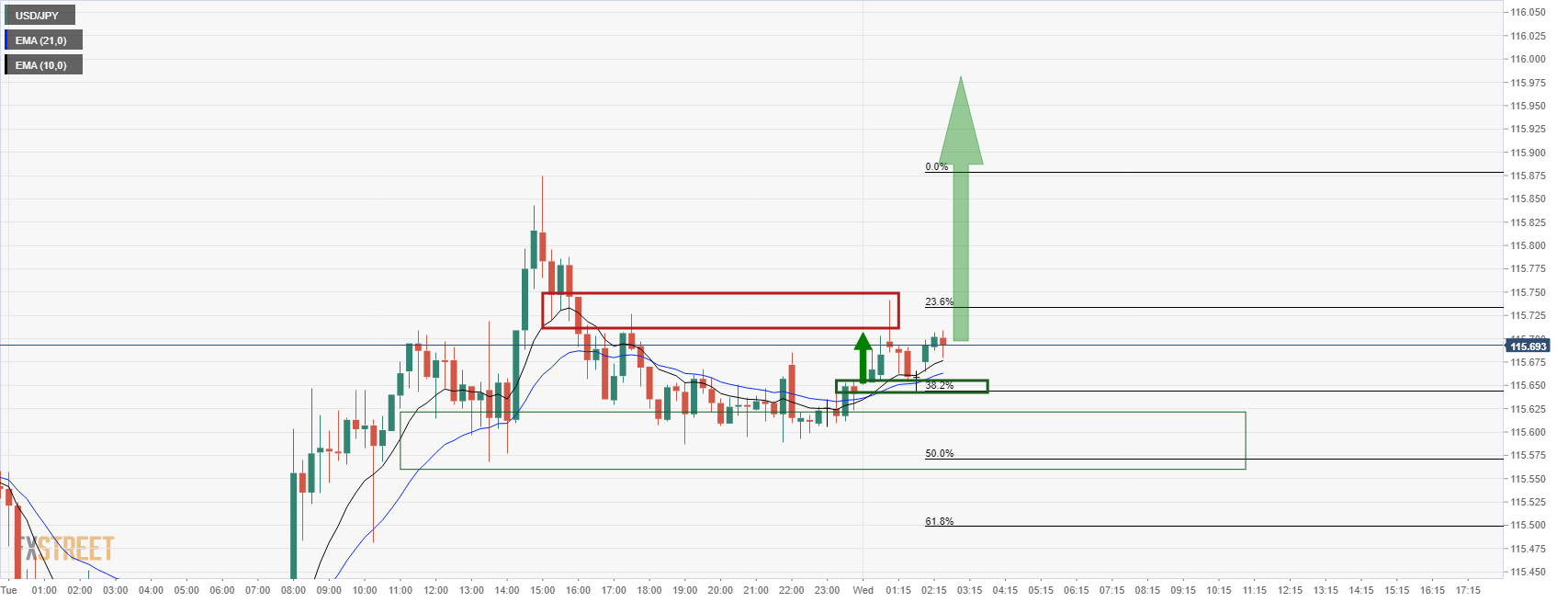
The price is respecting the support on the 15-min chart and bulls are moving in on an important level of resistance in the 115.70's again.
- AUD/USD picks up bids to refresh intraday high, extends previous day’s rebound from weekly low.
- China CPI missed market consensus, prior in January, PPI falls to slowest in seven months.
- Market sentiment dwindles amid mixed concerns over Russia, anxiety ahead of US Retail Sales, FOMC Minutes.
AUD/USD holds onto the previous day’s recovery moves from a one-week low while taking the bids to renew intraday high around 0.7160, up 0.13% on a day, amid Wednesday’s Asian session.
In doing so, the Aussie pair cheers the hopes of no further escalation in the Russia-Ukraine tussles after Moscow rolled back some of its troops from borders, while also ignoring China inflation data.
It’s worth noting that comments from Russian President Vladimir Putin and his US counterpart Joe Biden keep the geopolitical risk on the table. That said, Russia’s Putin conveyed dissatisfaction with how negations are going over Ukraine’s NATO membership while US President Biden said, “Russian attack on Ukraine still very much a possibility.”
China’s headline Consumer Price Index (CPI) missed 1.0% YoY forecasts with 0.9% mark, versus 1.5% prior. Further, the Producer Price Index (PPI) also declined to 9.1% YoY compared to 9.5% market consensus and 10.3% prior.
Read: Breaking: Chinese inflation miss pressures AUD/USD, bulls now rely on risk appetite returning
Given the downbeat China inflation figures, hopes that the People’s Bank of China (PBOC) will keep fueling markets seem to have underpinned the Asia-Pacific equities of late, in addition to Russia-linked headlines. However, the US 10-year Treasury yields and stock futures remain on the back foot by the press time.
Other than the mixed updates from Russia and downbeat China data, cautious mood ahead of January Retail Sales from the US and Federal Open Market Committee (FOMC) Minutes also should test AUD/USD bulls.
Read: FOMC Minutes Preview: Dollar selling opportunity? Doves set for a comeback after hawkish meeting
Technical analysis
AUD/USD keeps the bounce off the 38.2% Fibonacci retracement (Fibo.) of January 13-28 downturn, around 0.7100, amid firmer MACD signals and a steady RSI line.
However, the Aussie pair remains below the previous support line from January 28, around 0.7185, which in turn suggests that buyers remain cautious below the stated hurdle. Also acting as an immediate upside hurdle is the convergence of the 50-DMA and a descending trend line from January 20, close to 0.7170.
| Raw materials | Closed | Change, % |
|---|---|---|
| Brent | 93.28 | -2.61 |
| Silver | 23.36 | -2.11 |
| Gold | 1853.31 | -0.93 |
| Palladium | 2249.75 | -4.85 |
- DXY picks up bids to consolidate the heaviest daily fall in two weeks.
- 50-DMA, 21-DMA and 50% Fibonacci retracement limit immediate downside.
- Bulls may aim for 96.50 hurdle as MACD backs the rebound.
US Dollar Index (DXY) defend 96.00 during a sluggish Asian session on Wednesday.
The greenback gauge dropped the most since February 03 the previous day but convergence on the 21-DMA and 50-DMA restricted the quote’s further downside. Also challenging the DXY bears is the 50% Fibonacci retracement (Fibo.) January’s upside.
It’s worth noting that the MACD teases bulls of late, which in turn suggests the continuation of the latest rebound.
However, a six-week-old horizontal area surrounding 96.50 will be a tough nut to crack for the US Dollar Index bulls, a break of which will escalate the run-up towards the previous month’s peak of 97.44.
During the run-up, the 97.00 threshold will act as an intermediate halt.
On the flip side, 61.8% Fibo. level near 95.70 acts as immediate support to watch during the quote’s clear declines past-96.00.
Following that, the monthly low of 95.13 and 2022 bottom surrounding 94.62 will gain the US Dollar Index bears’ attention.
DXY: Daily chart
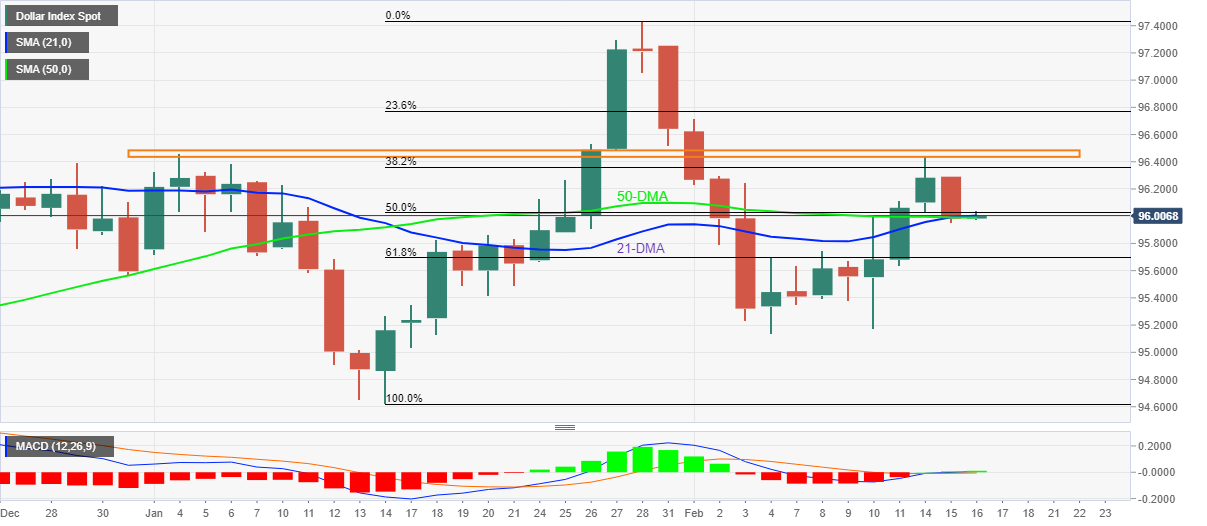
Trend: Further recovery expected
Analysts at Nomura suggest a 50-basis point rate hike at the March 15-16 Federal Open Market Committee (FOMC) monetary policy meeting while offering their view on the US dollar.
Key quotes
"We expect a 50bp rate hike from the Fed at its March FOMC meeting, and 47bp is already priced in with nearly seven hikes overall for this year alone."
"We've been biased to long USD positions for quite some time, but now the upside to USD is becoming more limited from a rates perspective.”
You could also argue that 54bp for this year is too much for the ECB's pricing too. But the key difference is that EGB yields are finally turning positive and this is a regime change for EUR flows and with it could see EUR climb higher."
Read: FOMC Minutes Preview: Dollar selling opportunity? Doves set for a comeback after hawkish meeting
- NZD/USD refreshes intraday low, consolidates the previous day’s bounce off weekly bottom.
- China CPI, PPI both dropped below market forecasts and prior readings in January.
- Sour sentiment also weighs on the Kiwi pair amid mixed concerns over Russia.
- Cautious mood ahead of FOMC Minutes, US Retail Sales also challenge pair buyers.
NZD/USD pares recent gains by refreshing intraday low around 0.6630 on downbeat China data during Wednesday’s Asian session.
The Kiwi pair bounced off an eight-day low on Tuesday as market sentiment improved. However, mixed concerns over Russia, cautious sentiment ahead of the key US data/events and downbeat inflation figures from the key customer weigh on the quote of late.
That said, China’s headline Consumer Price Index (CPI) missed 1.0% YoY forecasts with 0.9% mark, versus 1.5% prior. Further, the Producer Price Index (PPI) also declined to 9.1% YoY compared to 9.5% market consensus and 10.3% prior.
Read: Breaking: Chinese inflation miss pressures AUD/USD, bulls now rely on risk appitite returning
Elsewhere, the previous optimism surrounding the Russia-Ukraine war seems to fade as comments from Russian President Vladimir Putin and his US counterpart Joe Biden keep the geopolitical risk on the table. That said, Russia’s Putin conveyed dissatisfaction with how negations are going over Ukraine’s NATO membership while US President Biden said, “Russian attack on Ukraine still very much a possibility.”
Additionally, escalating concerns over Fed’s rate-hike ahead of today’s US Retail Sales and Federal Open Market Committee (FOMC) Minutes also challenge NZD/USD traders. It’s worth noting that the US Producer Price Index (PPI) data showed a hot factory-gate inflation figure supporting the Fed’s rate-hike concerns on Tuesday. That said, the PPI rose past 9.1% YoY expectations to 9.7%, versus upwardly revised 9.8% prior, in January whereas the Producer Price Index ex Food & Energy, also known as Core PPI, rallied to 8.3% versus 7.9% market consensus. Additionally, NY Empire State Manufacturing Index eased below 12.15 forecasts to 3.1, compared to -0.7 previous readouts.
Considering the data, the latest Reuters poll said, “Recently, a Reuters poll said, “The US Federal Reserve will kick off its tightening cycle in March with a 25-basis-point interest rate rise, a Reuters poll of economists found, but a growing minority say it will opt for a more aggressive half-point move to tamp down inflation.”
While portraying the mood, the US 10-year Treasury yields and stock futures remain on the back foot by the press time.
Given the market’s anxiety and downbeat China data, NZD/USD may witness further downside. However, it all depends upon the risk catalysts and Fed Minutes.
Read: FOMC Minutes Preview: Dollar selling opportunity? Doves set for a comeback after hawkish meeting
Technical analysis
Unless crossing the previous support line from late January, around 0.6690, NZD/USD traders can keep targeting 2022 low of 0.6529. That said, the 21-DMA level of 0.6652 guards the quote’s immediate upside.
The Consumer Price Index is released by the National Bureau of Statistics of China has arrived lower than expected and is pressures AUD a touch, off by some 5 pips so far:
China CPI
China CPI (YoY) Jan: 0.9% (est 1.0%, prev 1.5%)
China PPI
China PPI (YoY) Jan: 9.1% (est 9.5%, prev 10.3%) .
AUD/USD update
The AUD/USD bulls have not got what they were looking for in this data, but Wall Street ended sharply higher on Tuesday, as signs of de-escalating tensions along the Russia-Ukraine border sparked a risk-on session. This in turn spread to the high beta currencies such as the Australian dollar.
-
AUD/USD Price Analysis: Chinese CPI anticipated, but may not be what the bulls are hoping for
Moreover, inflation concerns are a global paradox that is likely to underpin the commodity sector for which AUD trades as a proxy and can benefit. The Reserve bank of Australia is also tipped toeing around the edge of hawkishness and tightening expectations remain elevated. All of which supports a meanwhile bullish outlook for AUD crosses.
AUD/USD 4-hour chart
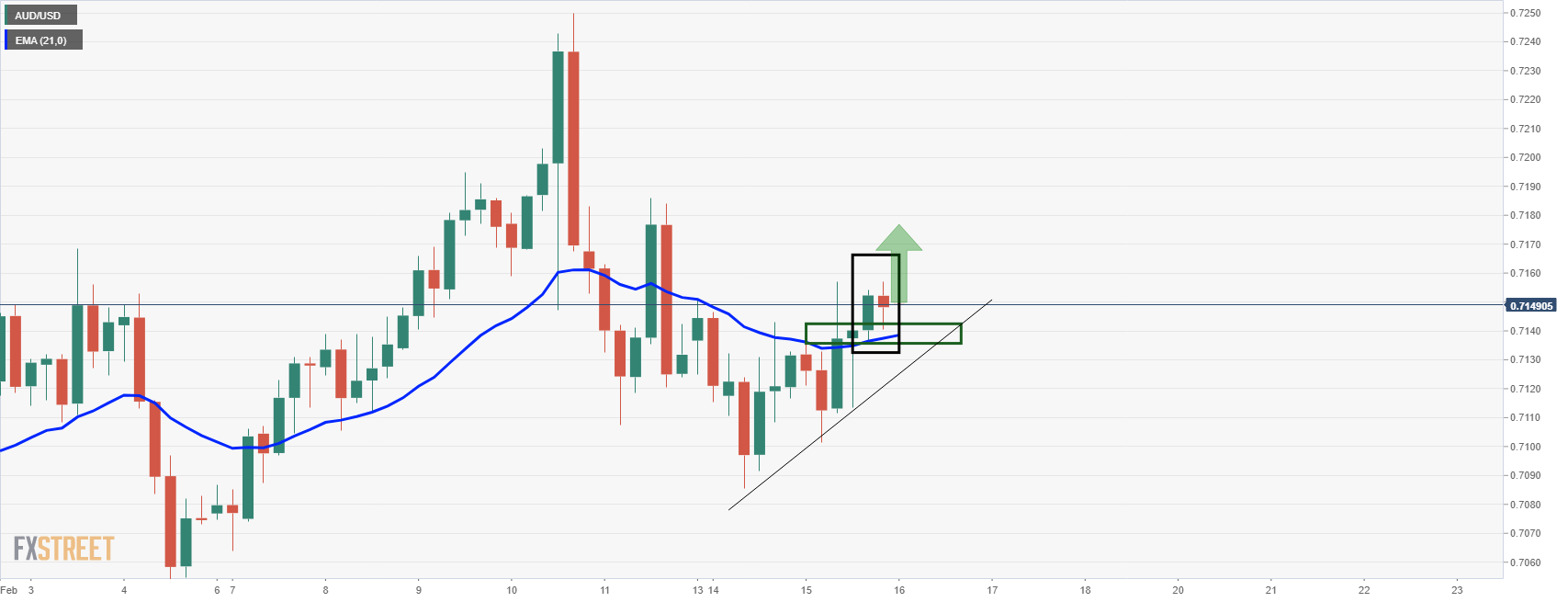
About the Consumer Price Index
The Consumer Price Index is released by the National Bureau of Statistics of China. It is a measure of retail price variations within a representative basket of goods and services. The result is a comprehensive summary of the results extracted from the urban consumer price index and rural consumer price index. The purchase power of the CNY is dragged down by inflation. The CPI is a key indicator to measure inflation and changes in purchasing trends. A substantial consumer price index increase would indicate that inflation has become a destabilizing factor in the economy, potentially prompting The People’s Bank of China to tighten monetary policy and fiscal policy risk. Generally speaking, a high reading is seen as positive (or bullish) for the CNY, while a low reading is seen as negative (or Bearish) for the CNY.
| Time | Country | Event | Period | Previous value | Forecast |
|---|---|---|---|---|---|
| 01:30 (GMT) | China | PPI y/y | January | 10.3% | 9.5% |
| 01:30 (GMT) | China | CPI y/y | January | 1.5% | 1% |
| 04:30 (GMT) | Japan | Tertiary Industry Index | December | 0.4% | |
| 07:00 (GMT) | United Kingdom | Retail Price Index, m/m | January | 1.1% | -0.4% |
| 07:00 (GMT) | United Kingdom | Producer Price Index - Input (MoM) | January | -0.2% | 0.9% |
| 07:00 (GMT) | United Kingdom | Producer Price Index - Input (YoY) | January | 13.5% | 13.1% |
| 07:00 (GMT) | United Kingdom | Producer Price Index - Output (YoY) | January | 9.3% | 9.1% |
| 07:00 (GMT) | United Kingdom | Producer Price Index - Output (MoM) | January | 0.3% | 0.6% |
| 07:00 (GMT) | United Kingdom | Retail prices, Y/Y | January | 7.5% | 7.5% |
| 07:00 (GMT) | United Kingdom | HICP ex EFAT, Y/Y | January | 4.2% | |
| 07:00 (GMT) | United Kingdom | HICP, m/m | January | 0.5% | -0.2% |
| 07:00 (GMT) | United Kingdom | HICP, Y/Y | January | 5.4% | 5.4% |
| 10:00 (GMT) | Eurozone | Industrial Production (YoY) | December | -1.5% | -0.5% |
| 10:00 (GMT) | Eurozone | Industrial production, (MoM) | December | 2.3% | 0.3% |
| 13:30 (GMT) | Canada | Wholesale Sales, m/m | December | 3.5% | 0% |
| 13:30 (GMT) | Canada | Manufacturing Shipments (MoM) | December | 2.6% | 0.6% |
| 13:30 (GMT) | U.S. | Retail Sales YoY | January | 16.9% | |
| 13:30 (GMT) | U.S. | Retail sales excluding auto | January | -2.3% | 0.8% |
| 13:30 (GMT) | U.S. | Retail sales | January | -1.9% | 2% |
| 13:30 (GMT) | U.S. | Import Price Index | January | -0.2% | 1.3% |
| 13:30 (GMT) | Canada | Consumer Price Index m / m | January | -0.1% | 0.6% |
| 13:30 (GMT) | Canada | Bank of Canada Consumer Price Index Core, y/y | January | 4% | |
| 13:30 (GMT) | Canada | Consumer price index, y/y | January | 4.8% | 4.8% |
| 14:15 (GMT) | U.S. | Capacity Utilization | January | 76.5% | 76.8% |
| 14:15 (GMT) | U.S. | Industrial Production YoY | January | 3.7% | |
| 14:15 (GMT) | U.S. | Industrial Production (MoM) | January | -0.1% | 0.4% |
| 15:00 (GMT) | U.S. | NAHB Housing Market Index | February | 83 | 83 |
| 15:00 (GMT) | U.S. | Business inventories | December | 1.3% | 2.1% |
| 15:30 (GMT) | U.S. | Crude Oil Inventories | February | -4.756 | -1.572 |
| 19:00 (GMT) | U.S. | FOMC meeting minutes | |||
| 23:50 (GMT) | Japan | Core Machinery Orders | December | 3.4% | -1.8% |
| 23:50 (GMT) | Japan | Core Machinery Orders, y/y | December | 11.6% | 0.6% |
| 23:50 (GMT) | Japan | Trade Balance Total, bln | January | -582.4 | -1607 |
- GBP/USD holds onto the previous day’s recovery moves, sidelined of late.
- Brexit, UK politics challenge bulls but downbeat sentiment and a pause in USD rebound keep buyers hopeful.
- UK jobs report flashed warnings to BOE, February inflation data will be crucial amid hawkish hopes for March.
- US Retail Sales for February, FOMC Minutes and Russia-Ukraine headlines are important too.
GBP/USD grinds higher around 1.3545-50 during Wednesday’s Asian session, following a bounce off a fortnight low.
In doing so, the cable pair cheers the softer USD and easing fears over the Russia-Ukraine tussles. However, mixed headlines and cautious mood ahead of the key UK Consumer Price Index (CPI) data test the pair buyers of late.
The US Dollar Index (DXY) reversed from a two-week high the previous day on news that Russia called back some of its troops from borders near Ukraine. However, However, comments from Russian President Vladimir Putin and his US counterpart Joe Biden keep the geopolitical risk on the table and challenge the market’s optimism, despite getting lesser attention. That said, Russia’s Putin conveyed dissatisfaction with how negations are going over Ukraine’s NATO membership while US President Biden said, “Russian attack on Ukraine still very much a possibility.”
Elsewhere, the latest UK jobs report suggests a sustained recovery in employment while also pushing the Bank of England (BOE) towards a stronger battle with inflation. “Britain's labor market is flashing some warning signs for a central bank on guard against a wage-inflation spiral, economists said on Tuesday after official data showed a shrinking workforce and record levels of vacancies,” said Reuters.
Read: UK Unemployment Rate steadies at 4.1% in December vs. 4.1% expected
It’s worth noting that a huge jump in the trade between Ireland and Northern Ireland joins the comments from the former European Union Chief Negotiator Michel Barnier to challenge GBP/USD buyers. “UK Prime Minister Boris Johnson must respect every aspect of the Brexit withdrawal agreements,” said Barnier per CNBC.
On the other hand, the Financial Times (FT) mentions that Boris Johnson’s allies claim he can avoid fine over ‘partygate’ scandal, which in turn keeps the pair buyers hopeful.
Talking about the US data, the US Producer Price Index (PPI) data showed a hot factory-gate inflation figure supporting the Fed’s rate-hike concerns. That said, the PPI rose past 9.1% YoY expectations to 9.7%, versus upwardly revised 9.8% prior, in January whereas the Producer Price Index ex Food & Energy, also known as Core PPI, rallied to 8.3% versus 7.9% market consensus. Additionally, NY Empire State Manufacturing Index eased below 12.15 forecasts to 3.1, compared to -0.7 previous readouts.
Against this backdrop, the US 10-year Treasury yields rose 4.7 basis points (bps) to 2.043% whereas the Wall Street benchmarks also closed positive by the end of Tuesday’s North American session. That said, the US Treasury yields and stock futures remain on the back foot by the press time.
Looking forward, the UK Consumer Price Index (CPI) for January, expected to remain unchanged at around 5.4% YoY, will be crucial as the BOE is on the rate-hike trajectory. As a result, a firmer print will propel the GBP/USD pair’s upside. Following the data, , major attention will be given to January Retail Sales from the US and Federal Open Market Committee (FOMC) Minutes amid chatters of a 0.50% rate lift in March, not to forget Russia headlines.
Read: FOMC Minutes Preview: Dollar selling opportunity? Doves set for a comeback after hawkish meeting
Technical analysis
Although a one-month-old resistance line restricts short-term GBP/USD upside around 1.3560, bears may not risk entries until witnessing a clear downside break of the 100-DMA level surrounding 1.3500.
In recent trade today, the People’s Bank of China (PBOC) set the yuan (CNY) at 6.3463 vs. estimate at 6.3492 and last close of 6.3388.
About the fix
China maintains strict control of the yuan’s rate on the mainland.
The onshore yuan (CNY) differs from the offshore one (CNH) in trading restrictions, this last one is not as tightly controlled.
Each morning, the People’s Bank of China (PBOC) sets a so-called daily midpoint fix, based on the yuan’s previous day closing level and quotations taken from the inter-bank dealer.
- AUD/USD is firming from 4-hour support ahead of Chinese inflation data.
- The bulls will be looking for a discount at this juncture.
- Further demand could be on the cards in the coming sessions with eyes on 0.72 the figure.
As per the New York analysis from Tuesday's session, AUD/USD Price Analysis: Bulls looking for a break to test 0.7180 H4 resistance, where the 21-EMA was cited as a key support area, the bulls will be looking to Chinese data for a lift at the top of the hour. However, there are expectations of the data to emain weak in January despite intense supply-side pressures.
''CPI will be dampened by another drop in pork prices, capping overall food price inflation, as well as a high base. Industrial commodities, steel and oil prices continued to push higher over the month, while PMI input prices rose to their highest since October, suggesting any moderation in PPI will be limited,'' analysts at TD Securities argued.
Nevertheless, AUD/USD is breaking to the upside with the price holding above H4 21-EMA. This is seen as an encouraging development for the bulls ahead of the data. Eyes will be on 0.7180s and then 0.73 the figure as a critical milestone in the pursuit of a higher daily high.
AUD/USD prior analysis

AUD/USD live market

The price has respected the 21 EMA and support structure as illustrated above and bulls will be seeking to engage at a discount at this juncture.
AUD/USD weekly chart
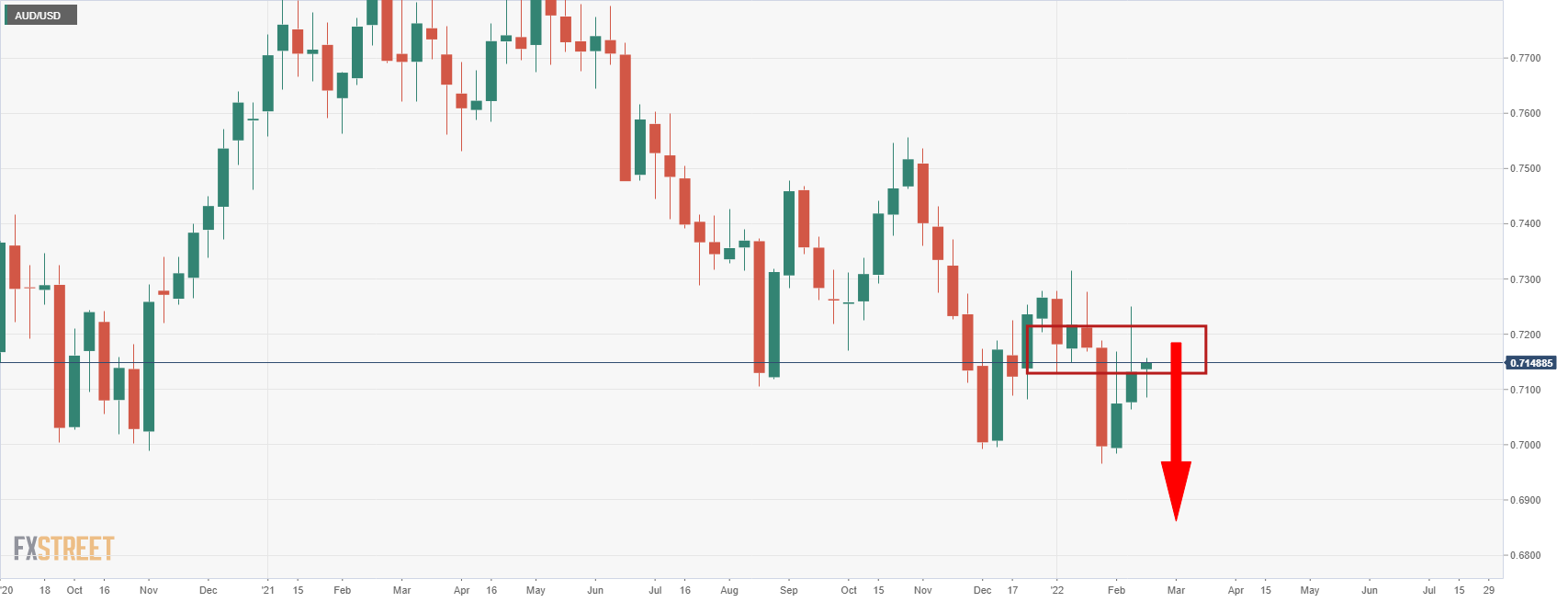
On the other hand, the bears will note the weekly chart's resistance and bulls will need to overcome this near 0.7180.
- Silver consolidates the biggest daily fall in three weeks.
- 100-DMA, fortnight-old support line restricts short-term declines amid firmer MACD.
- 61.8% Fibonacci retracement, 200-DMA act as strong resistances.
Silver (XAG/USD) prices remain sidelined around $23.35-40 during a quiet Asian session on Wednesday.
In doing so, the bright metal keeps the previous day’s bounce off the 100-DMA and ascending support line from February 03 amid the bullish MACD signals.
However, a daily closing beyond the 61.8% Fibonacci retracement (Fibo.) of November-December downside, around $23.90, will be crucial to convince the buyers.
Also challenging the XAG/USD upside is the 200-DMA level surrounding $24.30, a break of which will challenge January’s high of $24.70.
Alternatively, a daily closing below the 100-DMA and support line’s convergence, near $23.25, will convince silver sellers to attach the $23.00 threshold.
Following that, $22.60 and the monthly low of $22.00 may entertain XAG/USD bears ahead of directing them to the late 2021 trough close to $21.40.
Silver: Daily chart
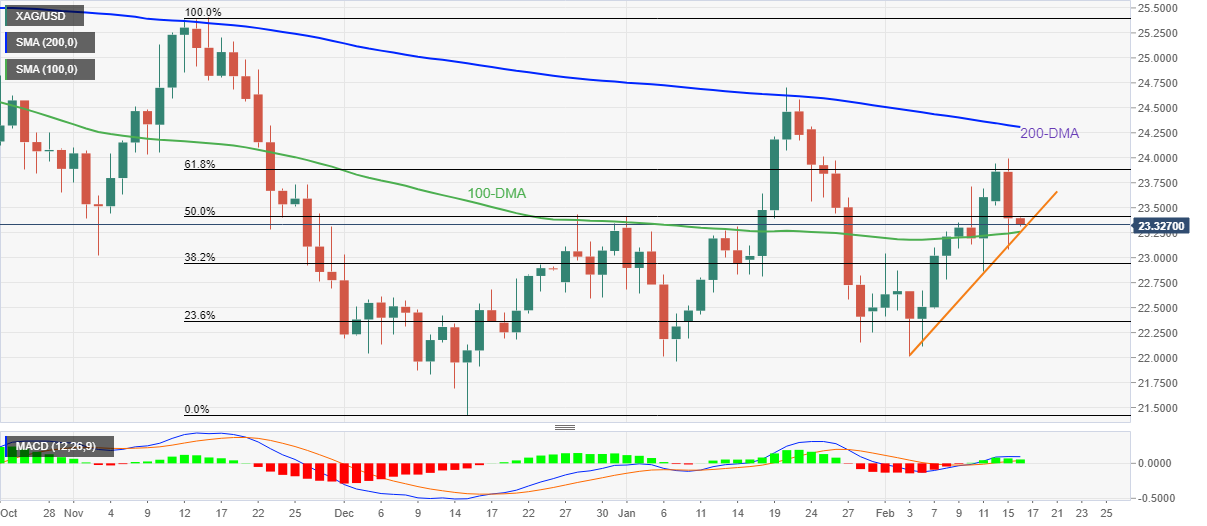
Trend: Further recovery expected
“The US Federal Reserve will kick off its tightening cycle in March with a 25-basis-point interest rate rise,” said the latest Reuters poll of economists.
The survey results, however, also mentioned, “But a growing minority say it will opt for a more aggressive half-point move to tamp down inflation,”
Key quotes
Now that the economy has recovered its pre-pandemic level, all 84 respondents in a Reuters poll taken Feb. 7-15 expected the Fed to raise the federal funds rate by at least 25 basis points at its upcoming March 15-16 meeting.
Almost a quarter of those respondents, 20, forecast a 50-basis-point move to 0.50-0.75% following debate in markets over the past week after Fed officials discussed the merits of such a move. Rate futures are pricing in more than a 50% likelihood of a half-point hike.
Rates were forecast to rise each quarter this year to reach 1.25-1.50% by end-December, roughly where they were at the start of the pandemic two years ago. One-quarter of respondents, 21 of 84, saw rates even higher by end-2022.
The poll concluded the Fed would start by cutting $60 billion per month from its portfolio with predictions in a $20 billion to $100 billion range, according to the median of 27 responses to an additional question.
Respondents put both the terminal rate and their estimated neutral rate at the same level, 2.25% to 2.50%, according to median forecasts from additional questions.
Read: FOMC Minutes Preview: Dollar selling opportunity? Doves set for a comeback after hawkish meeting
- WTI picks up bids to reverse the previous day’s downside move.
- Market sentiment dwindles amid indecision over Russia-Ukraine conditions, ahead of key data/events.
- API inventory levels improved, EIA stockpiles also bear upbeat forecasts.
- China CPI, US Retail Sales and FOMC Minutes also decorate calendar.
WTI crude oil prices recover to $90.50 amid Wednesday’s Asian session, having witnessed the heaviest daily fall since early December 2021 the previous day.
The black gold dropped the previous day amid easing fears of an imminent war between Russia and Ukraine after headlines conveying the retreat of some troops from borders by Moscow. However, comments from Russian President Vladimir Putin and his US counterpart Joe Biden keep the geopolitical risk on the table and challenge the market’s optimism, despite getting lesser attention. That said, Russia’s Putin conveyed dissatisfaction with how negations are going over Ukraine’s NATO membership while US President Biden said, “Russian attack on Ukraine still very much a possibility.”
It’s worth noting that downbeat weekly inventory data from the American Petroleum Institute (API) also weighed on the commodity prices the previous day. As per the latest data, API Weekly Crude Oil Stock improved to -1.076M versus -2.025M prior during the week ended on February 11. It’s worth noting that the official stockpile figures by the US Energy Information Administration (EIA) are up for publishing at 15:30 GMT on Wednesday. Forecasts suggest the weekly inventories to ease from -4.756M to -1.769M.
Other than the Russian headlines and inventories, US Retails Sales for January and Federal Open Market Committee (FOMC) Minutes will also be watched closely amid chatters of 0.50% rate hike by the Fed. Recently, a Reuters poll said, “The US Federal Reserve will kick off its tightening cycle in March with a 25-basis-point interest rate rise, a Reuters poll of economists found, but a growing minority say it will opt for a more aggressive half-point move to tamp down inflation.”
That said, China’s headline inflation data for January, namely Consumer Price Index (CPI) and Producer Price Index (PPI), should also be watched carefully for immediate directions. Forecasts suggest the CPI will ease to 1.0% YoY from 1.5% whereas the PPI may drop to 9.5% versus 10.3% previous reading.
Technical analysis
WTI pulled back from a seven-month-old resistance line, around $93.80 by the press time, amid overbought RSI conditions. However, an upward sloping trend line from January 03 challenges the oil bears around the $90.00 threshold.
- Bulls engage for prospects to 116 the figure and 117 thereafter.
- Bullish tendencies are present across the time frames.
USD/JPY has been building a bullish case since the end of January. For the first trading days of the week, we have seen a series of semi bullish closes following a sharp correction of the start of February's rally: USD/JPY Price Analysis: Bulls are engaging and eye a break of 115 the figure. The demand that is building above 115.50 gives rise to the prospects of a bullish continuation as follows:
USD/JPY daily chart
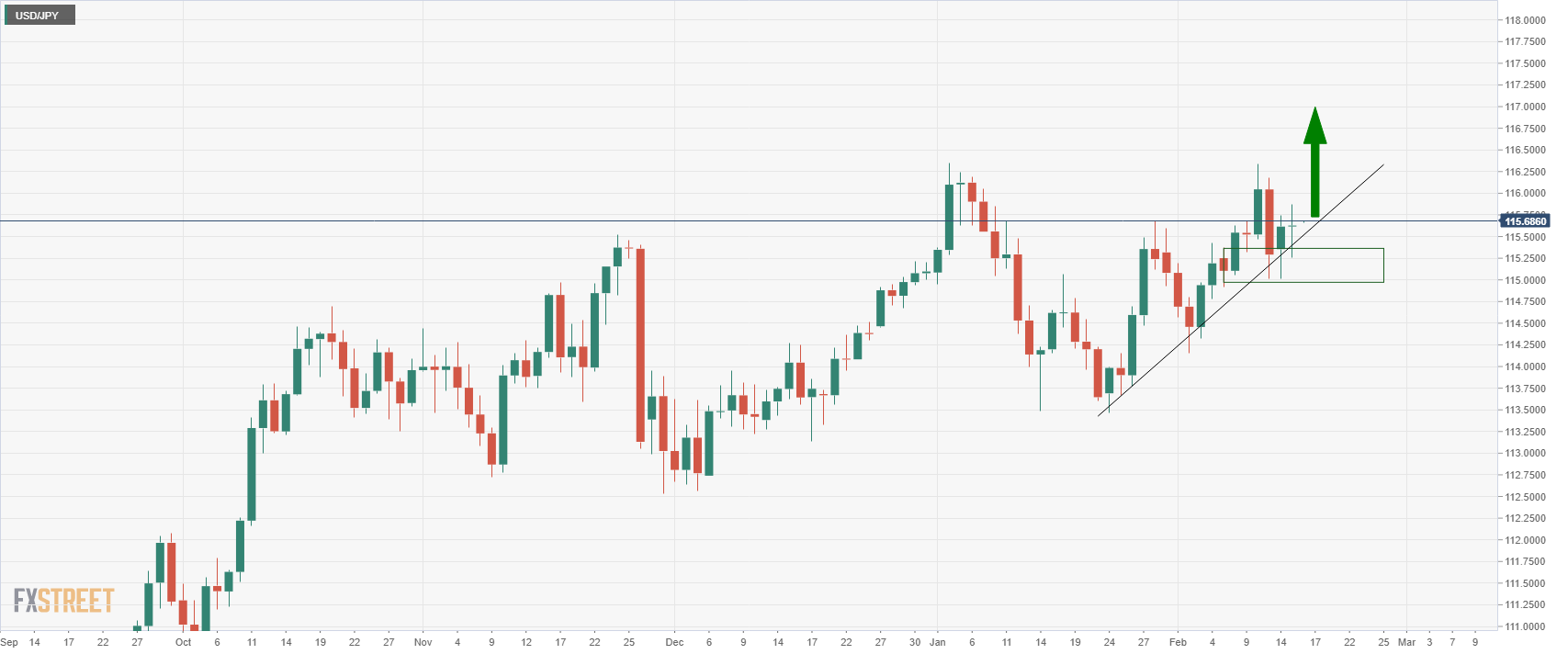
The daily chart shows that the price has pulled back into an area of the structure that would be expected to support and encourage buyers at a discount to the daily highs. 117.00 is on the radar.
USD/JPY H4 chart

The four-hour chart offers a close up of the same scenario.
USD/JPY H1 chart
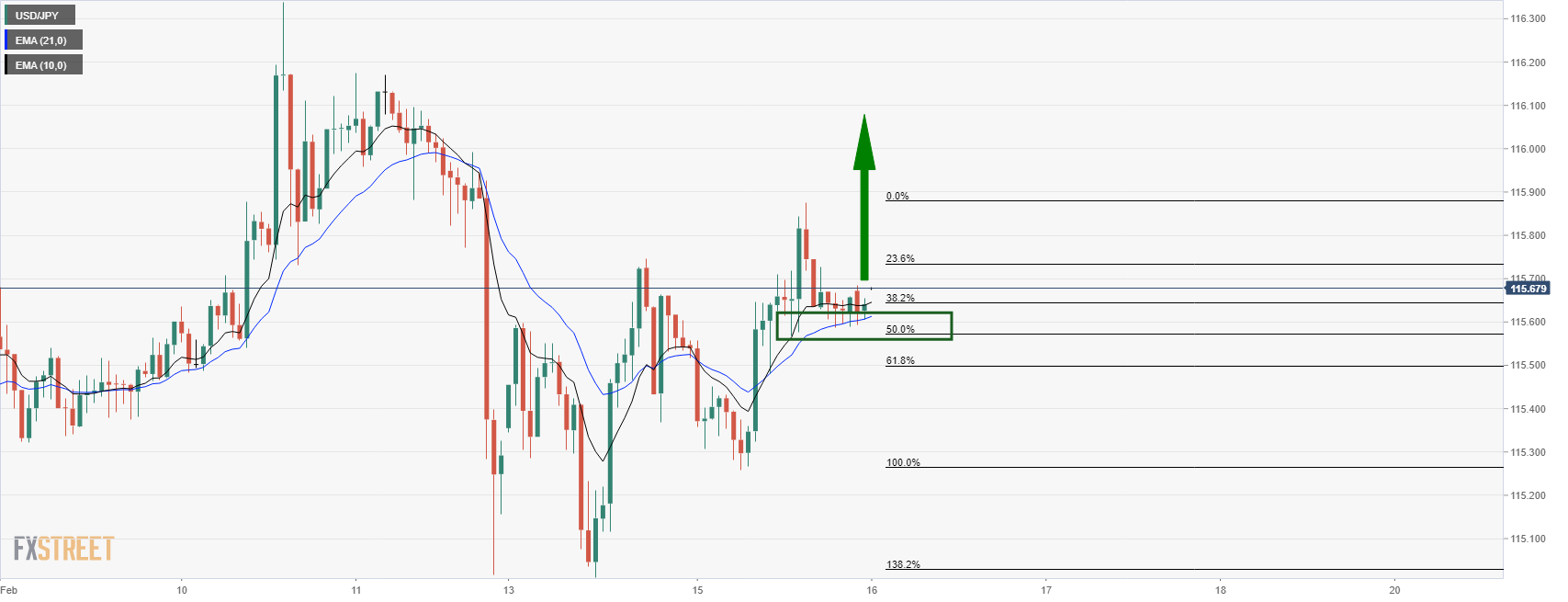
The hourly chart zooms in on a fractal basis and shows a bullish relationship between the 21 and 10 EMAs.
USD/JPY M15 chart
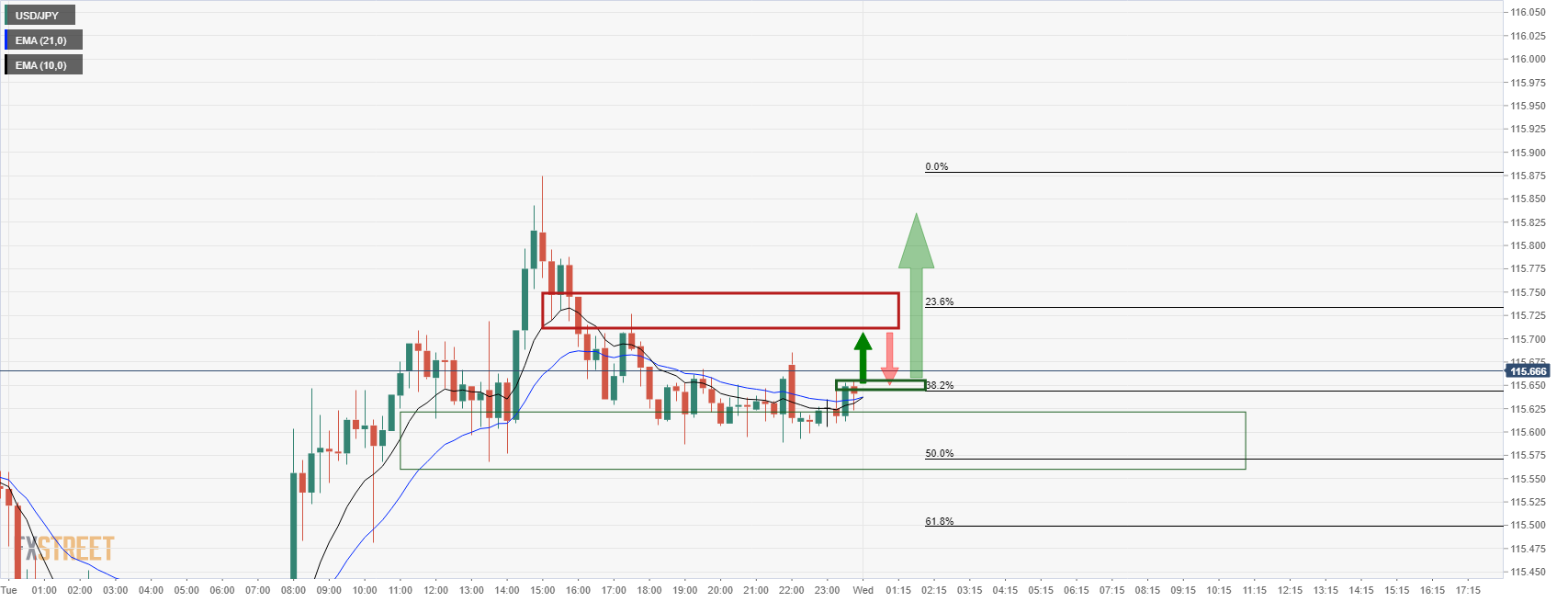
The 15-min chart is a mirror image and the above scenario forecasts where support of the EMAs meeting prior highs could act as a support should the price break higher. This is where further buying activity could result in a fresh bullish impulse to target towards 116 the figure for the coming sessions.
| Pare | Closed | Change, % |
|---|---|---|
| AUDUSD | 0.71528 | 0.41 |
| EURJPY | 131.317 | 0.56 |
| EURUSD | 1.13587 | 0.49 |
| GBPJPY | 156.555 | 0.21 |
| GBPUSD | 1.35427 | 0.15 |
| NZDUSD | 0.66406 | 0.41 |
| USDCAD | 1.27156 | -0.08 |
| USDCHF | 0.92512 | 0.12 |
| USDJPY | 115.601 | 0.06 |
- AUD/JPY bulls take a breather after two-day uptrend inside bearish chart pattern.
- MACD line teases bear cross, 200-HMA adds to the downside filters.
- Buyers need validation from 83.00 to keep reins.
AUD/JPY picks up bids to refresh weekly top around 82.70 during Wednesday’s Asian session.
Even so, the cross-currency pair seesaws around the 100-HMA while staying inside a rising wedge bearish chart formation established since Monday.
In addition to the rising wedge and lack of movement around the short-term key moving average, the receding bullish bias of MACD also teases the sellers. That said, the MACD line is crossing the signal line from upside, which in turn suggests the pair’s weakness.
During the quote’s downside, the 200-HMA level of 82.40 may offer an intermediate halt to AUD/JPY sellers before directing them to the stated wedge’s support line, near 82.25.
It’s worth mentioning, however, that the pair’s weakness past 82.25 will make it vulnerable to challenge the monthly low near 81.30.
Meanwhile, recovery moves need to cross the bearish chart pattern’s upper line, around 82.90, to lure AUD/JPY buyers.
Following that, the 83.00 threshold and February 11 swing high near 83.25 should return to the charts ahead of highlighting the monthly peak near 84.00 for the bulls.
AUD/JPY: Hourly chart

Trend: Pullback expected
© 2000-2024. All rights reserved.
This site is managed by Teletrade D.J. LLC 2351 LLC 2022 (Euro House, Richmond Hill Road, Kingstown, VC0100, St. Vincent and the Grenadines).
The information on this website is for informational purposes only and does not constitute any investment advice.
The company does not serve or provide services to customers who are residents of the US, Canada, Iran, The Democratic People's Republic of Korea, Yemen and FATF blacklisted countries.
Making transactions on financial markets with marginal financial instruments opens up wide possibilities and allows investors who are willing to take risks to earn high profits, carrying a potentially high risk of losses at the same time. Therefore you should responsibly approach the issue of choosing the appropriate investment strategy, taking the available resources into account, before starting trading.
Use of the information: full or partial use of materials from this website must always be referenced to TeleTrade as the source of information. Use of the materials on the Internet must be accompanied by a hyperlink to teletrade.org. Automatic import of materials and information from this website is prohibited.
Please contact our PR department if you have any questions or need assistance at pr@teletrade.global.















